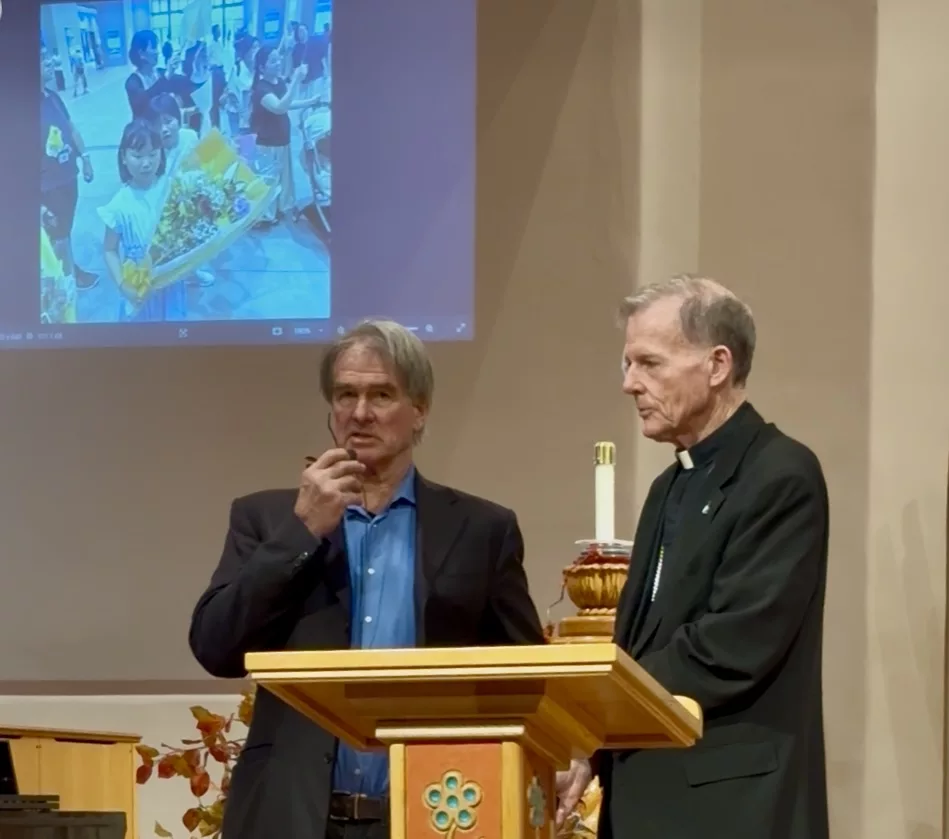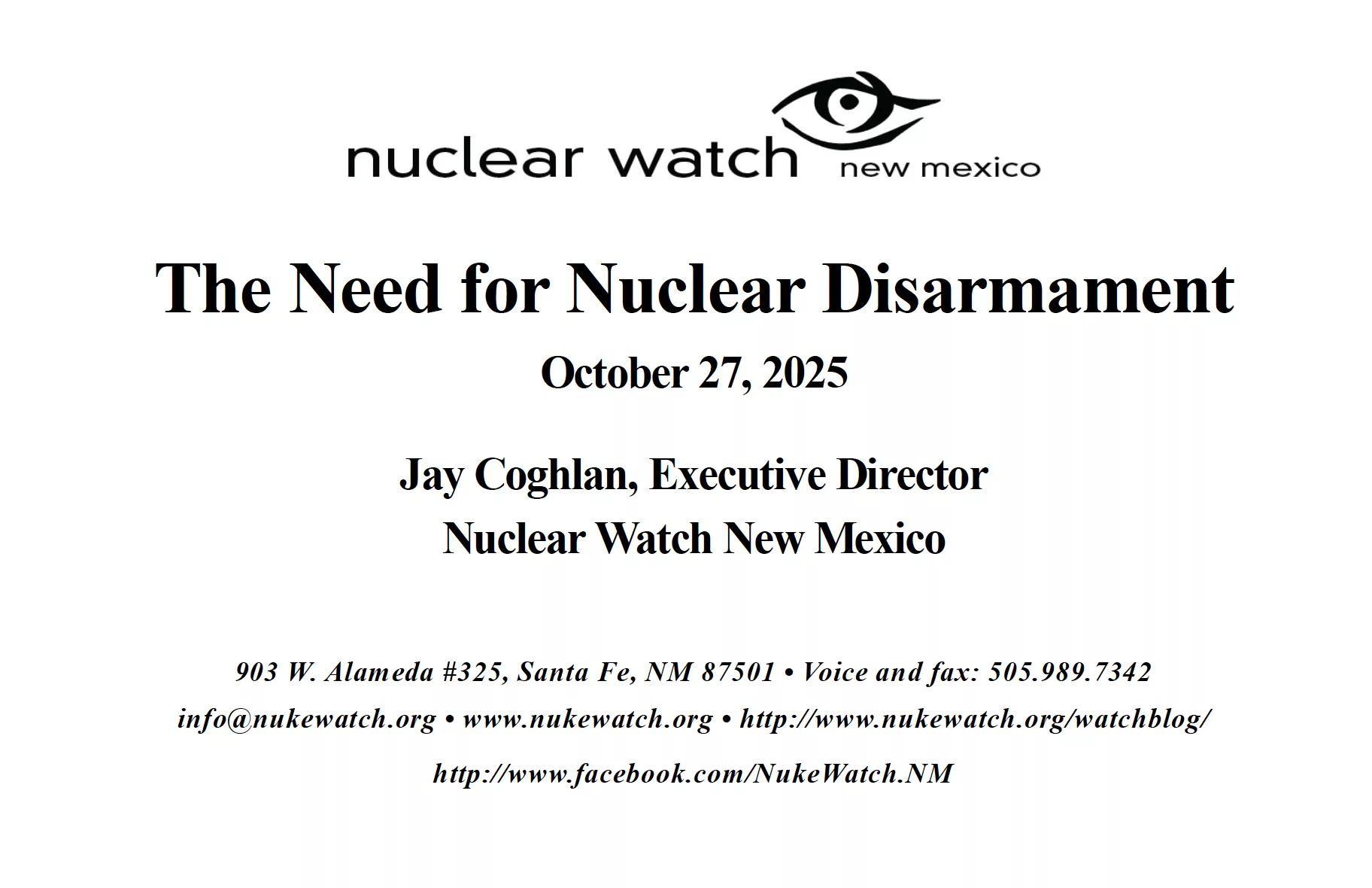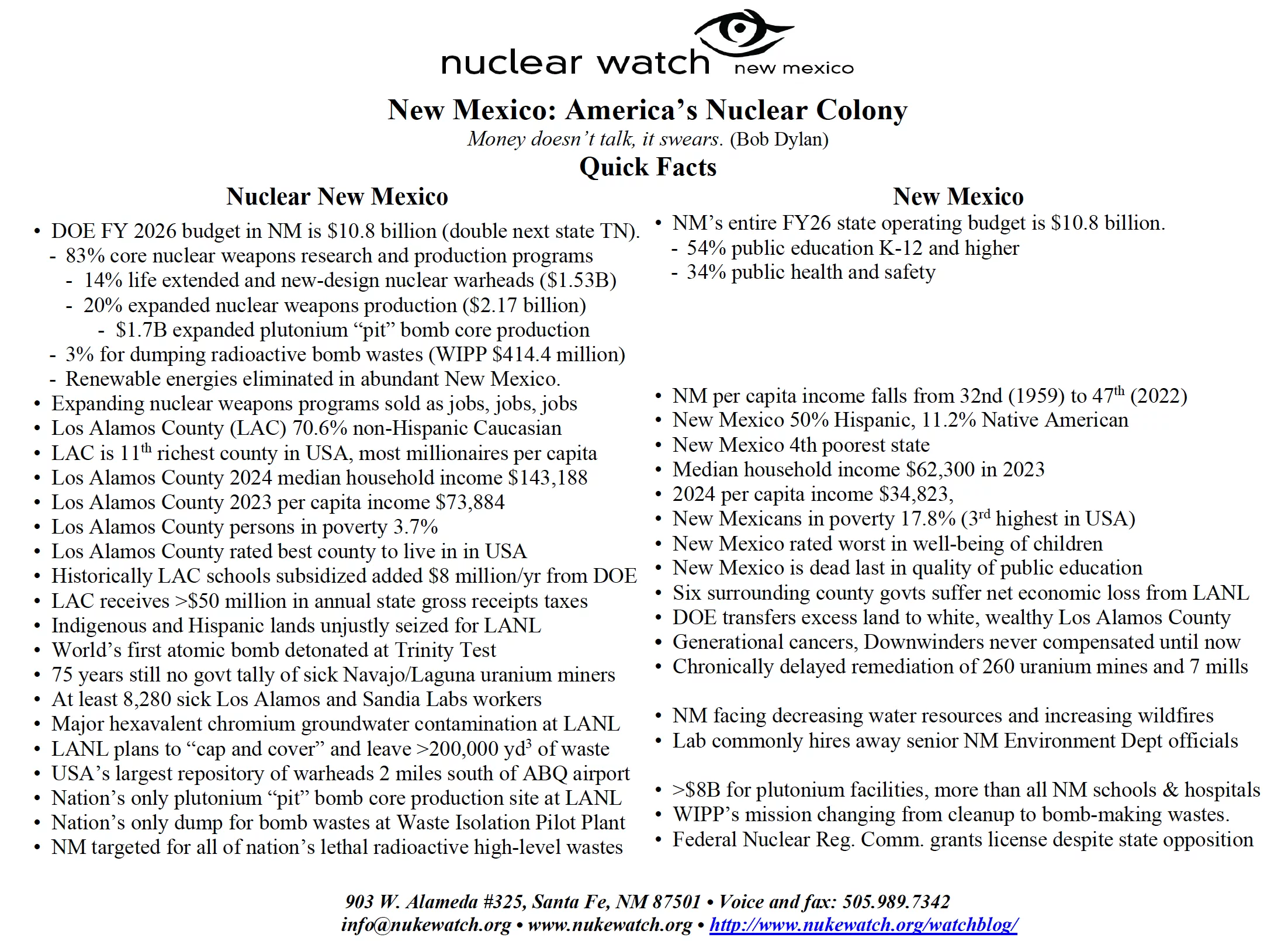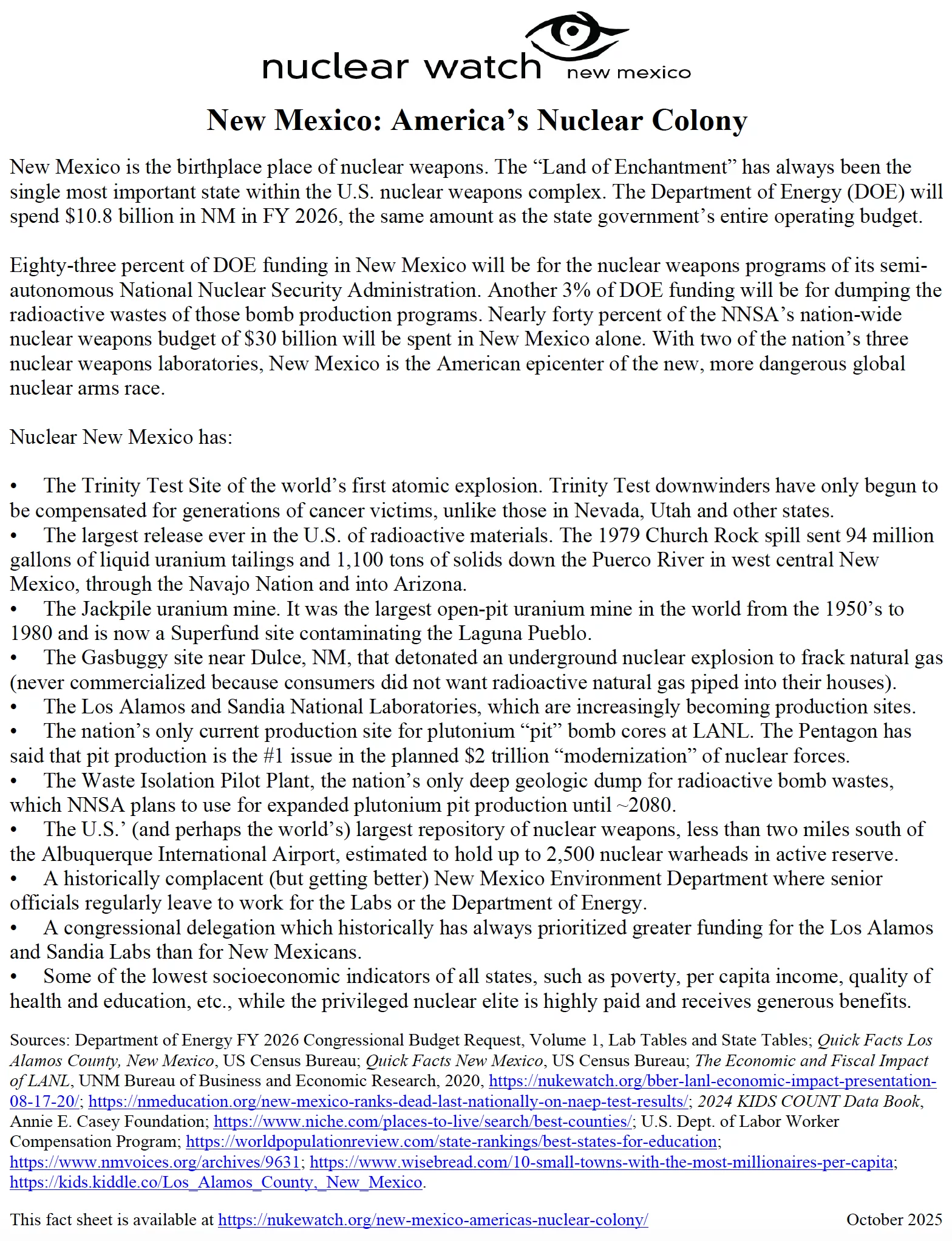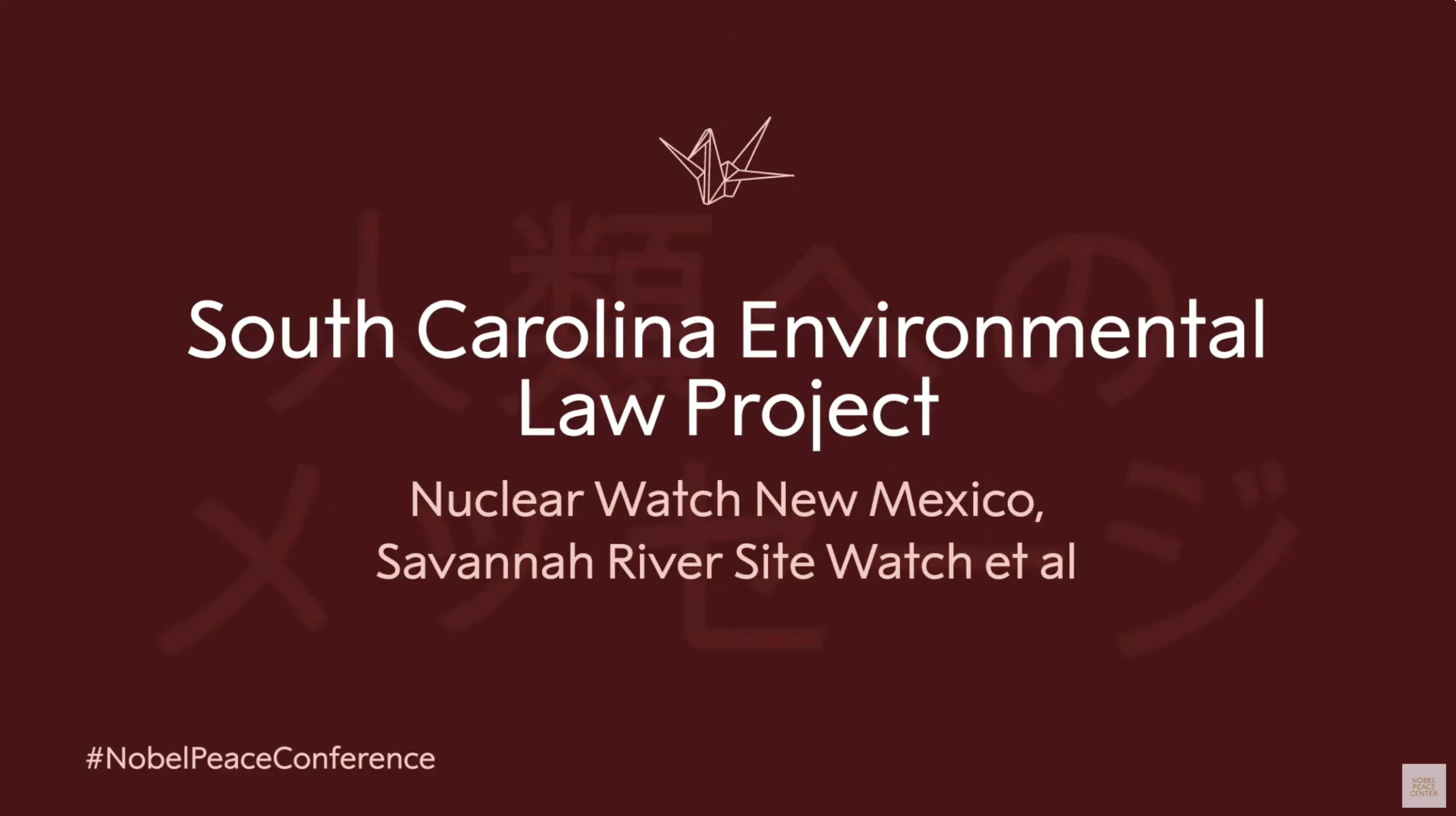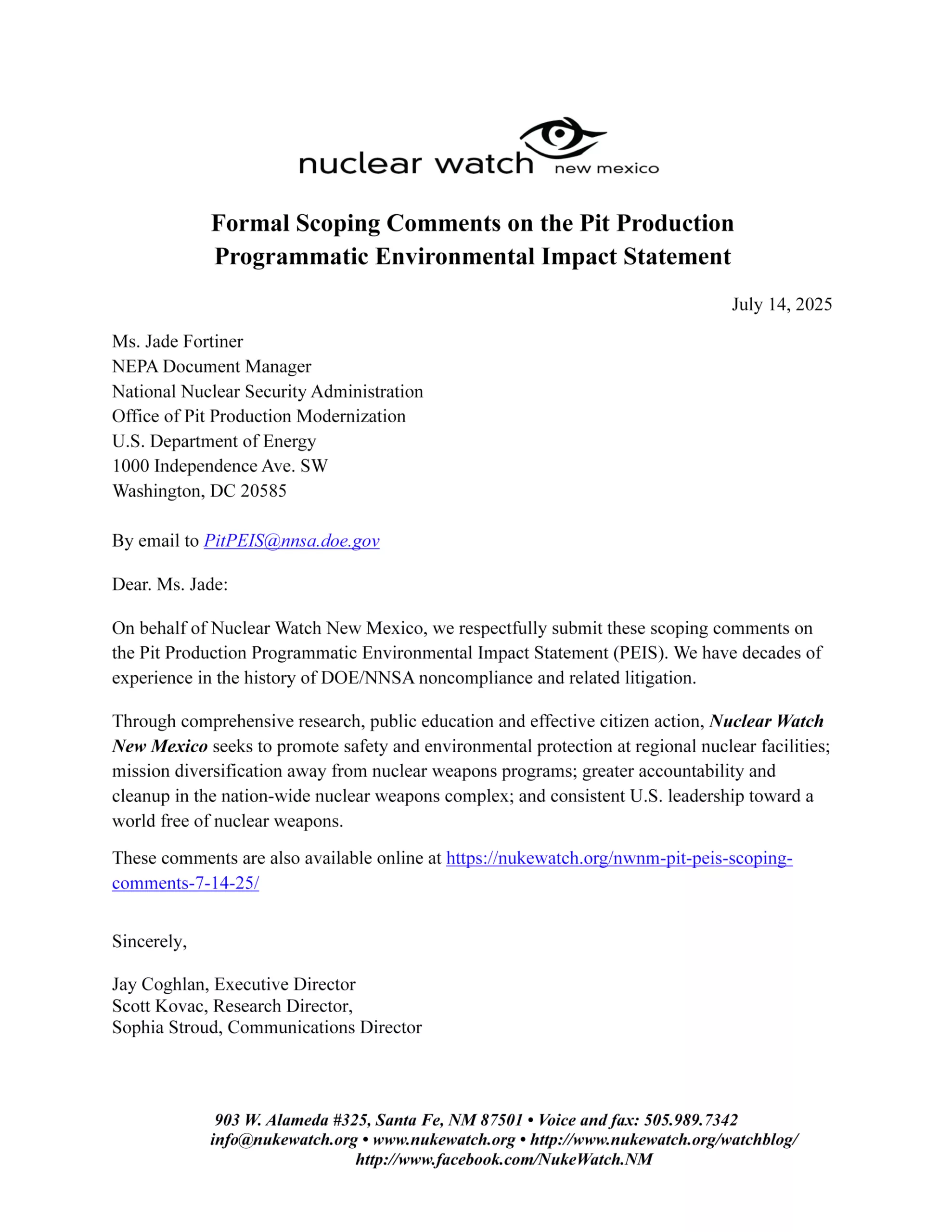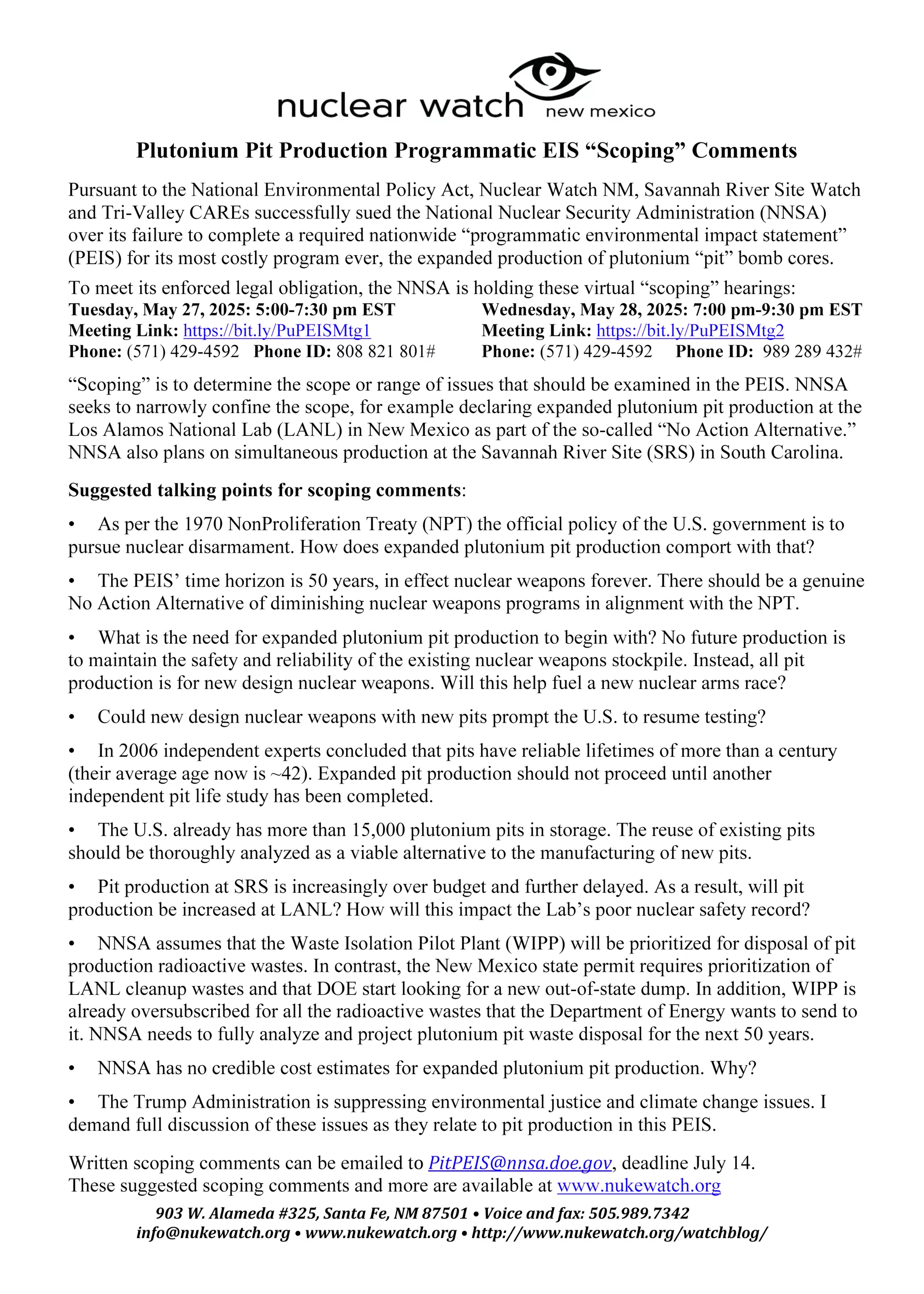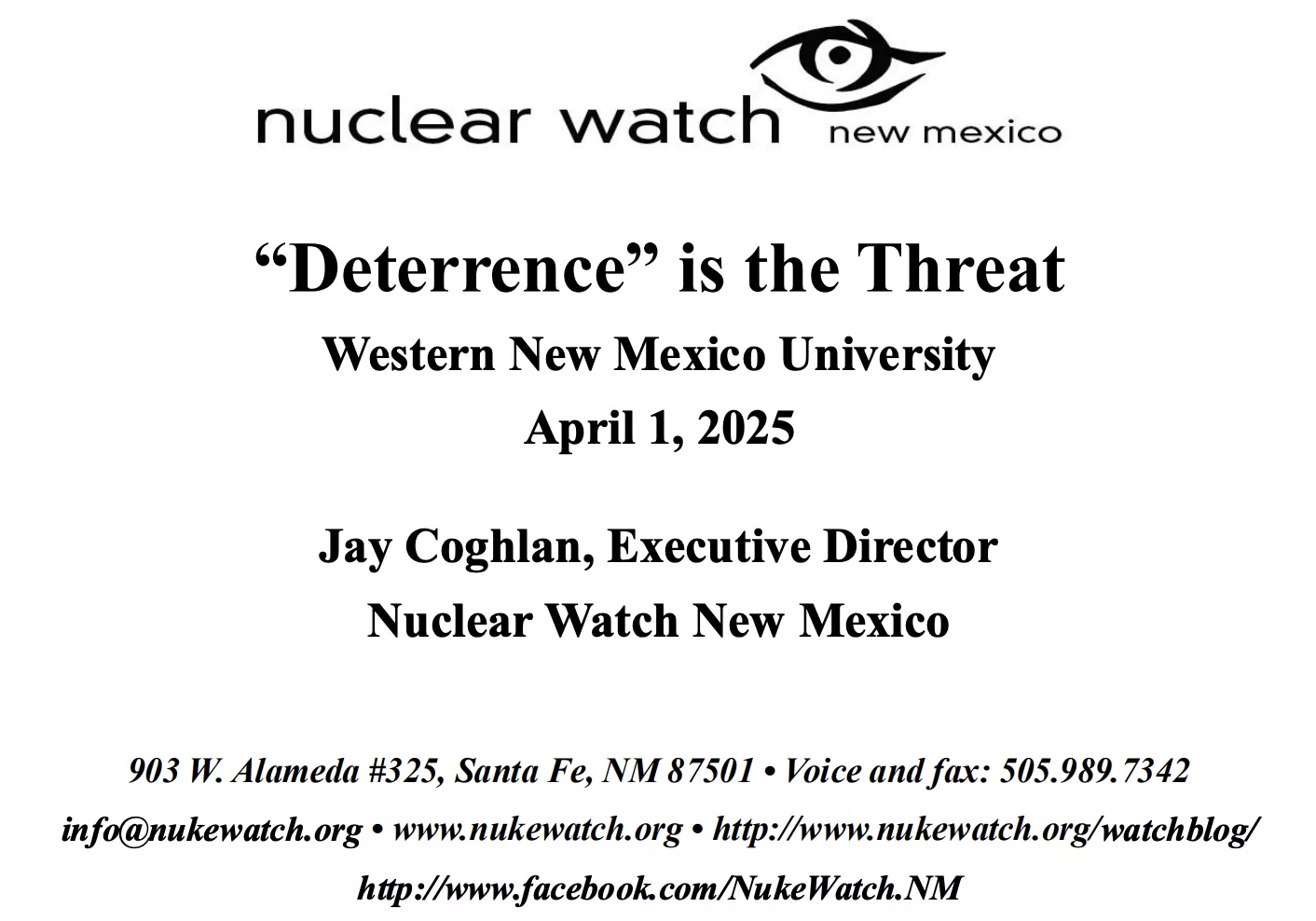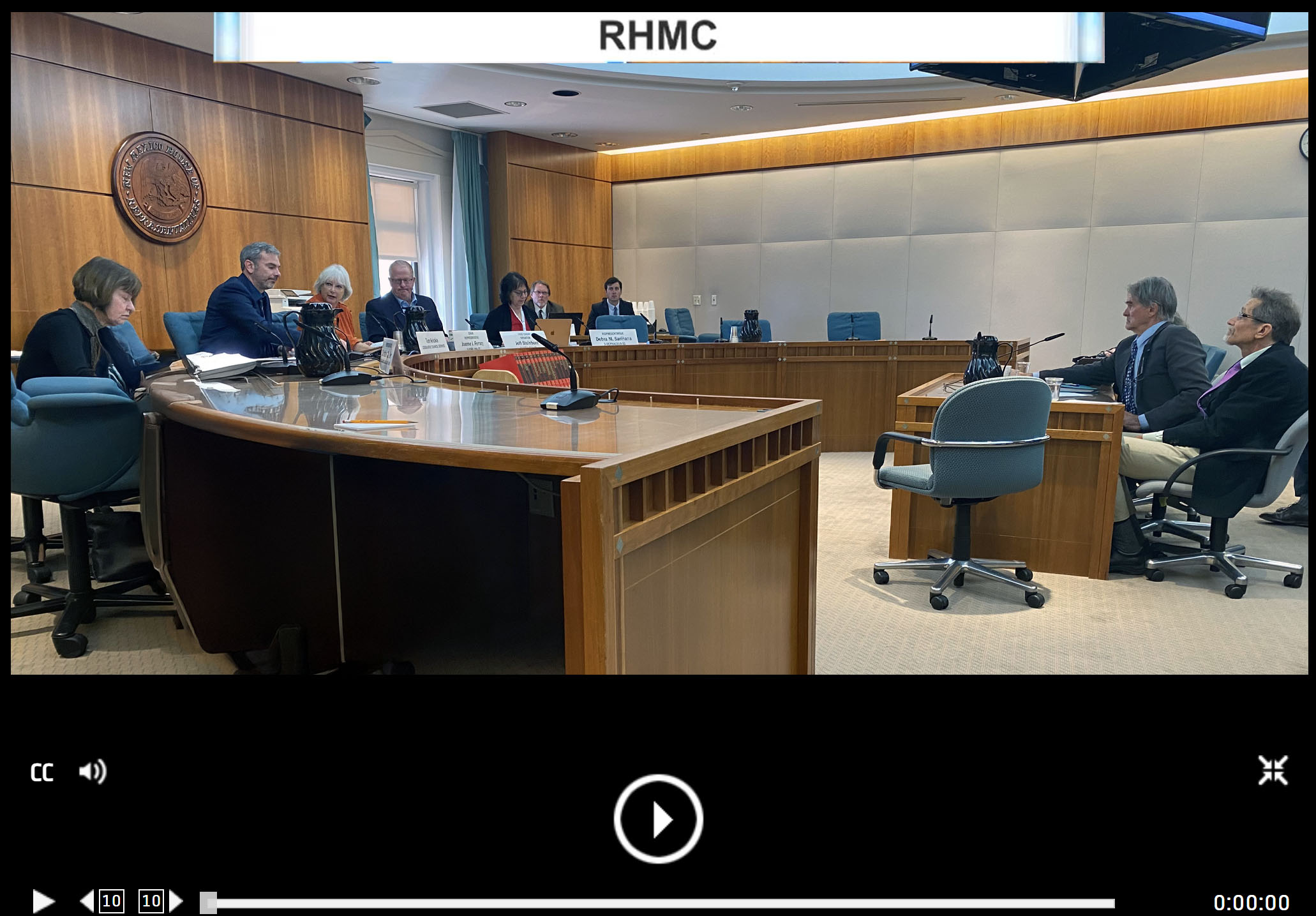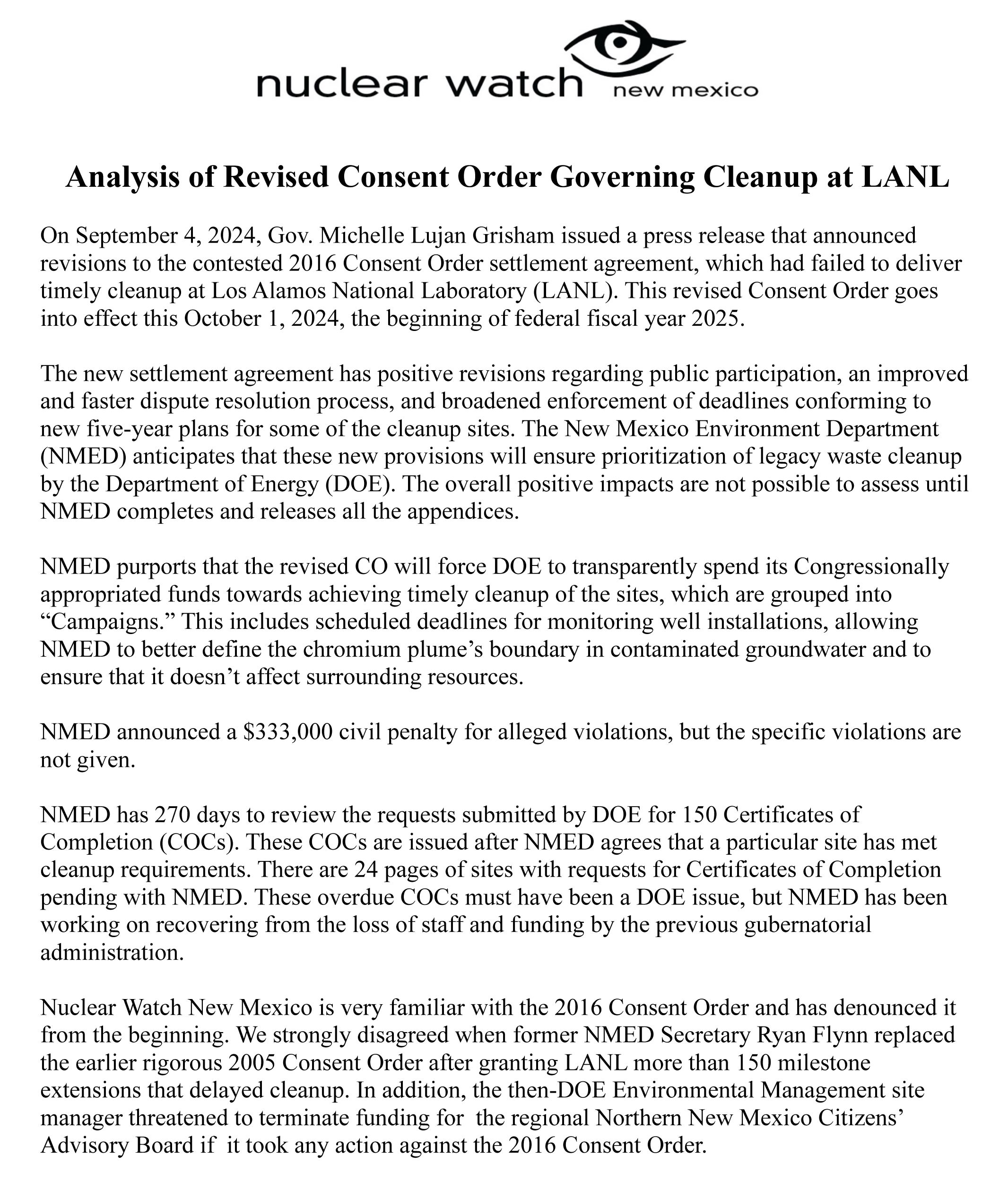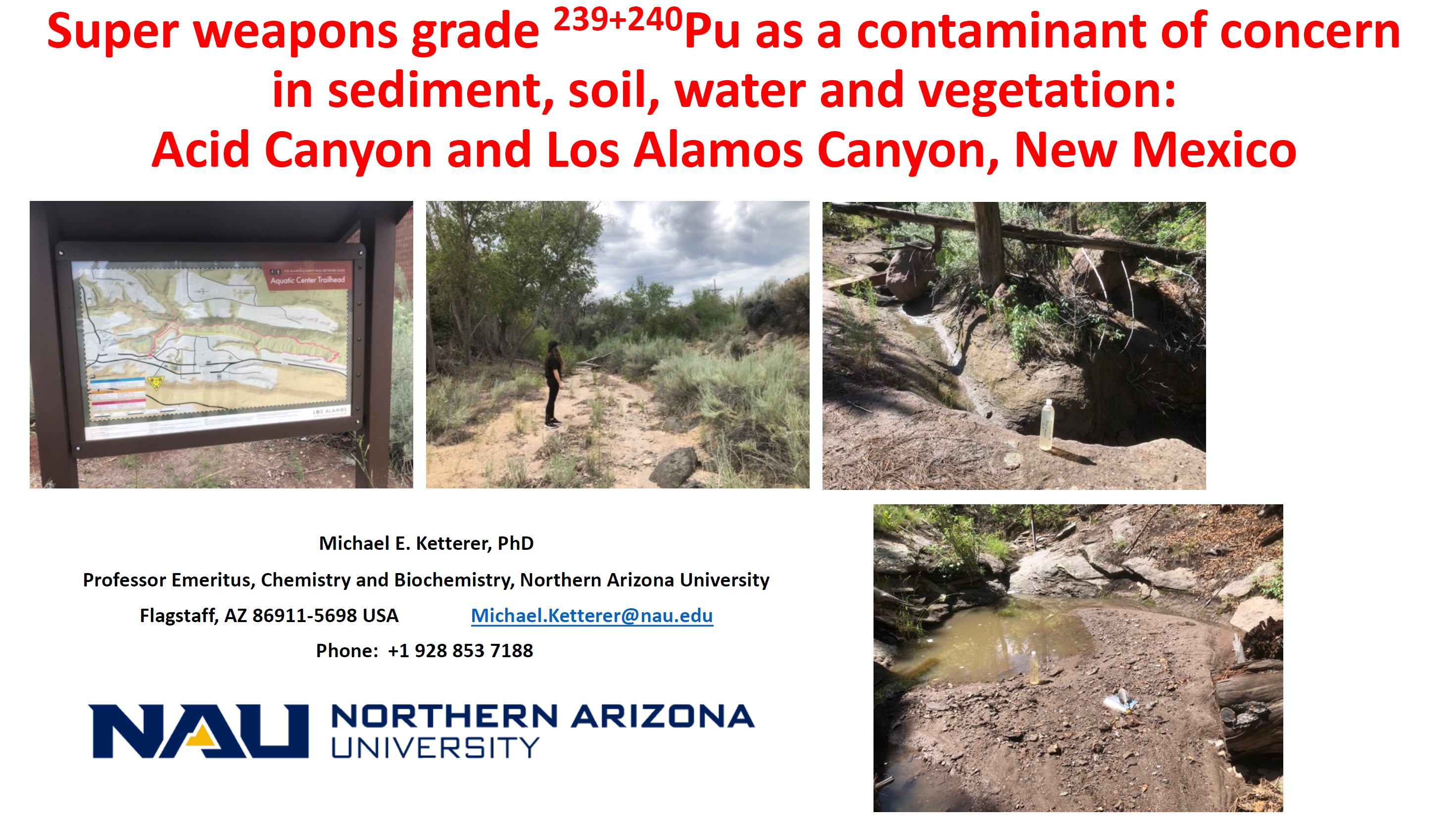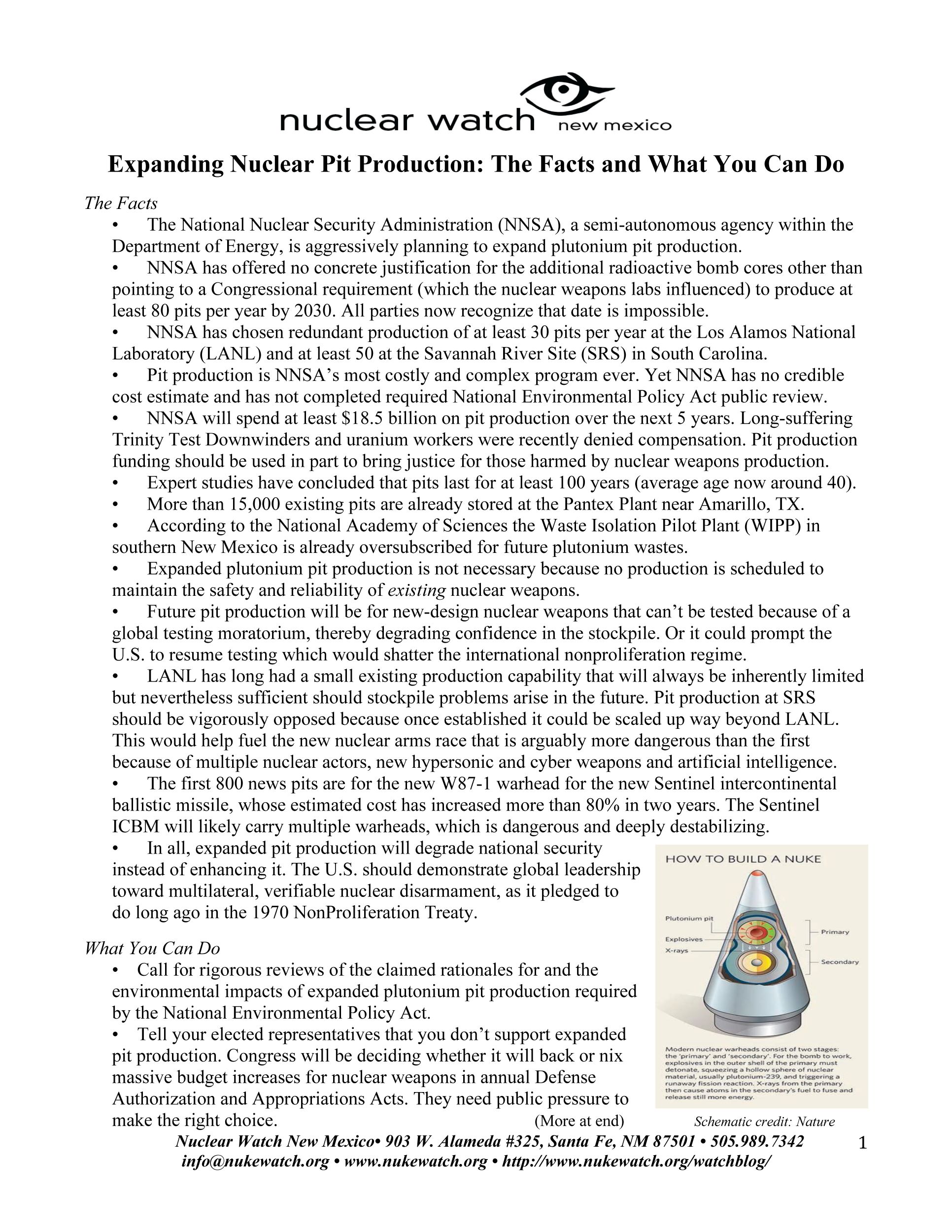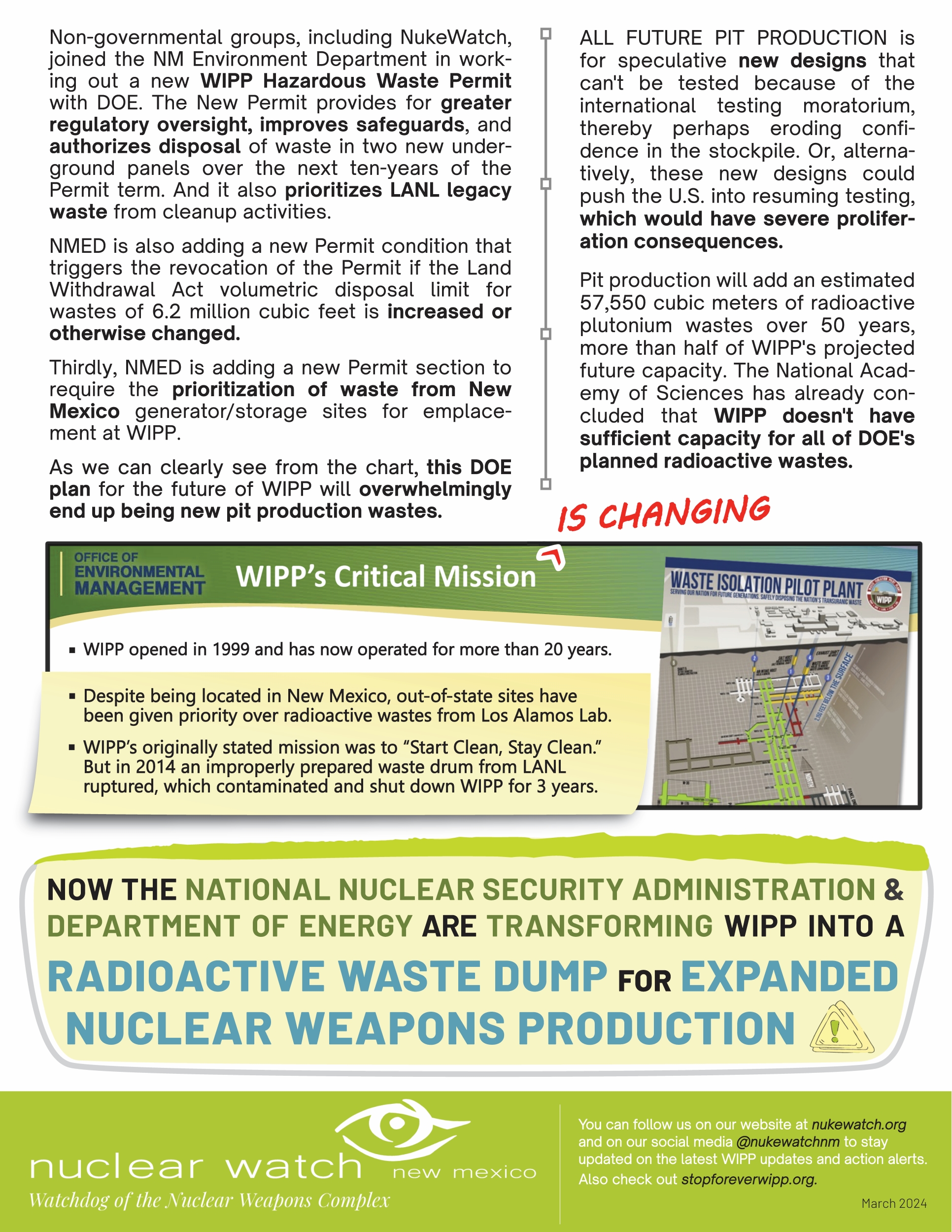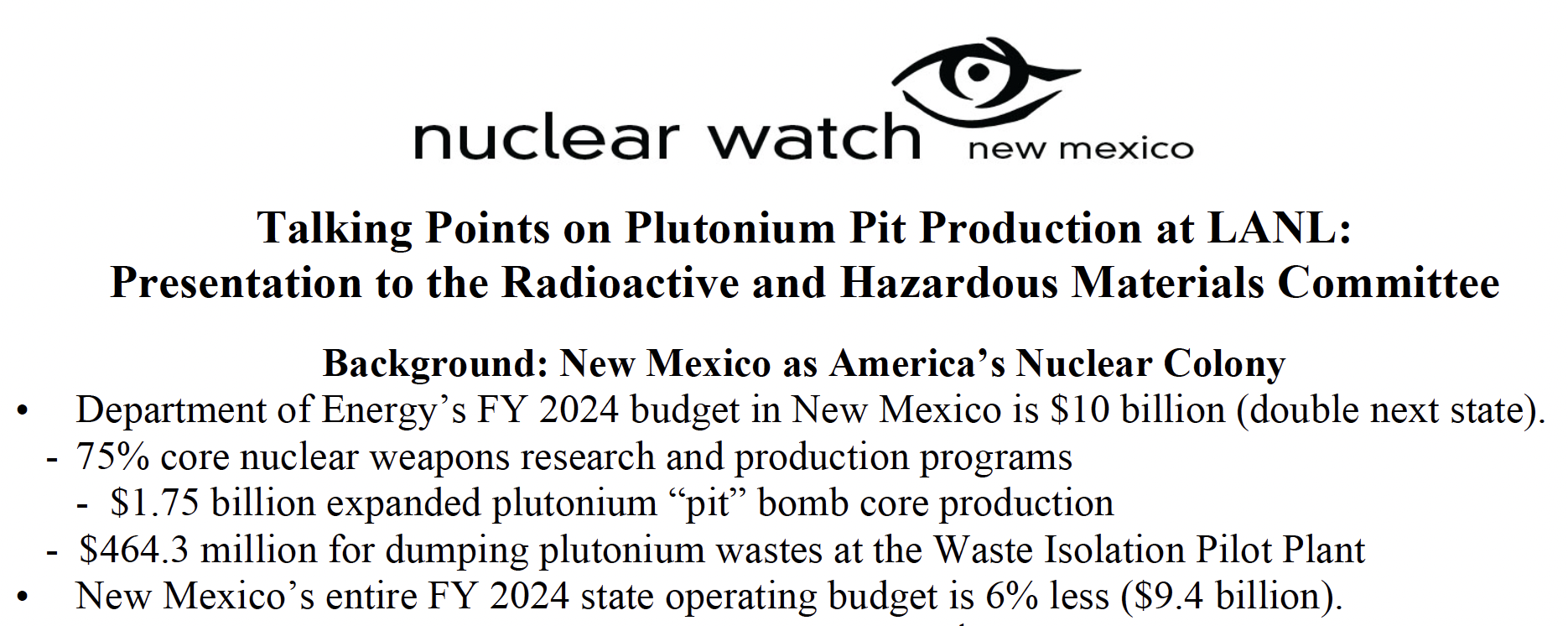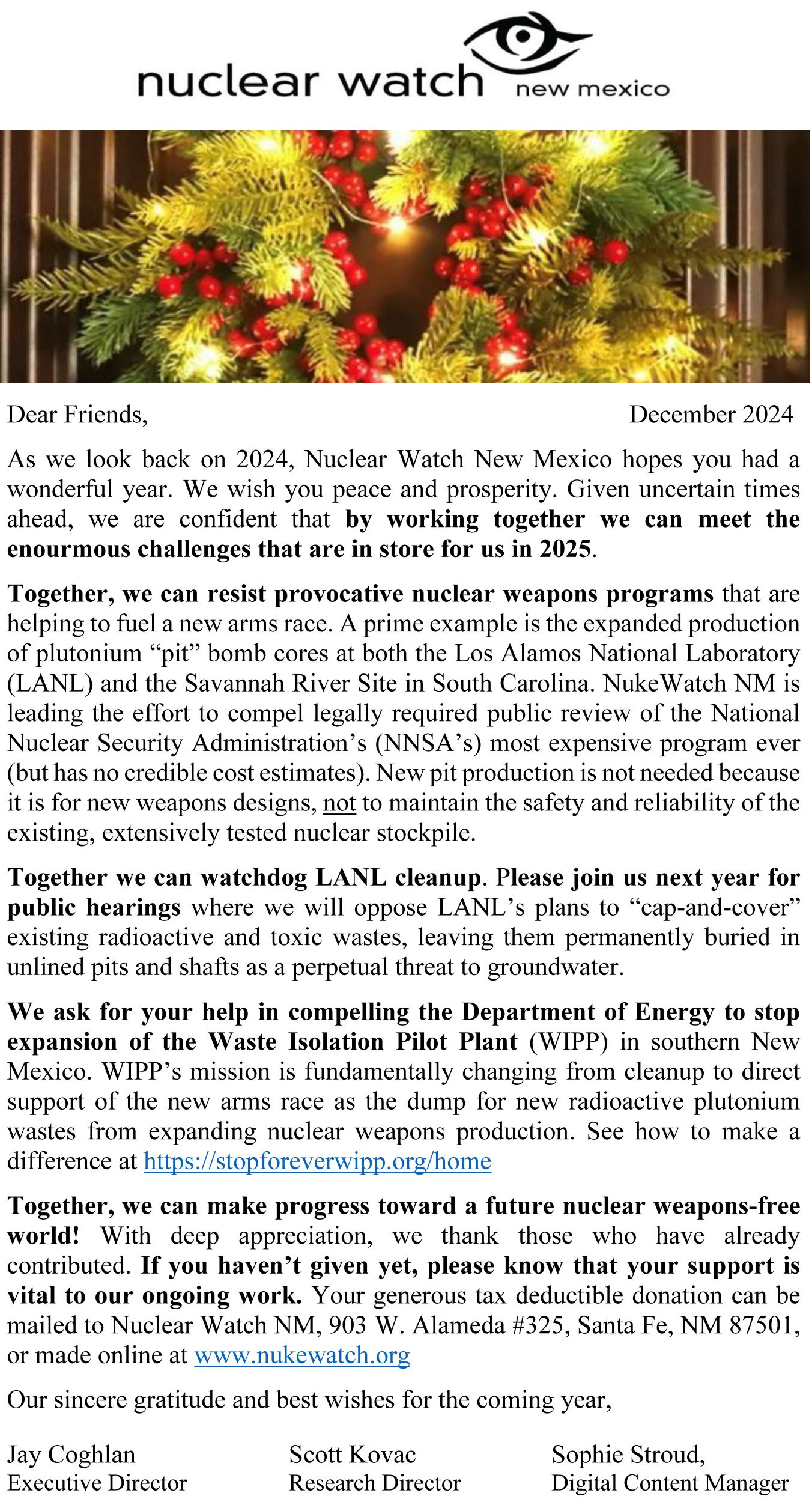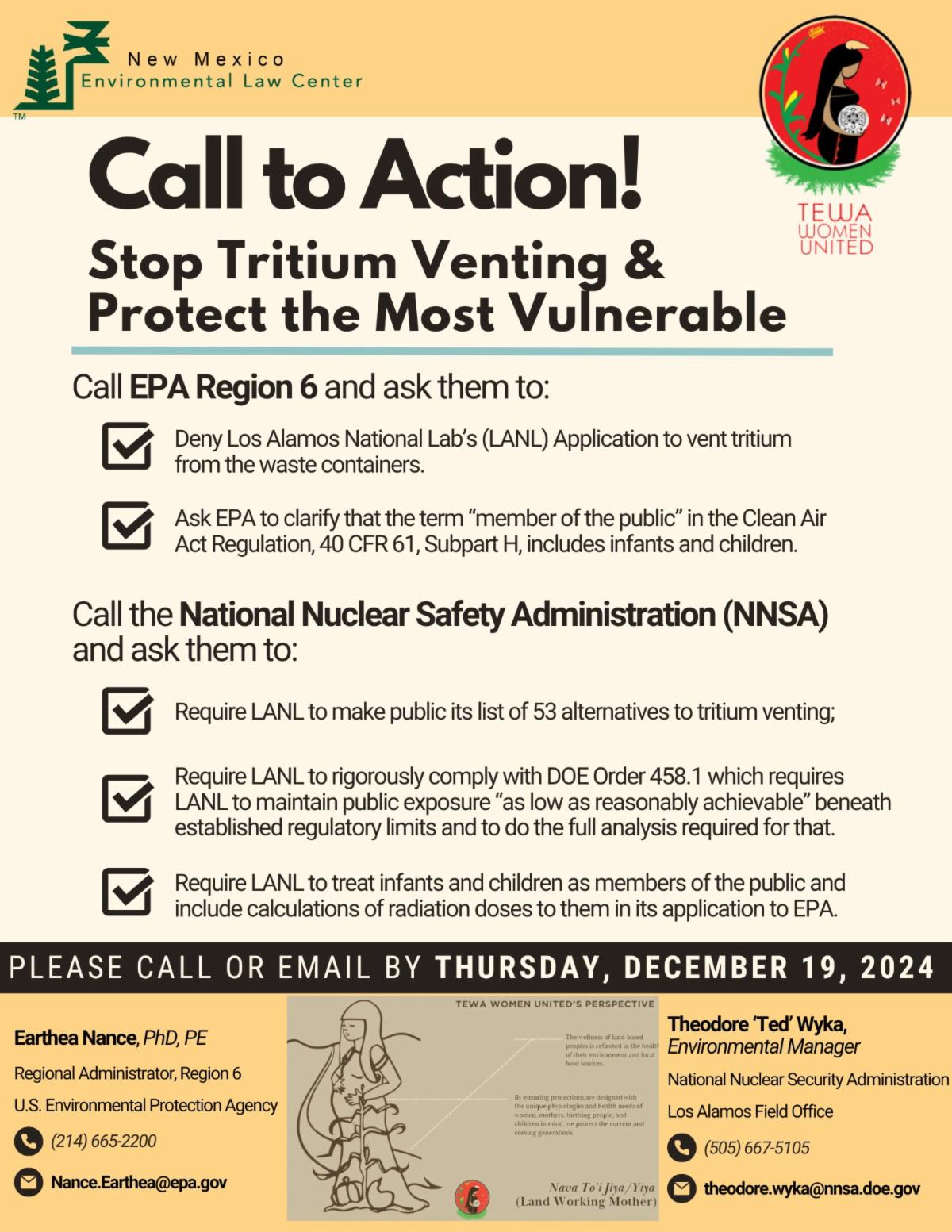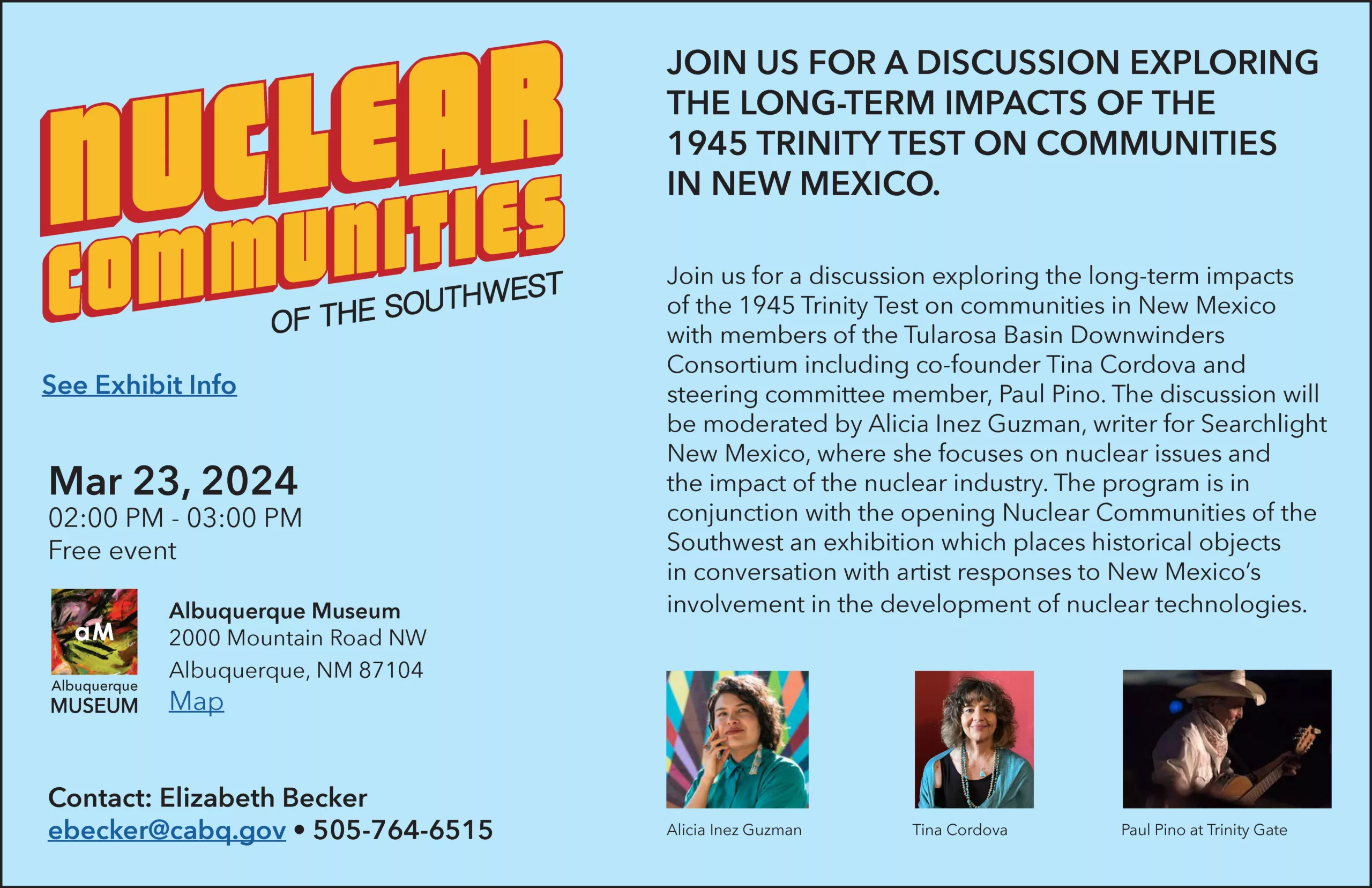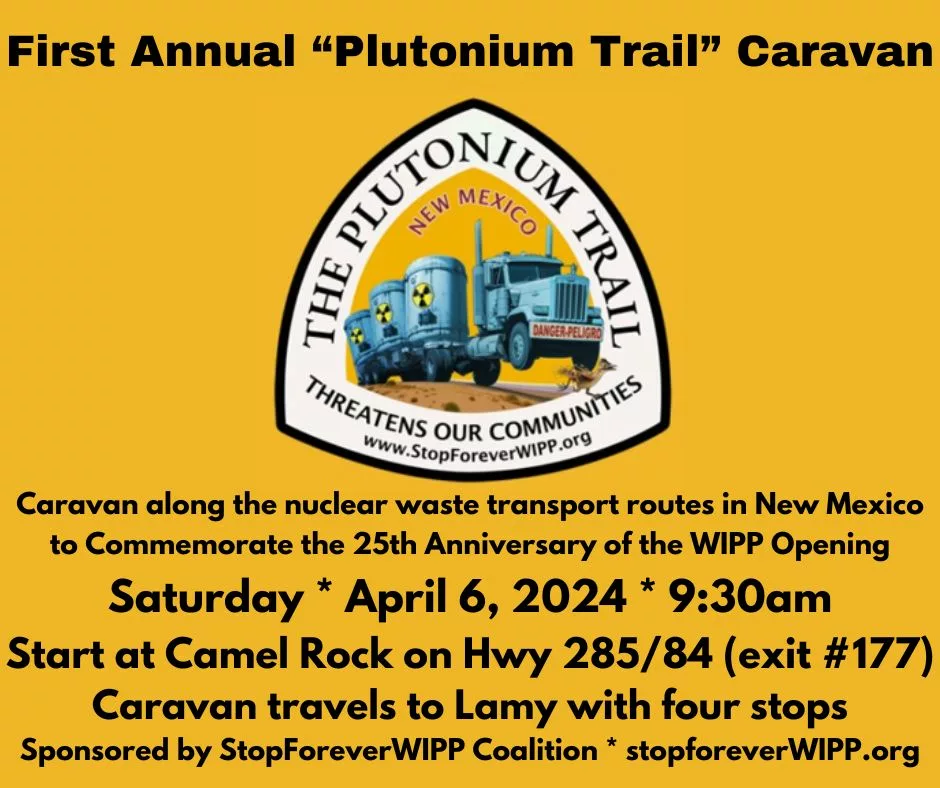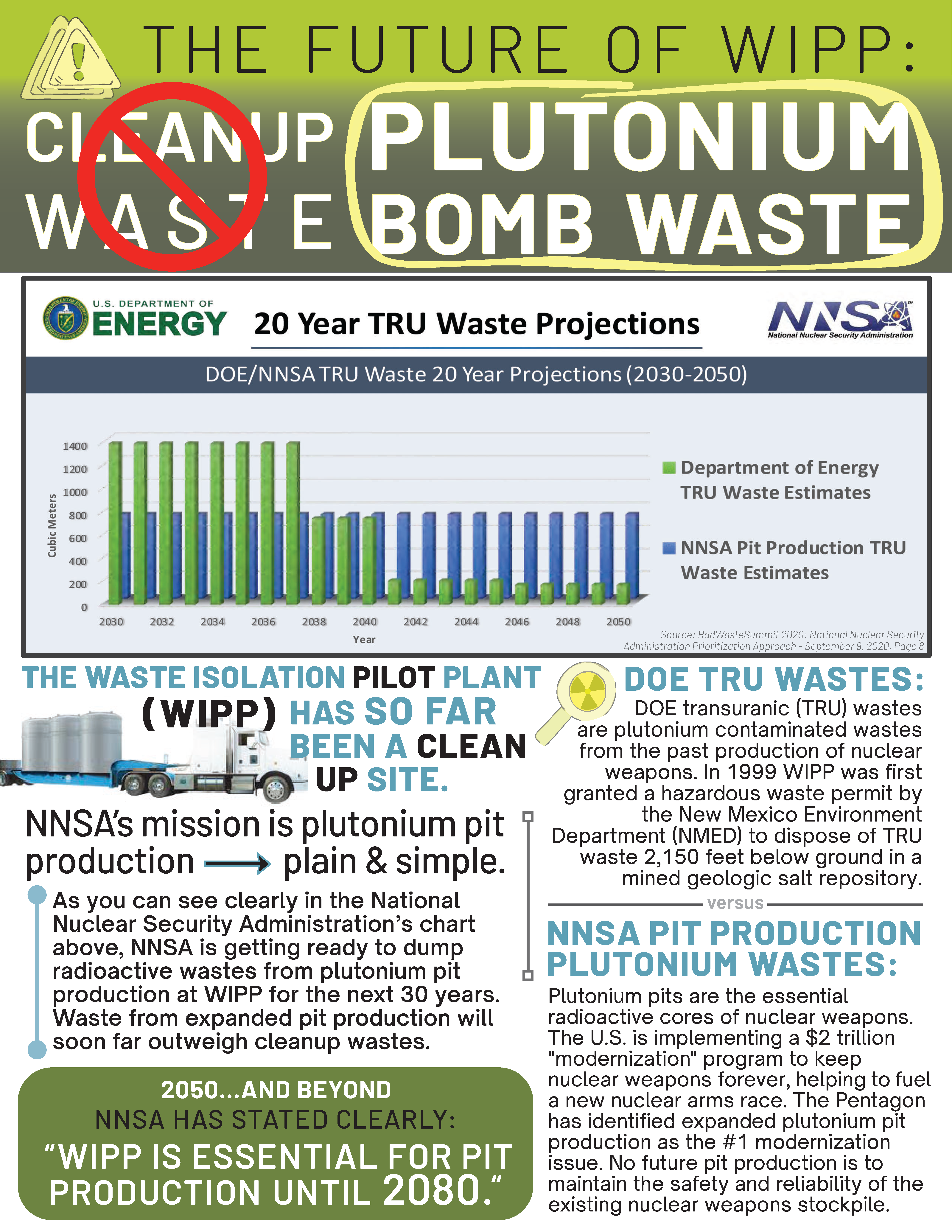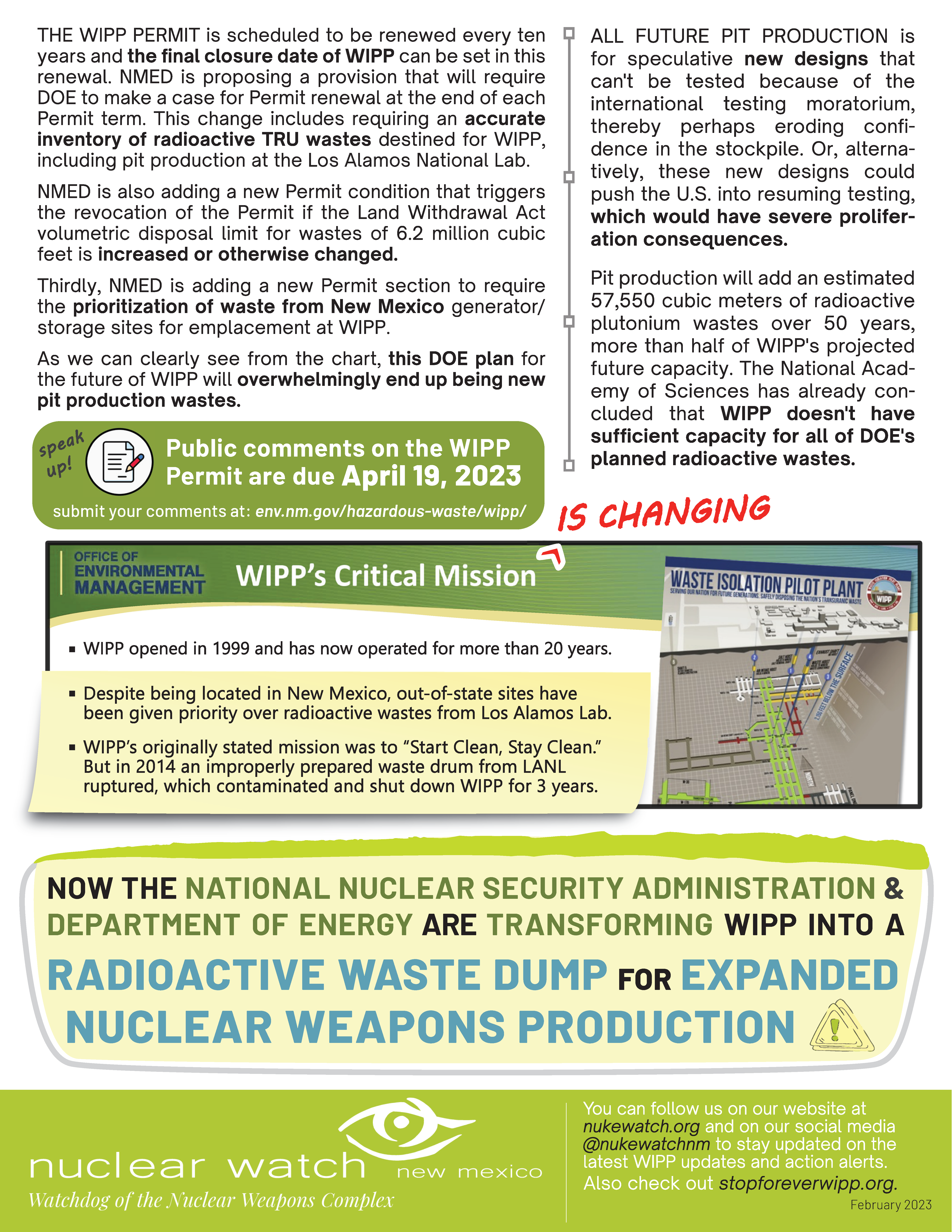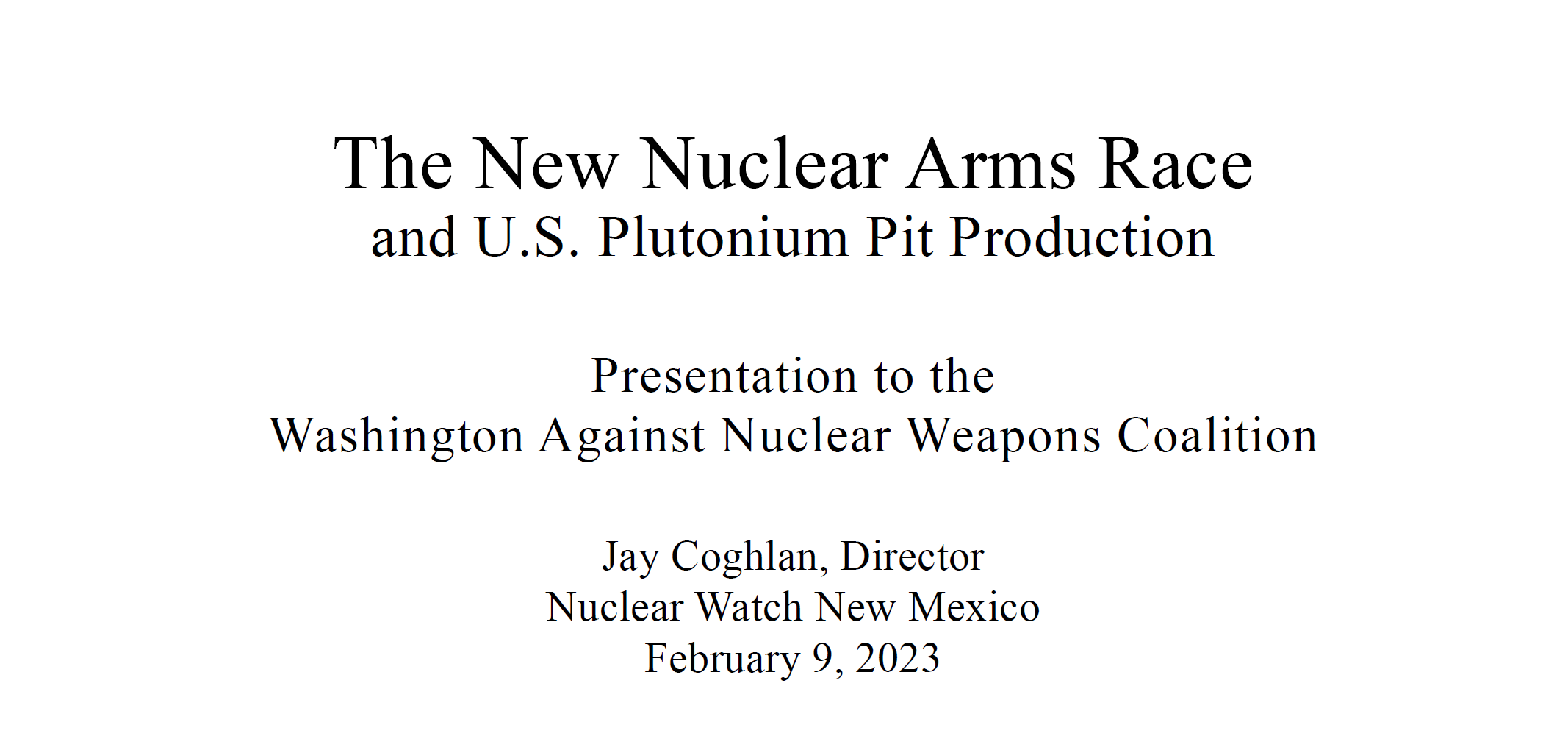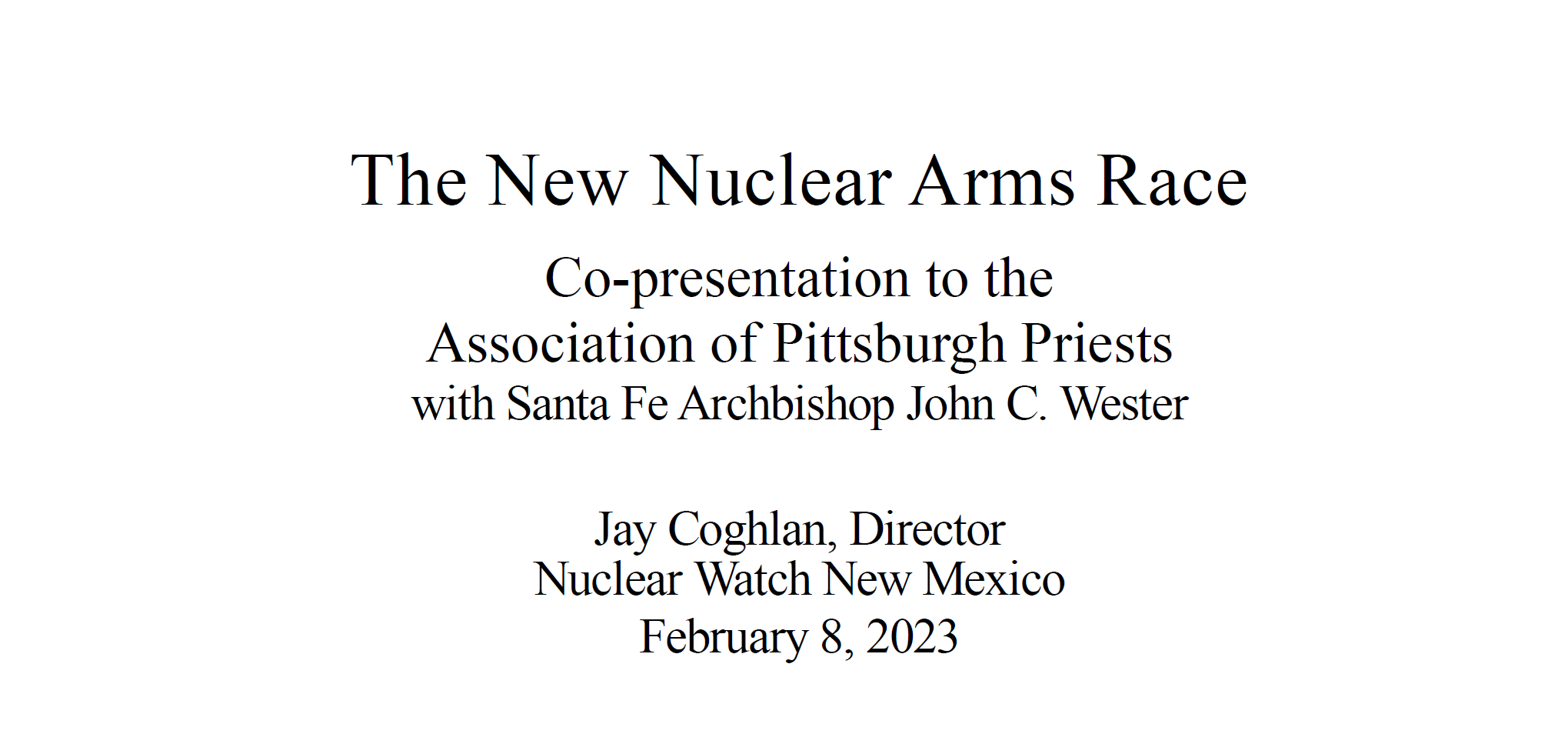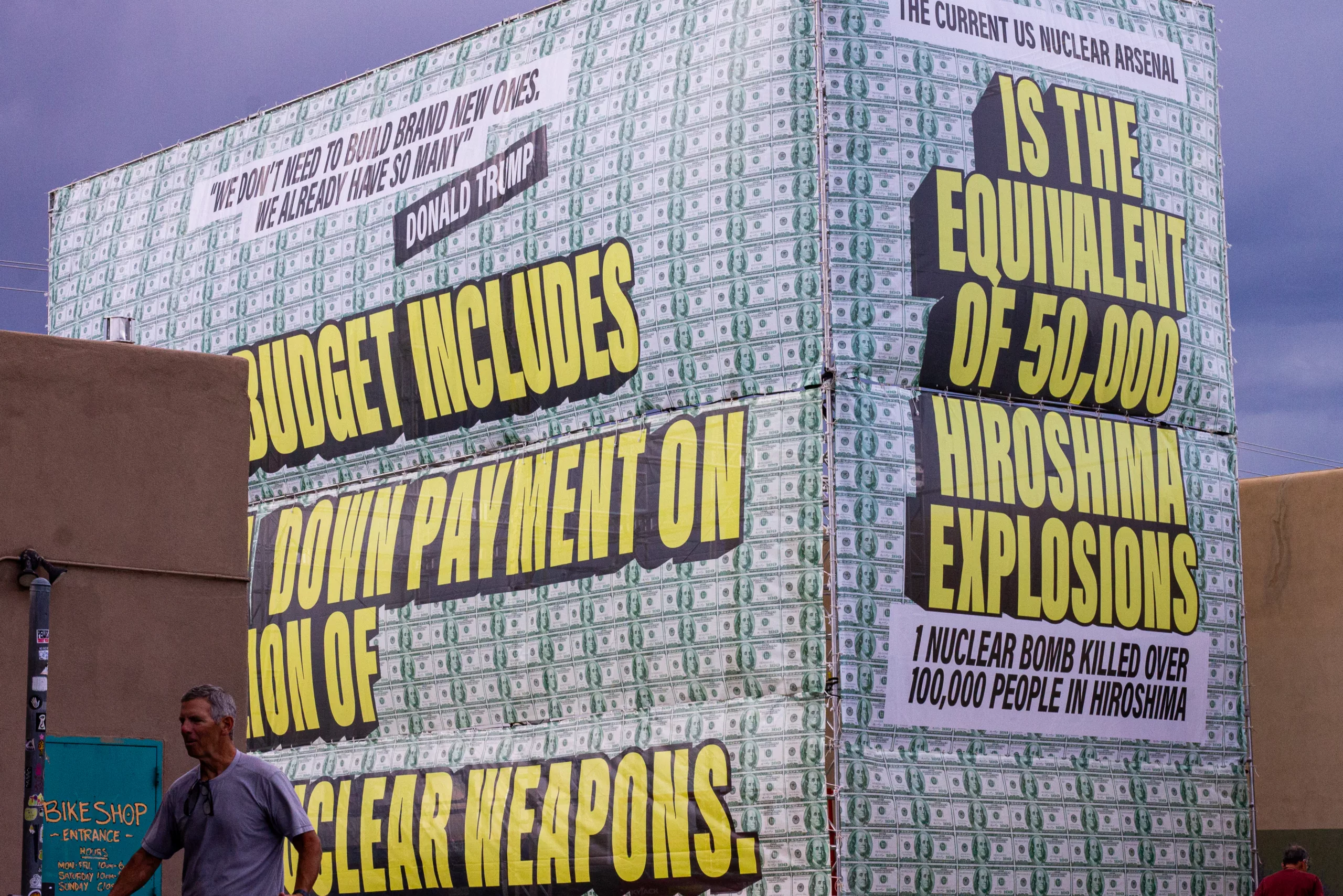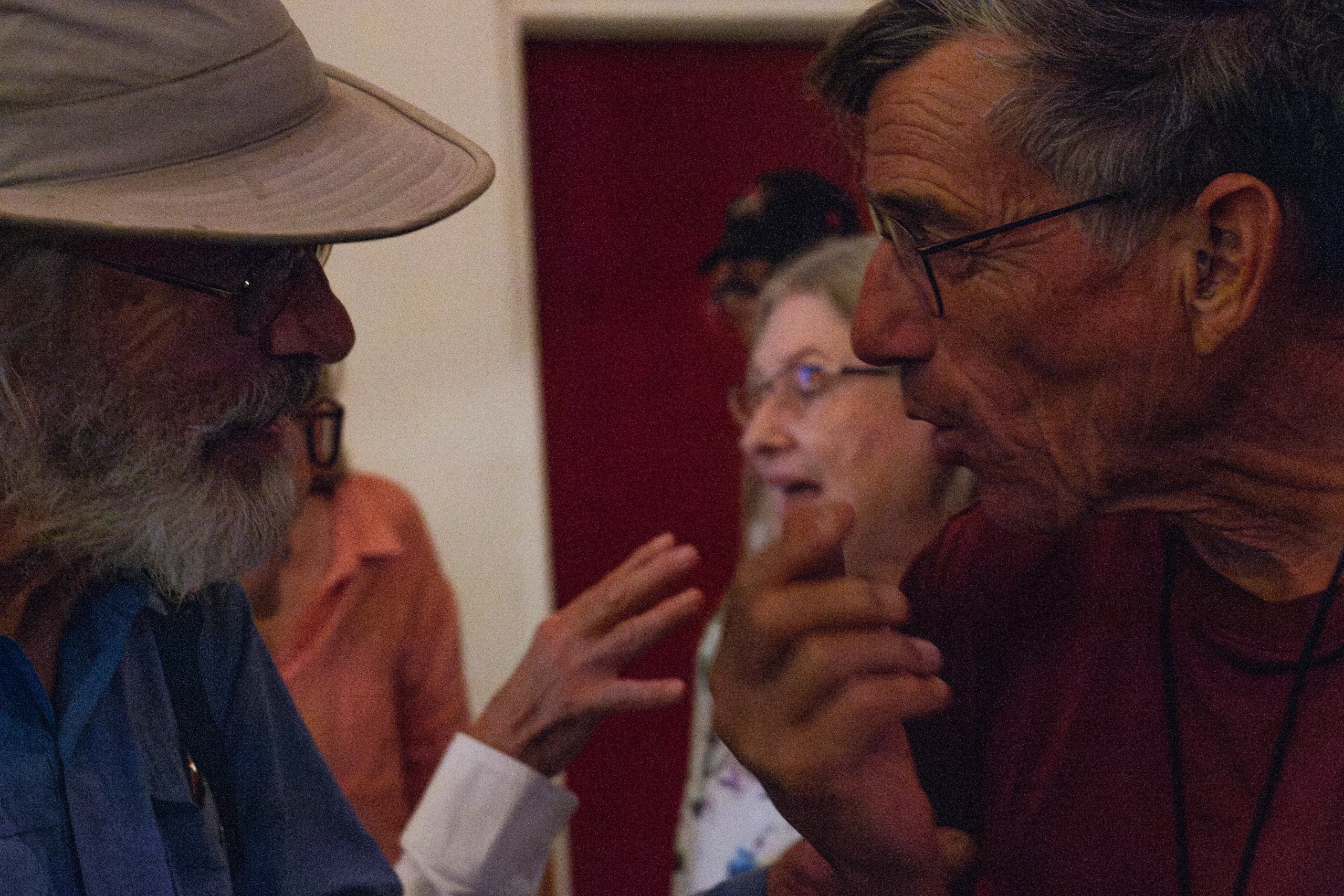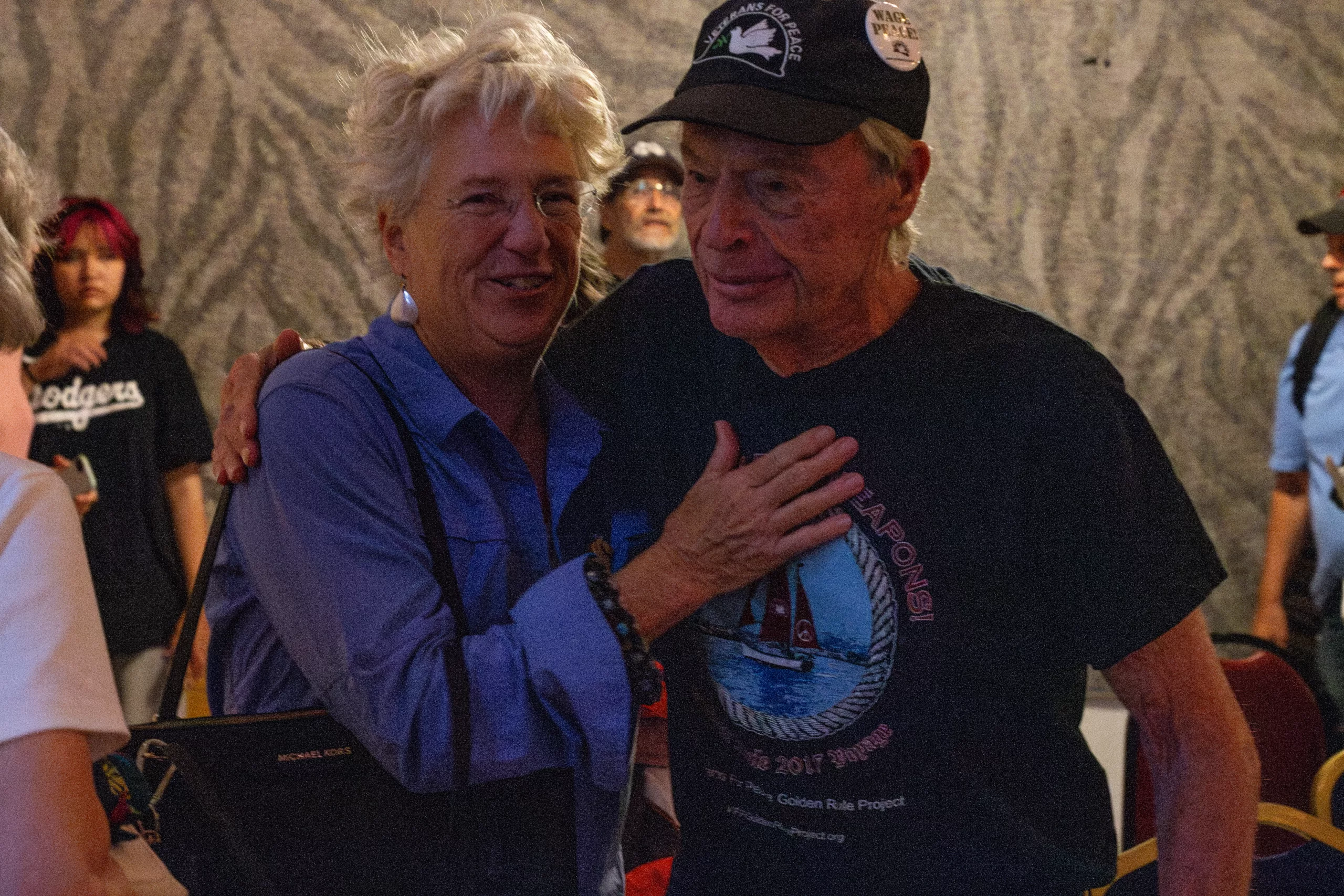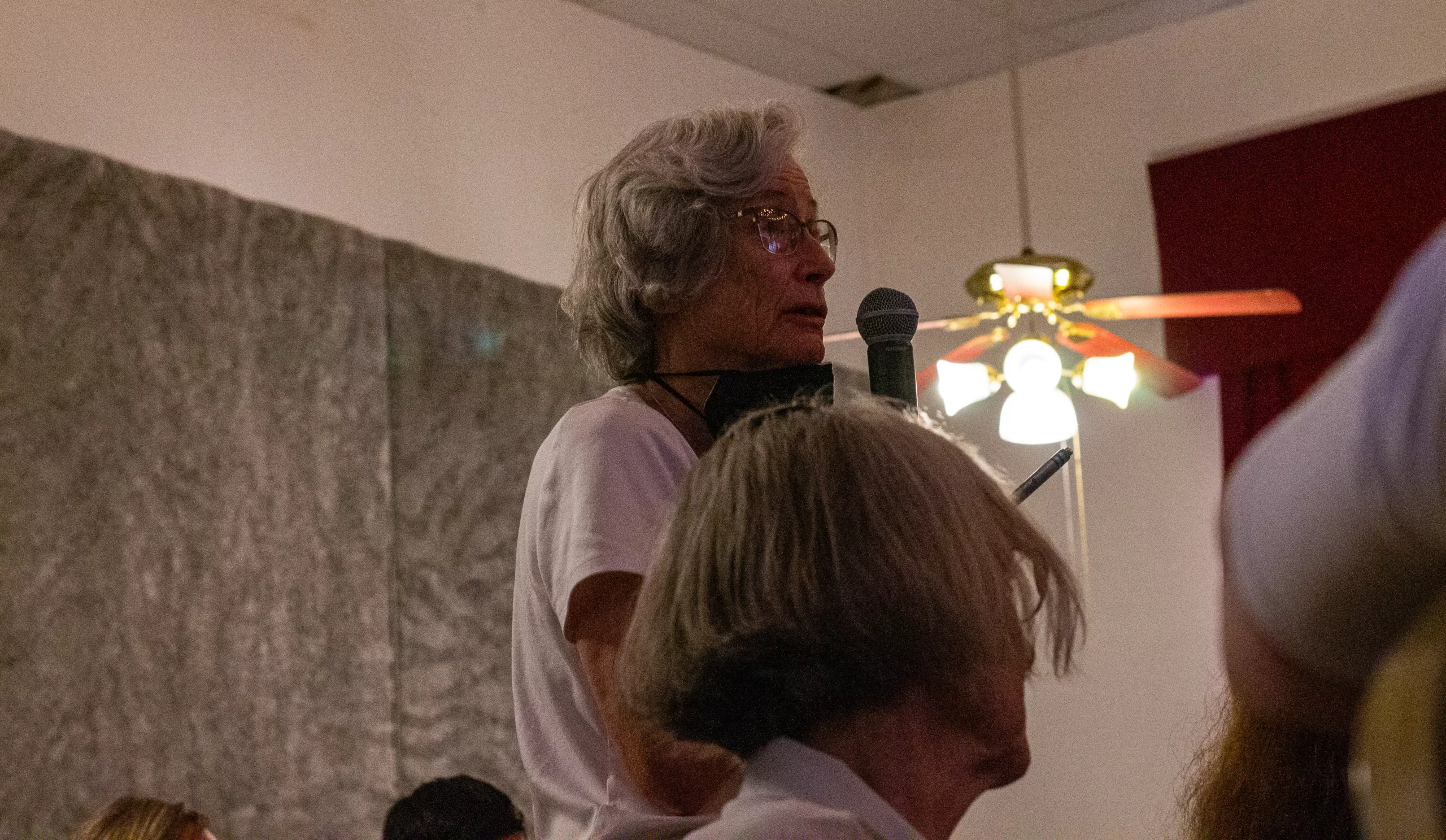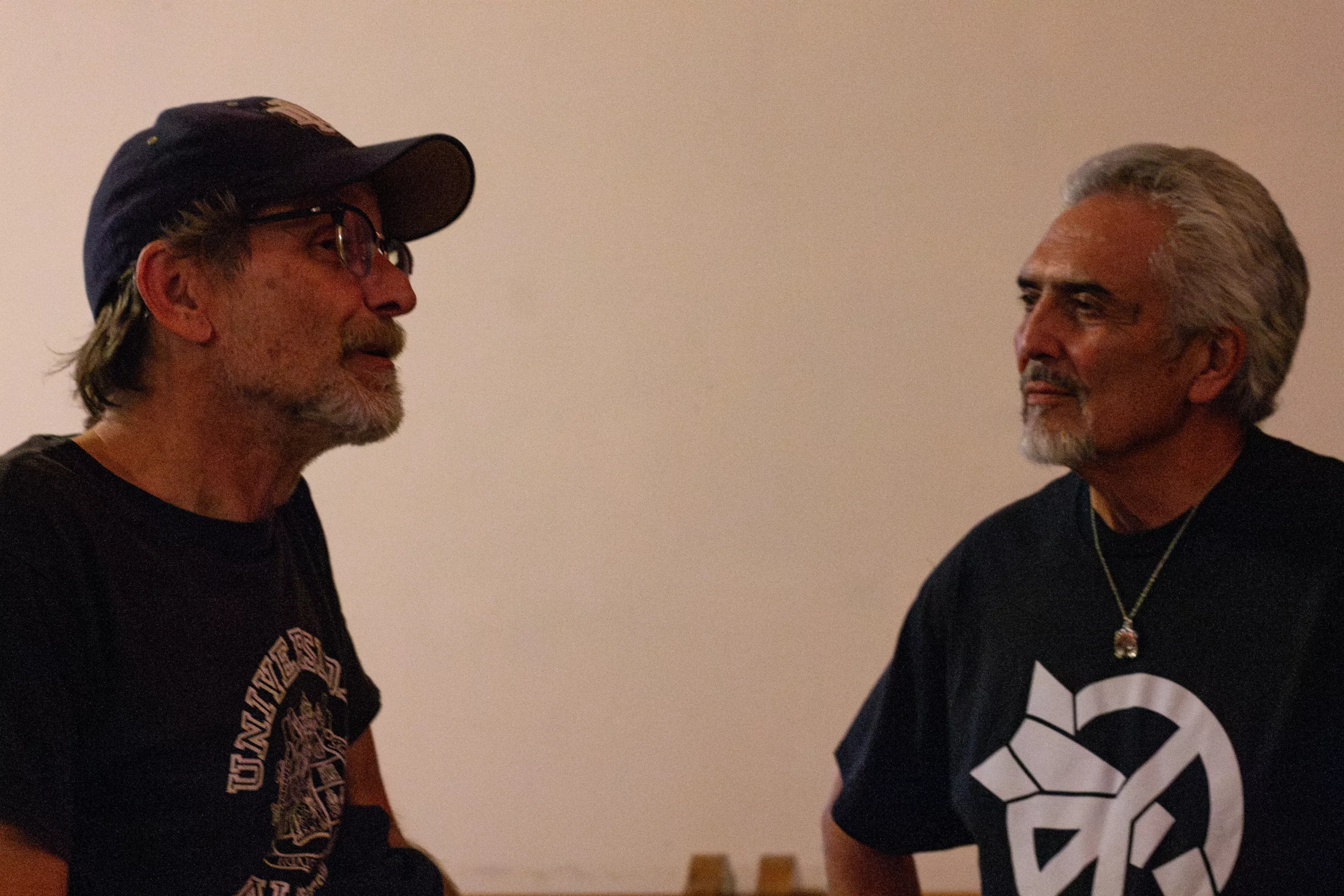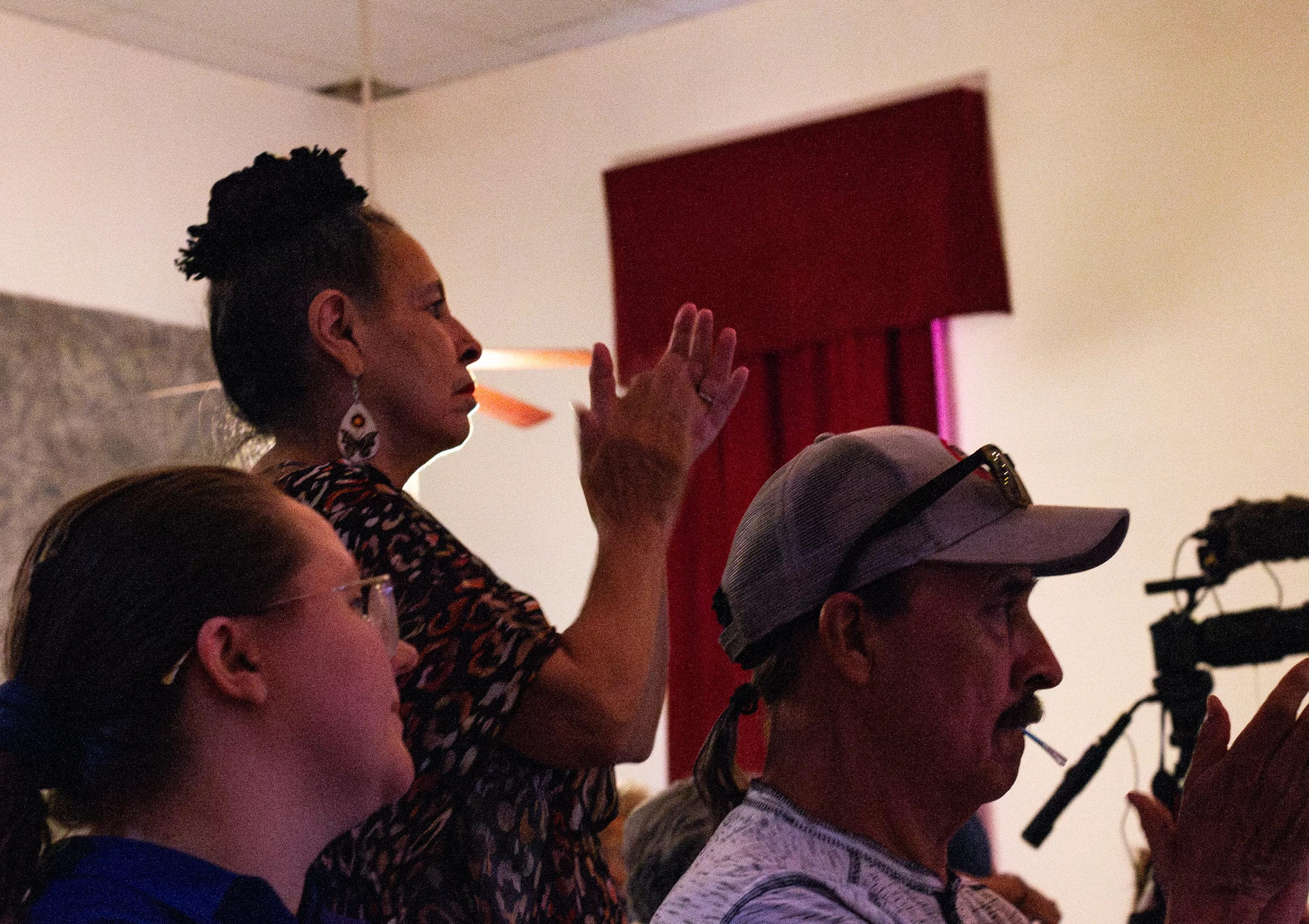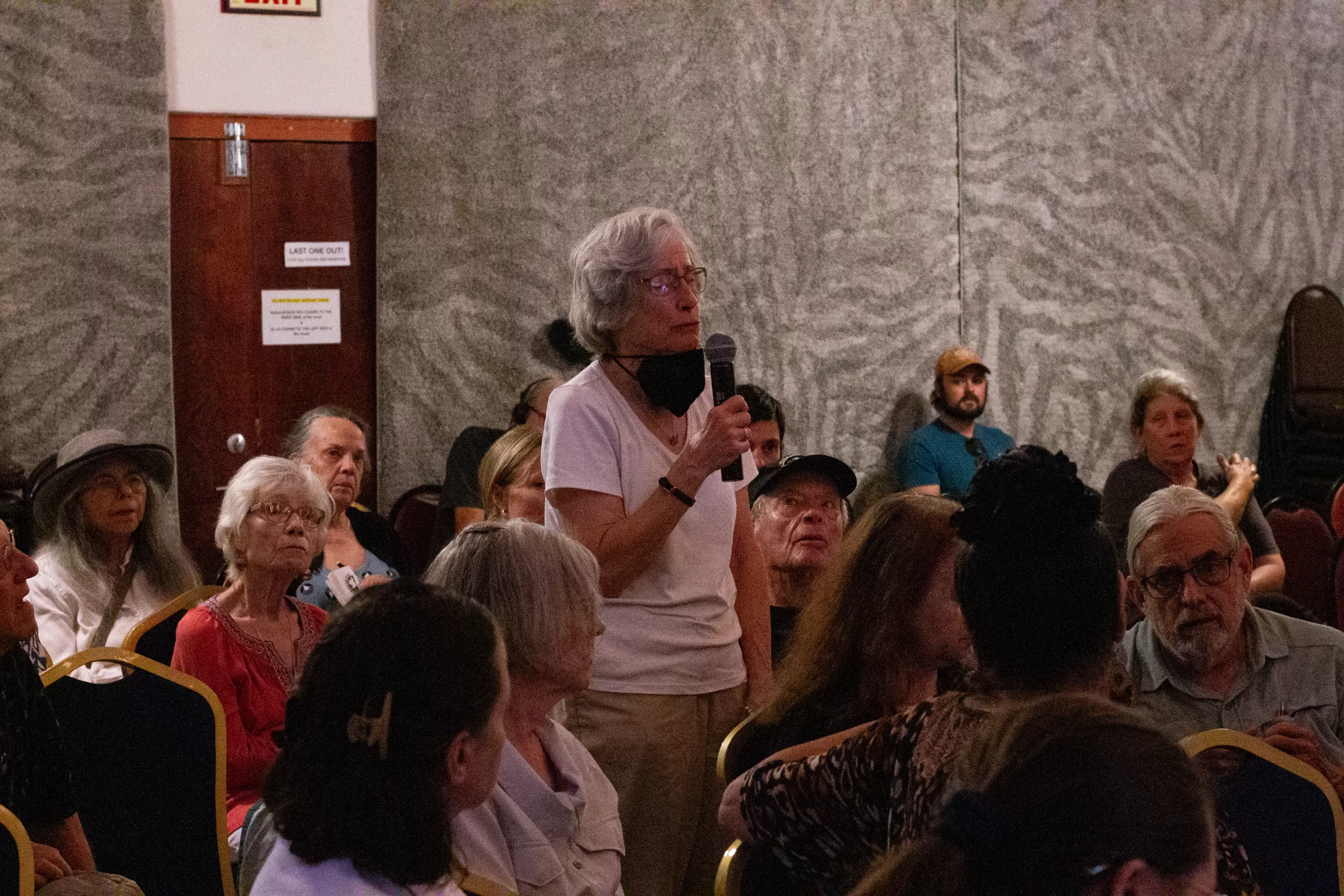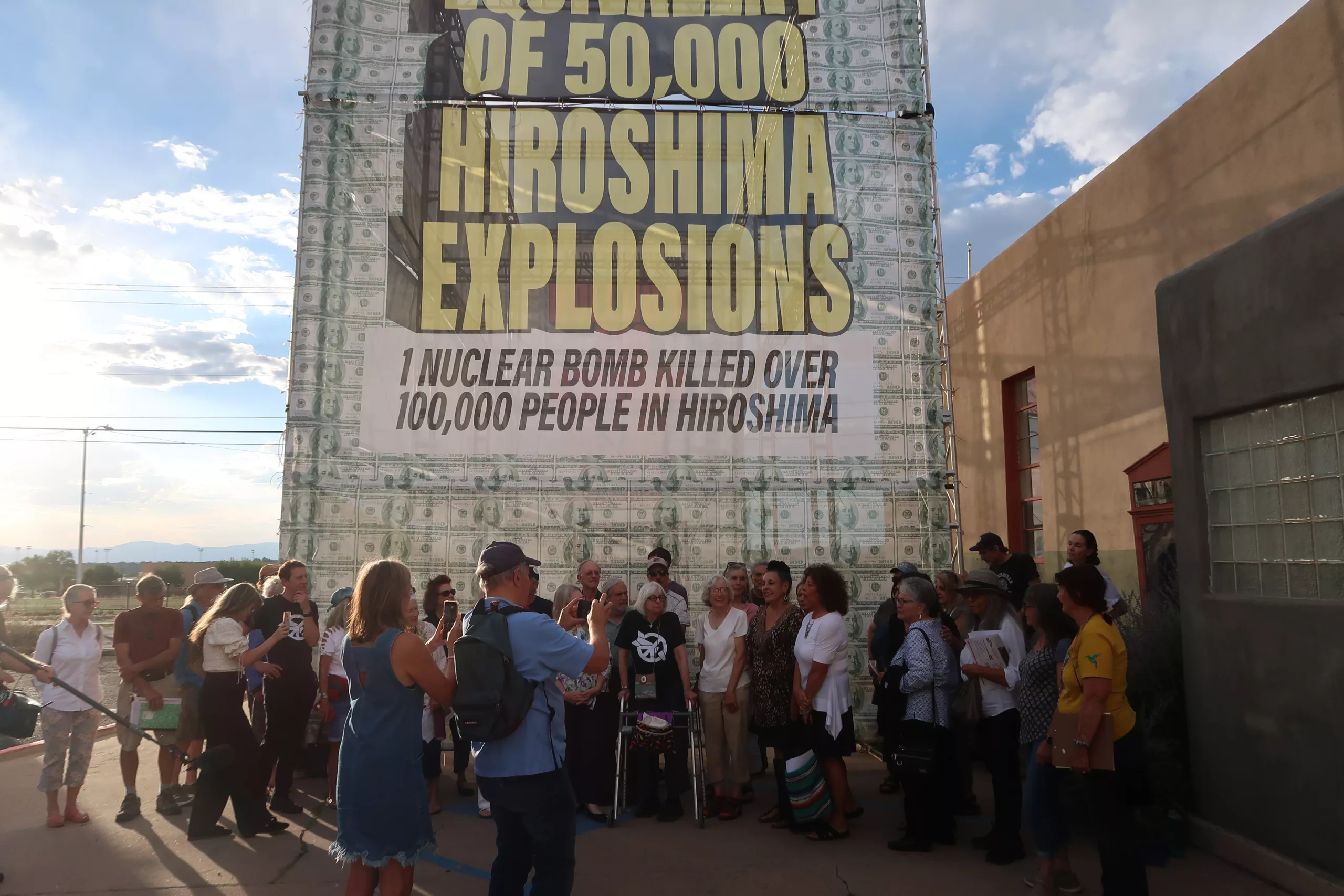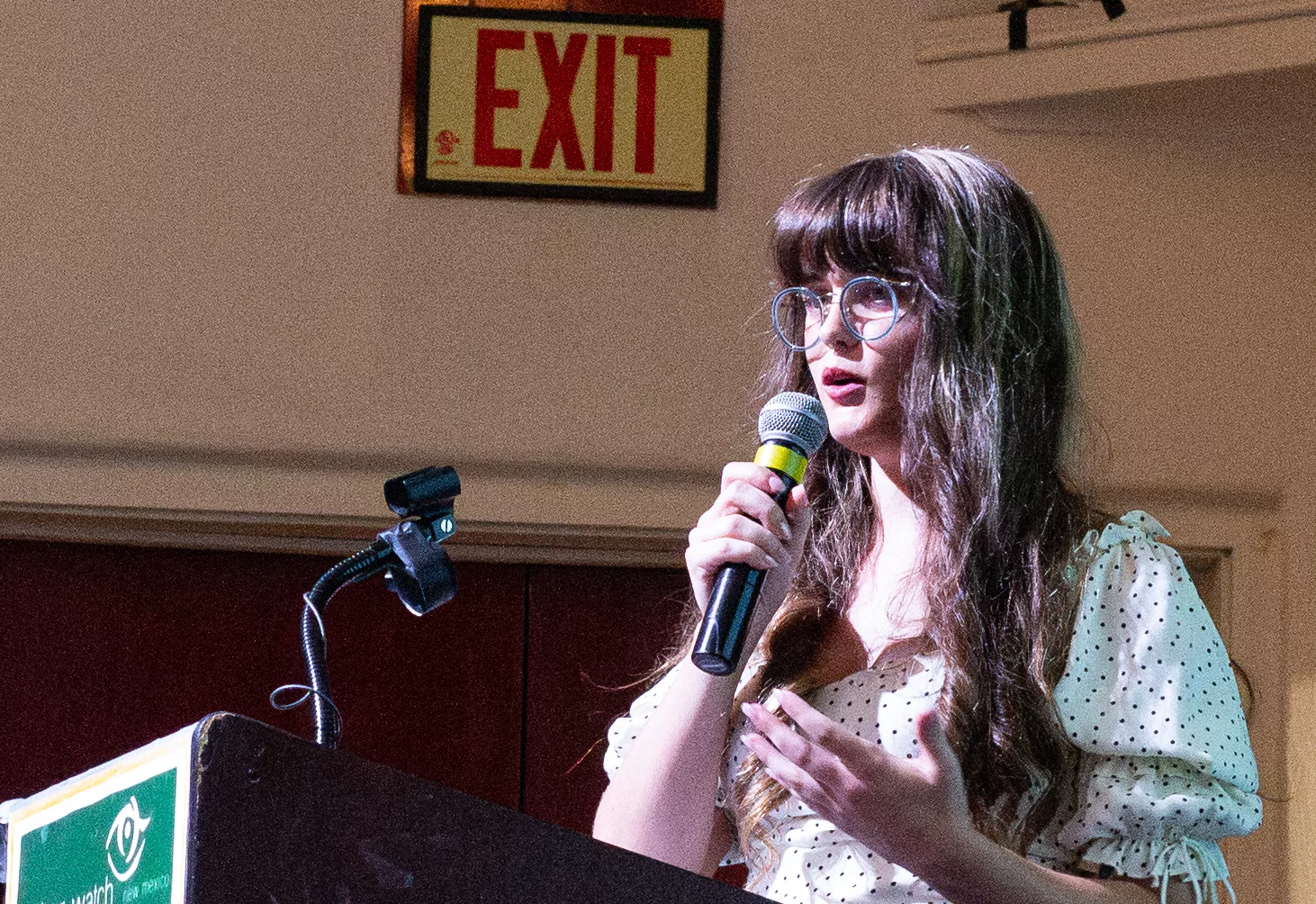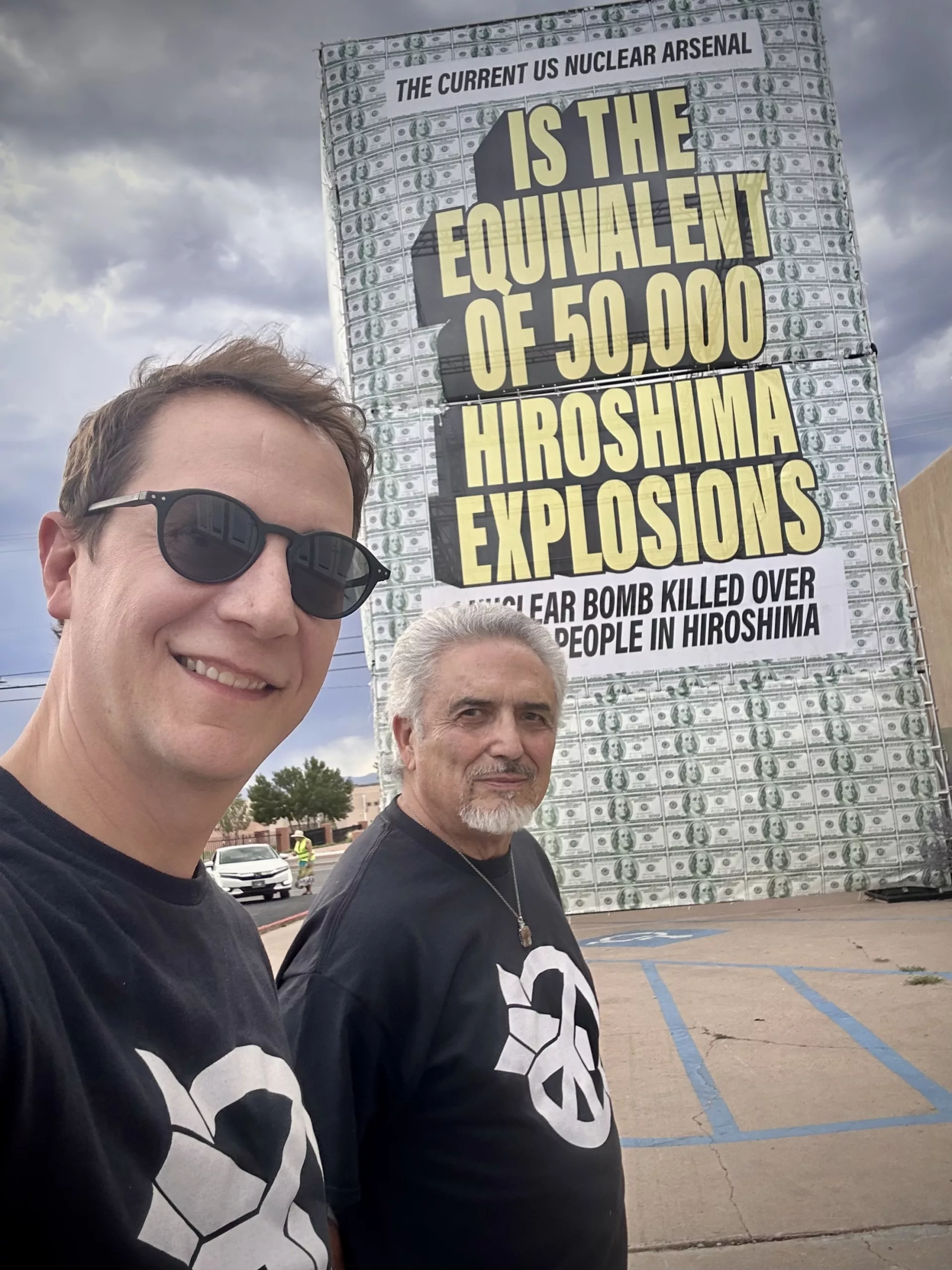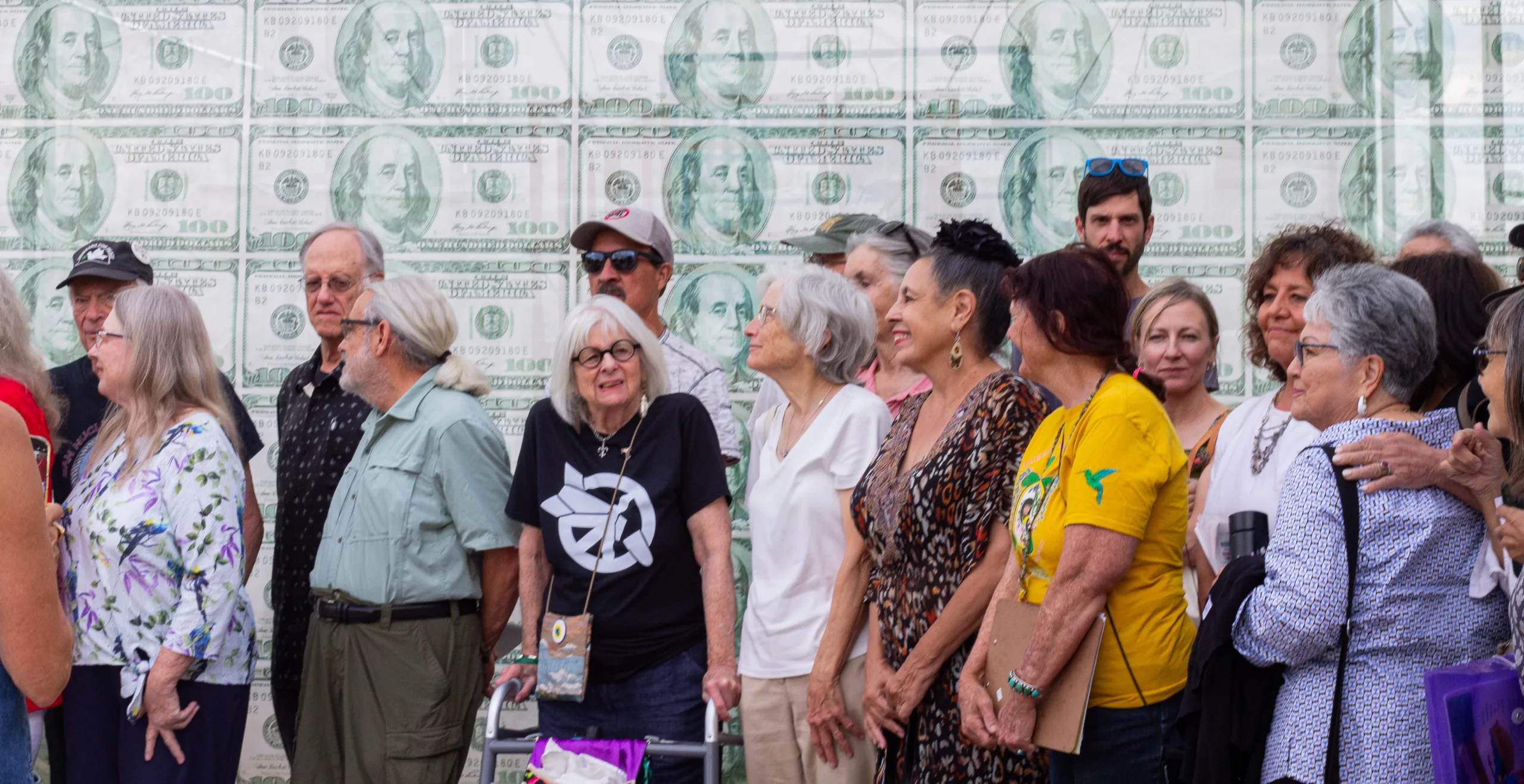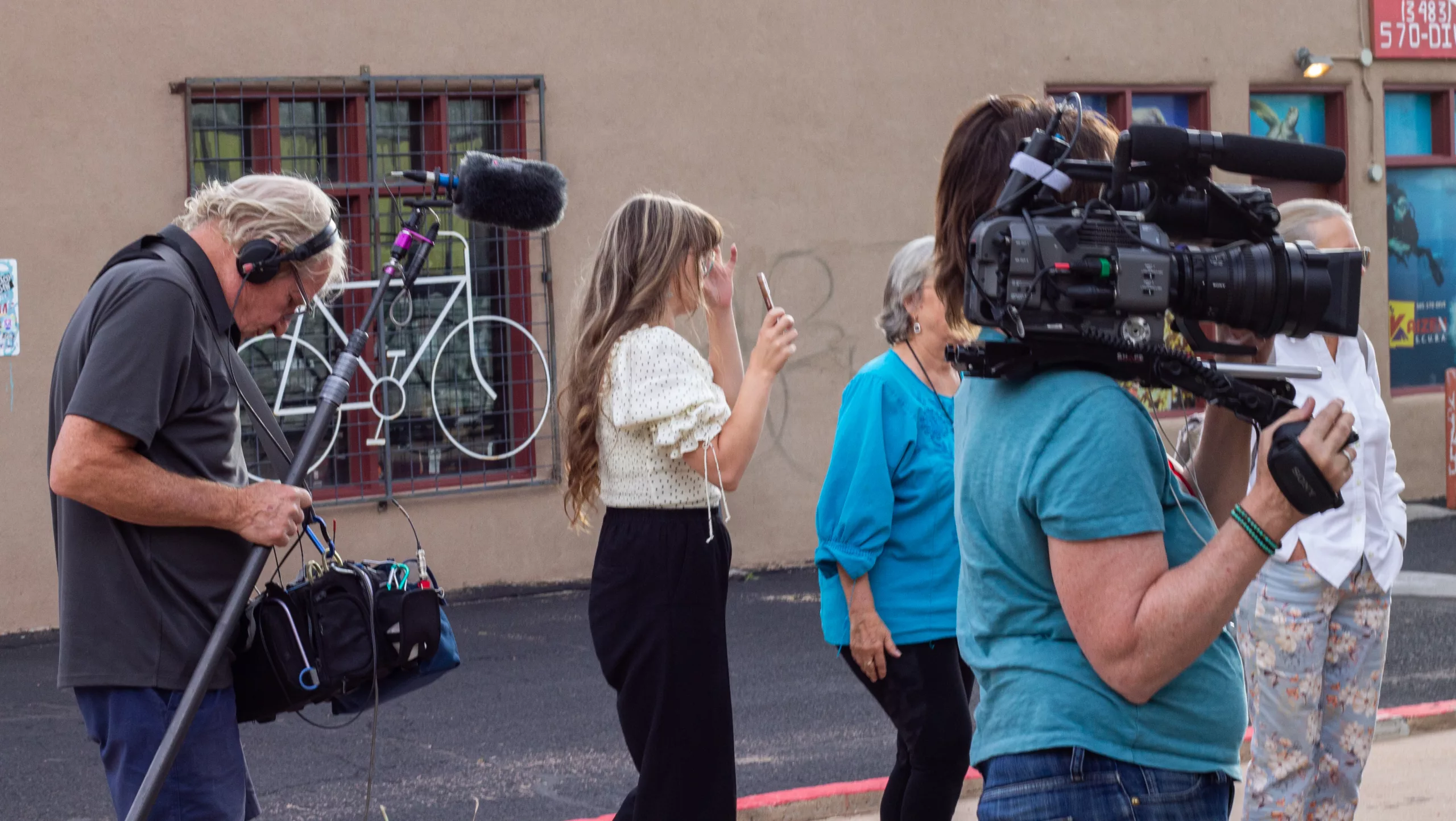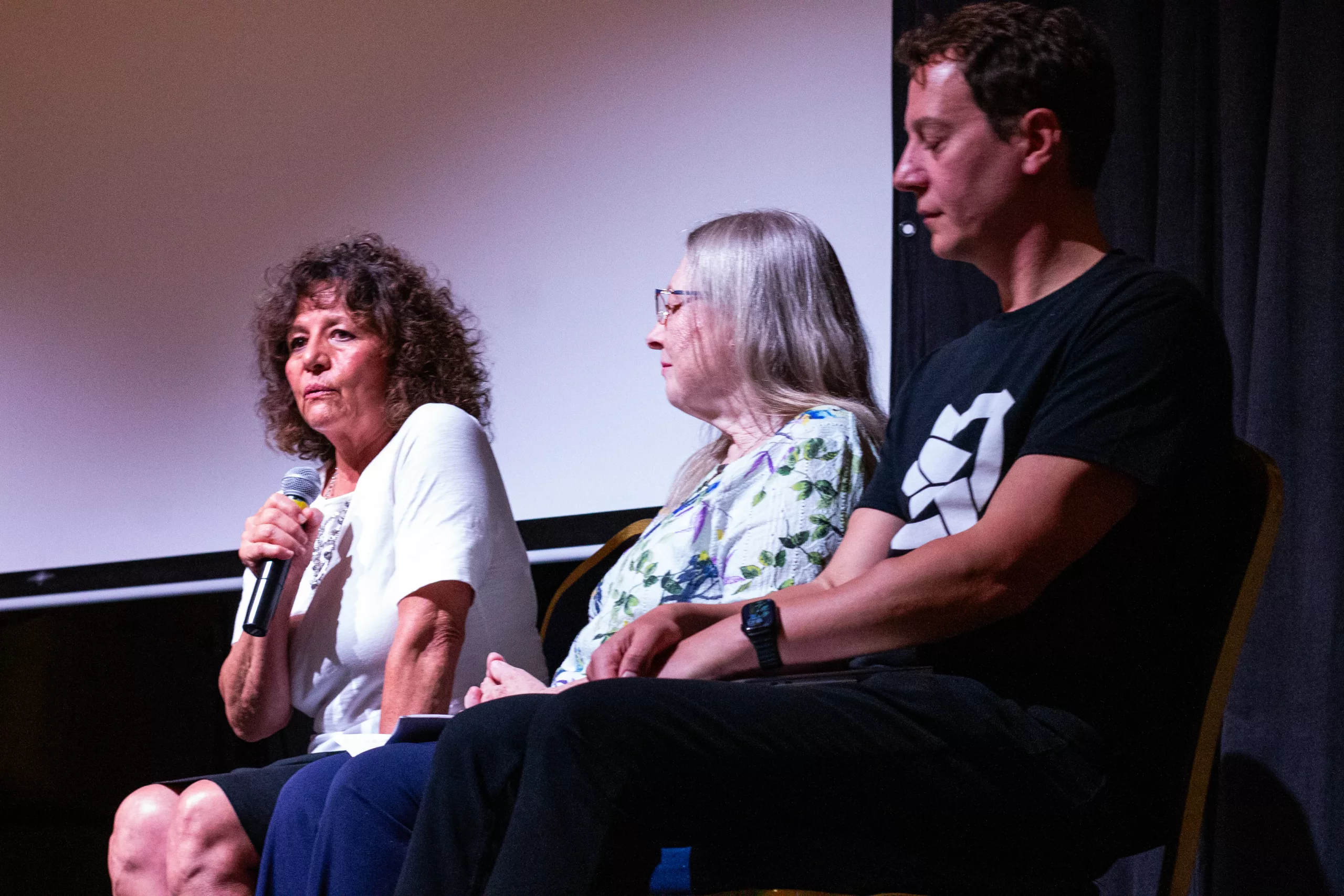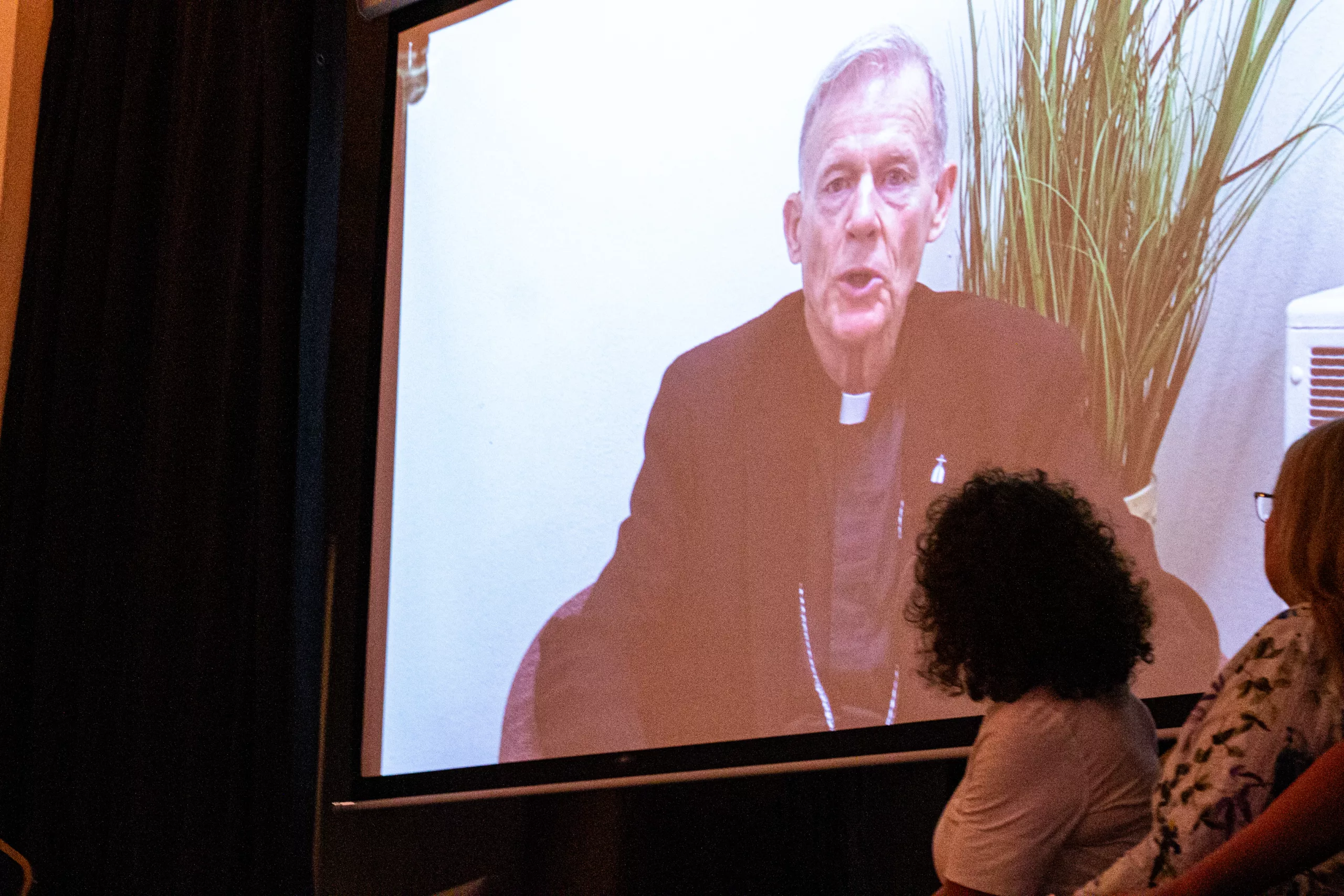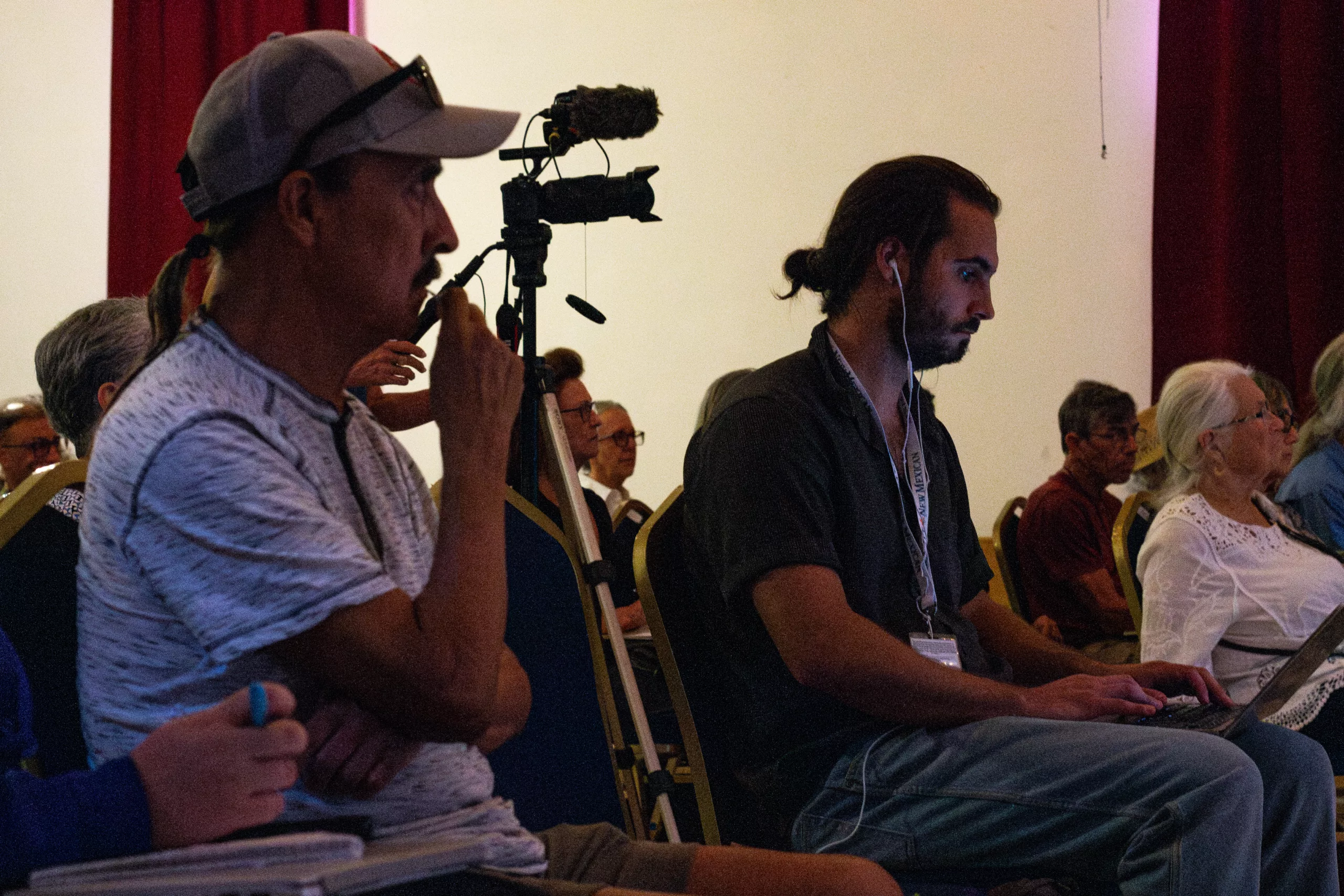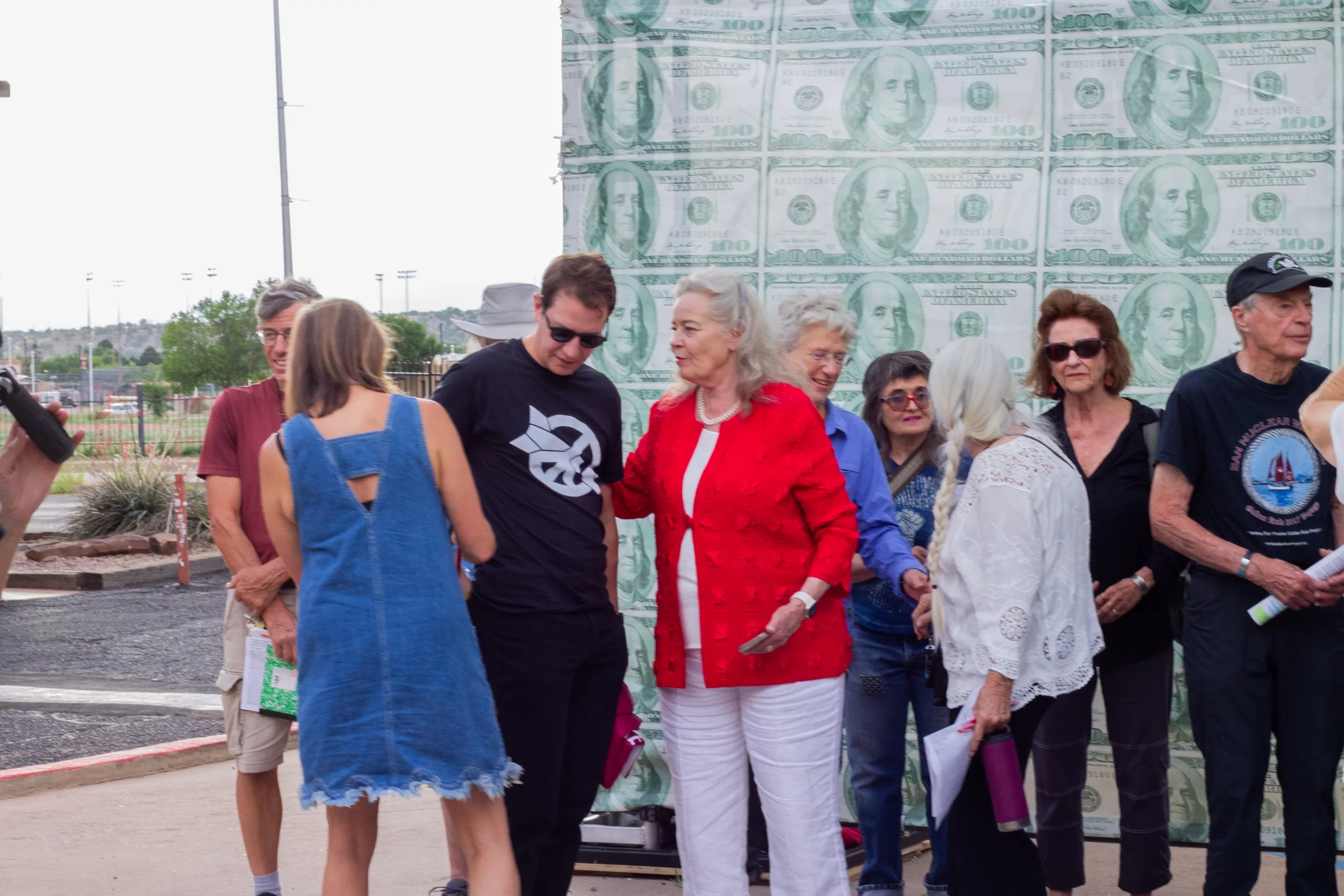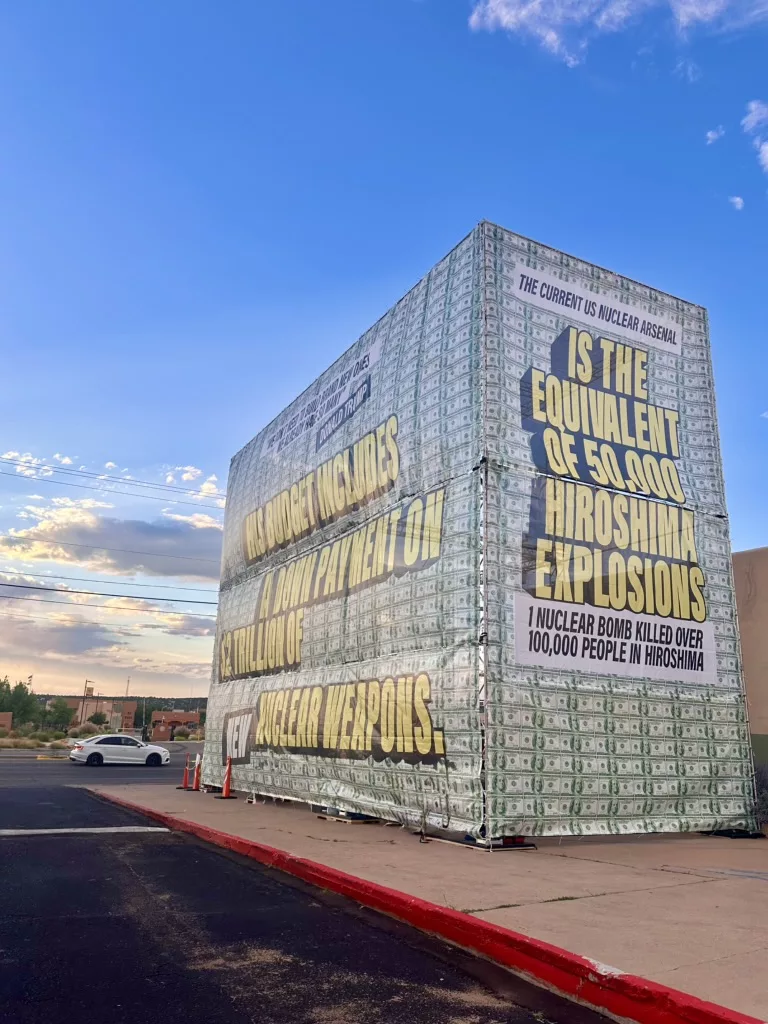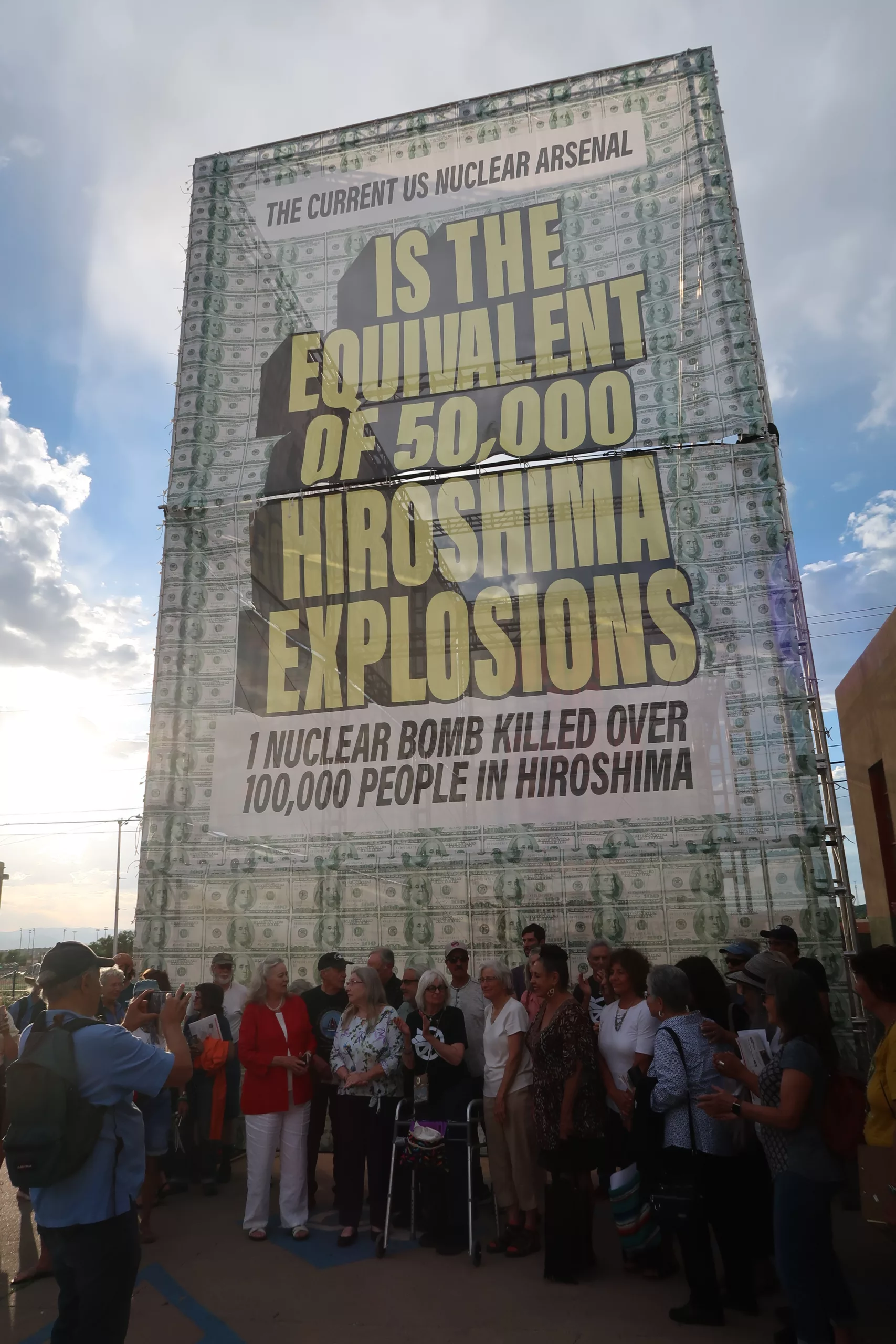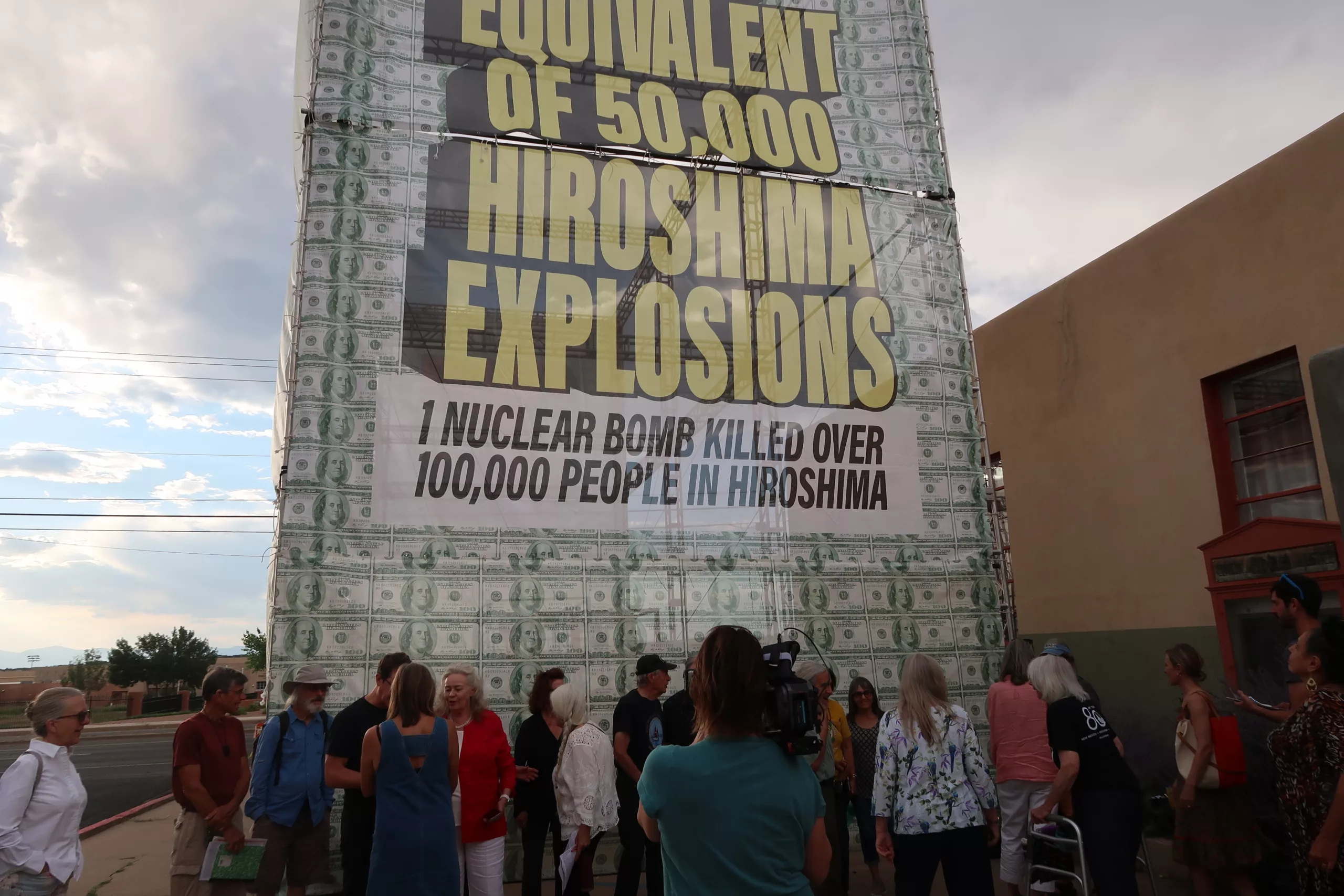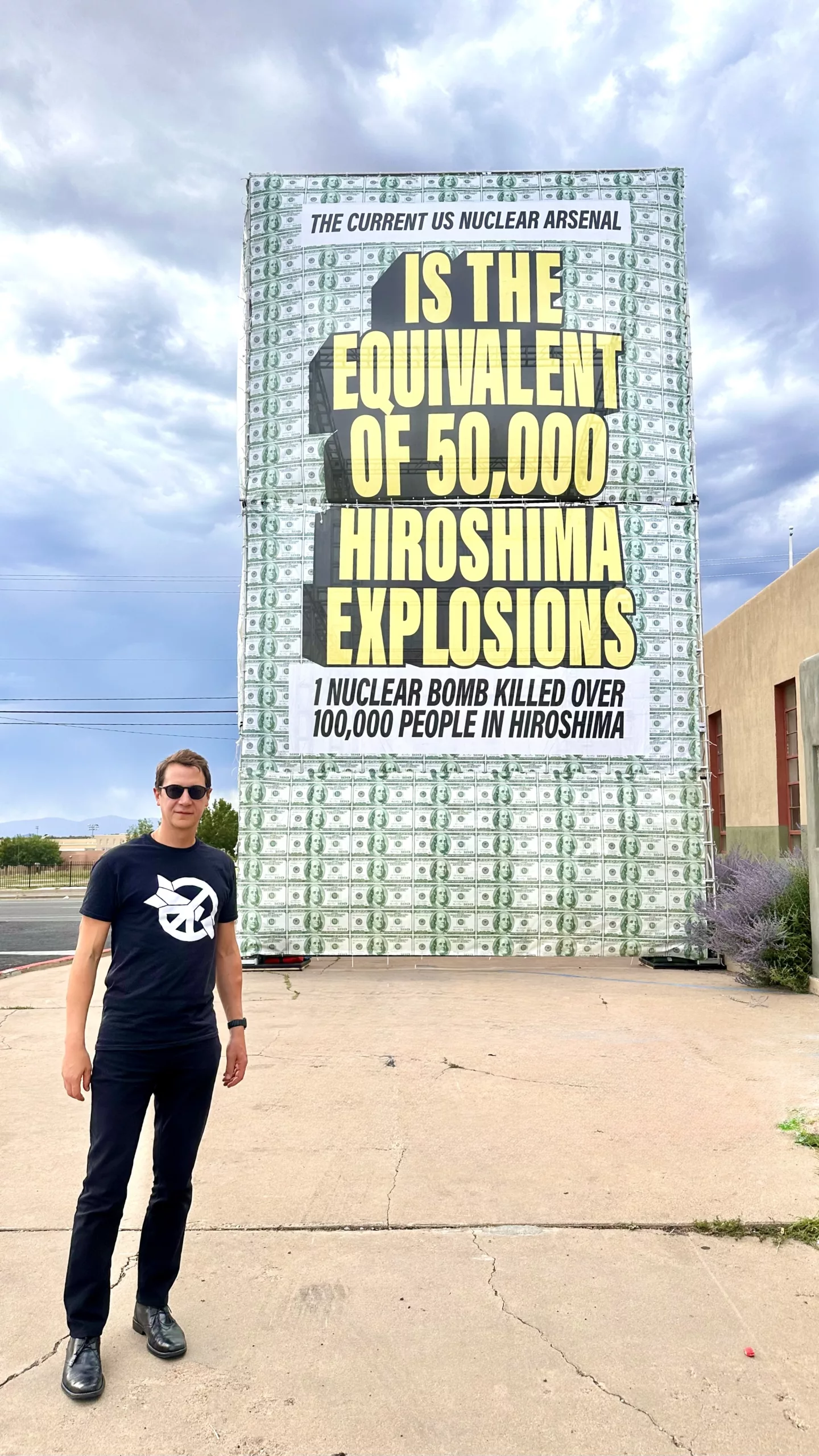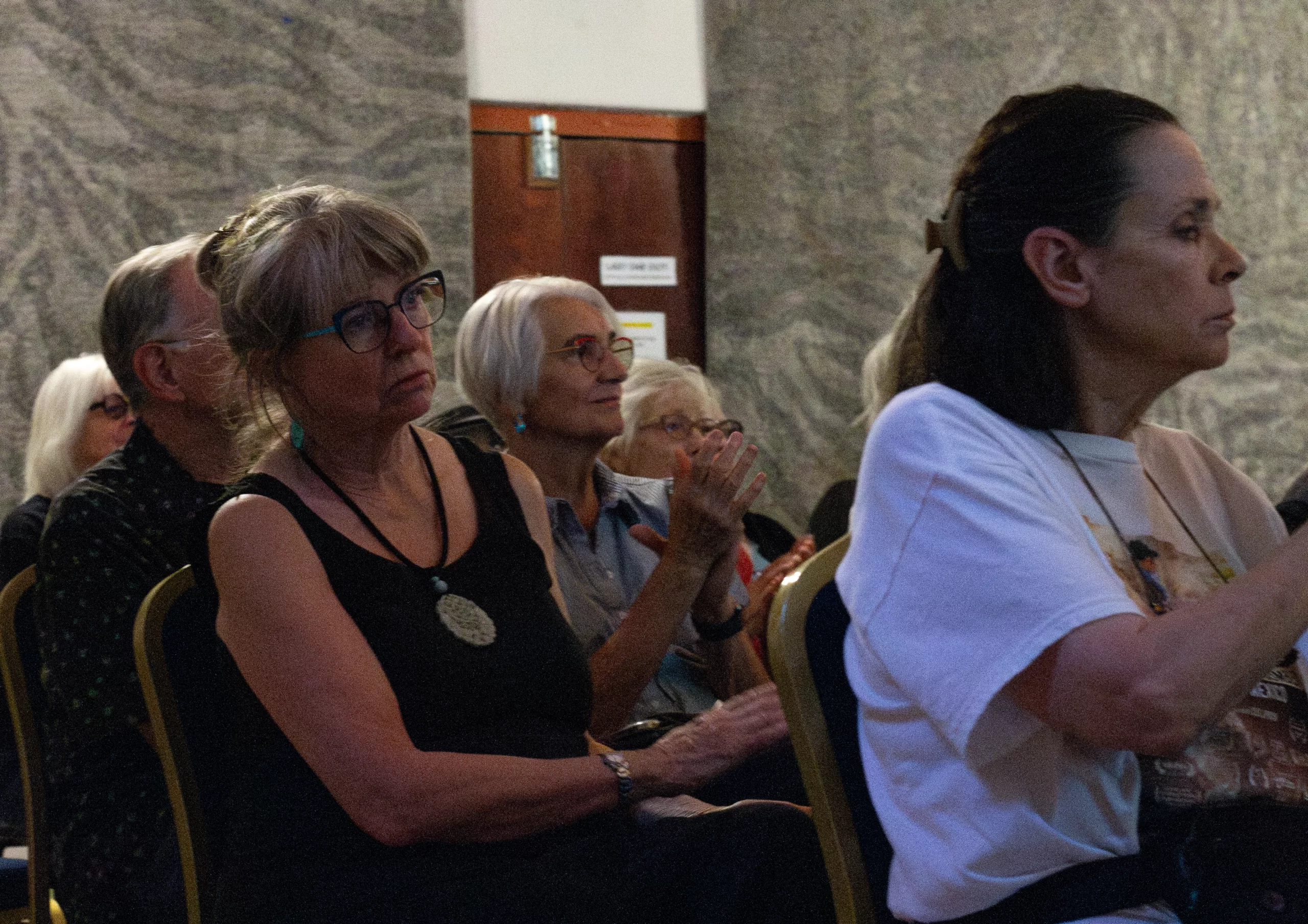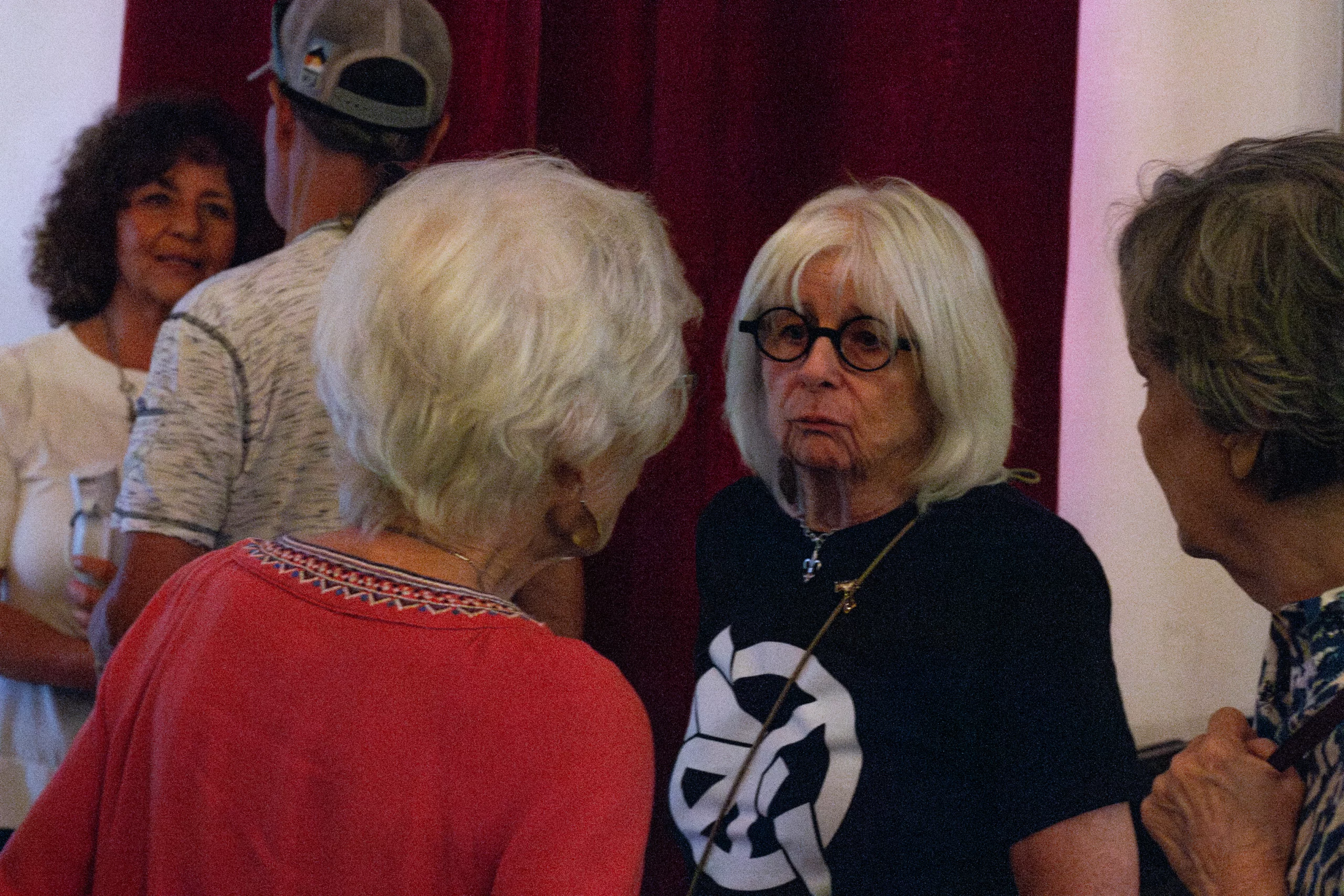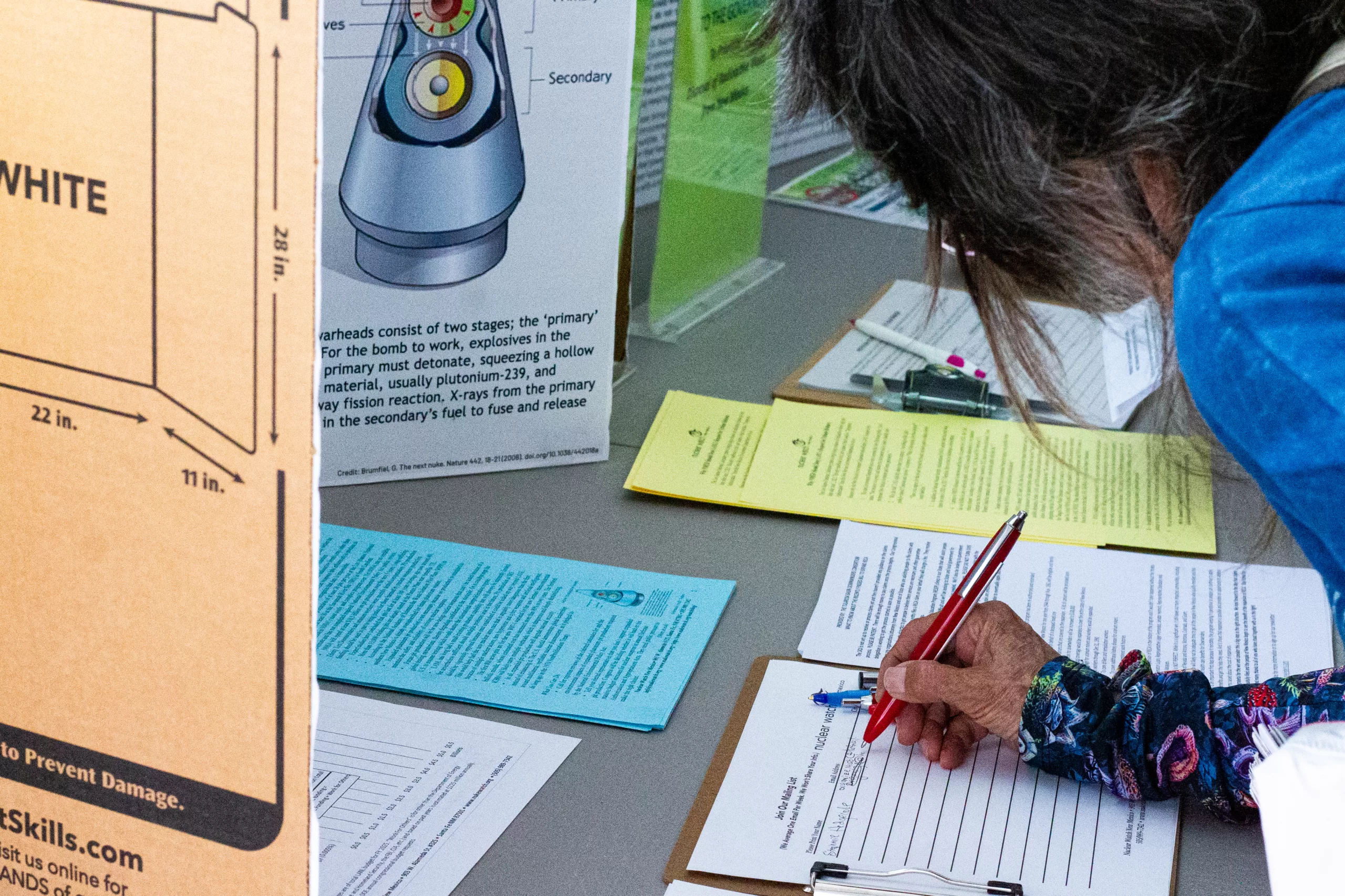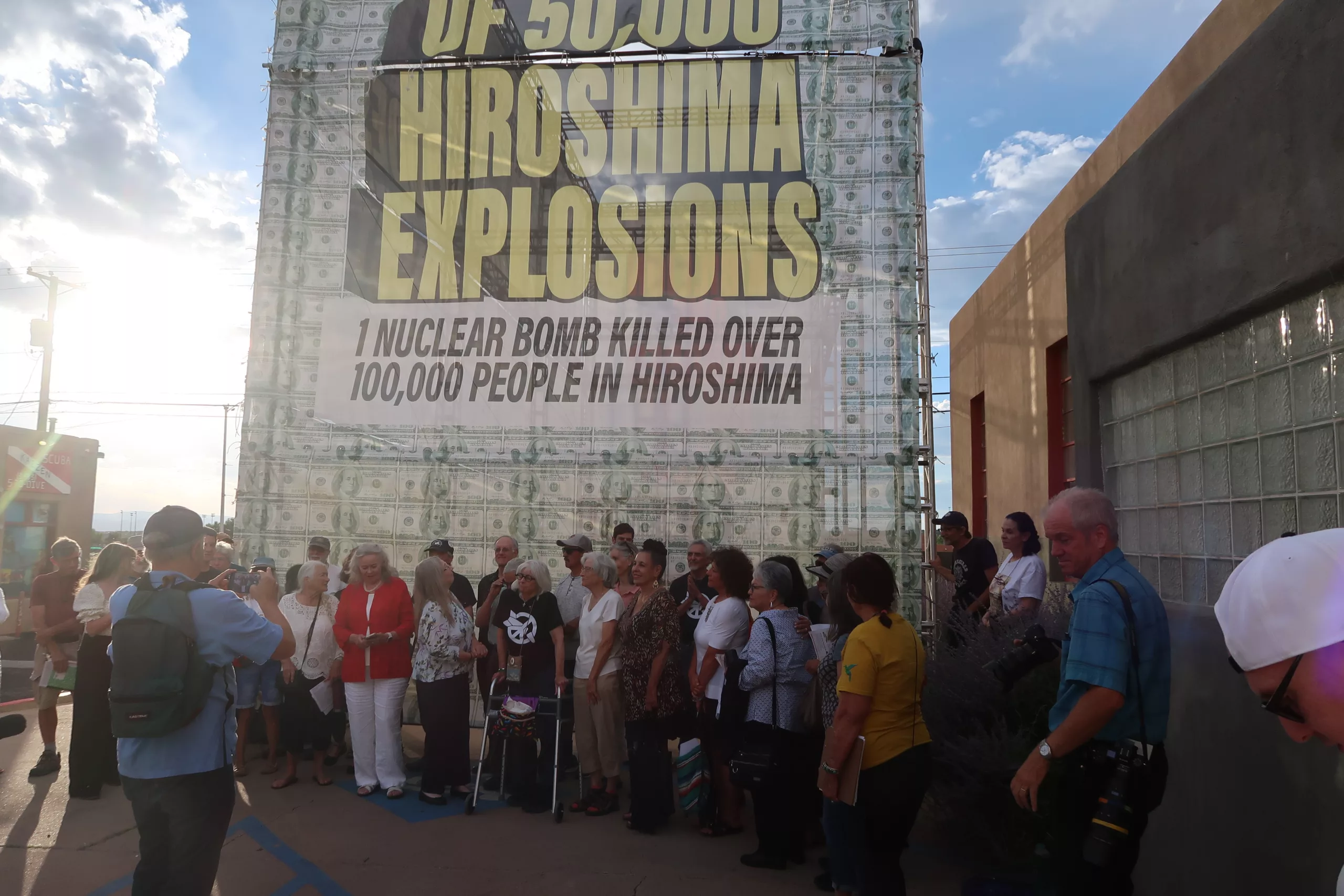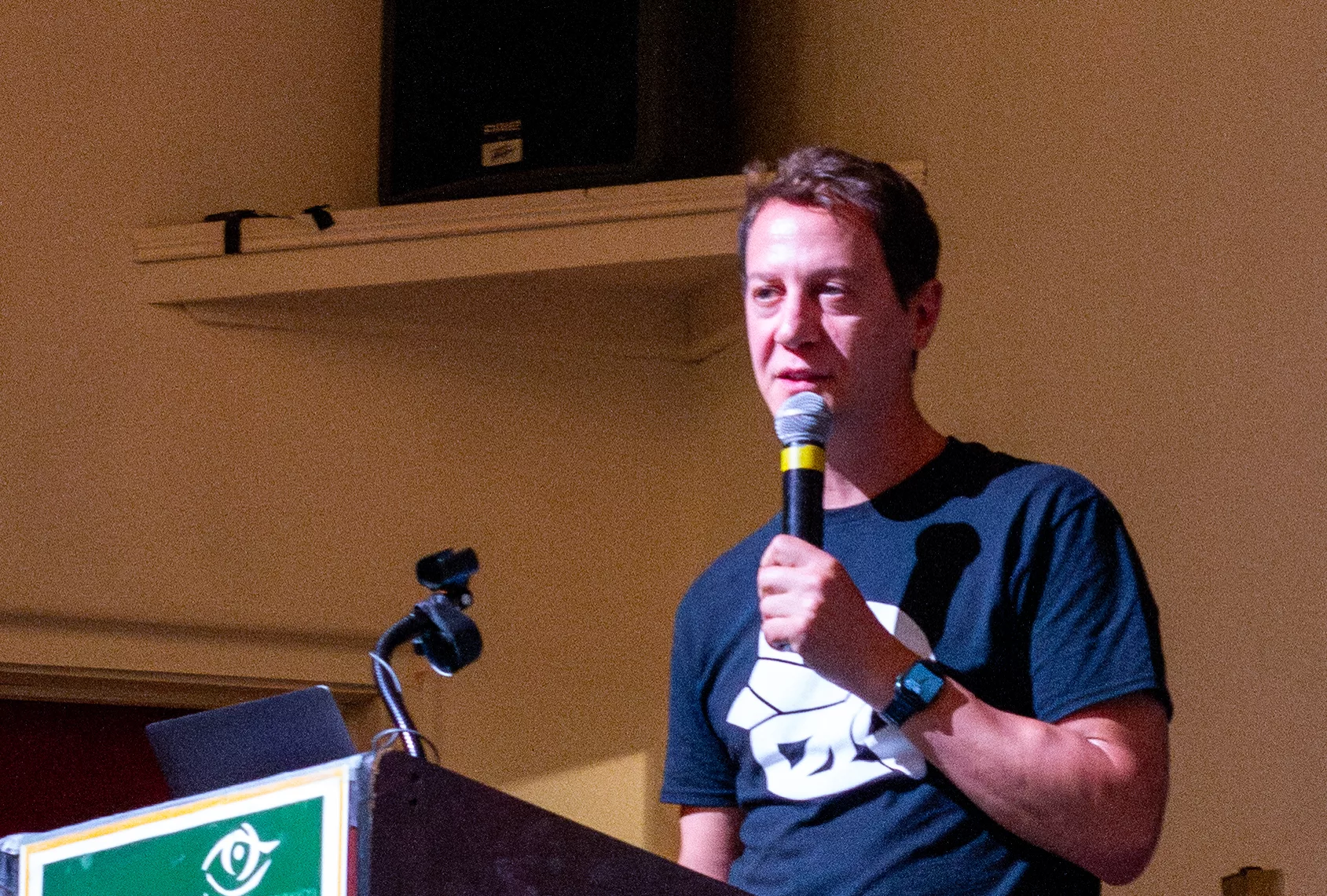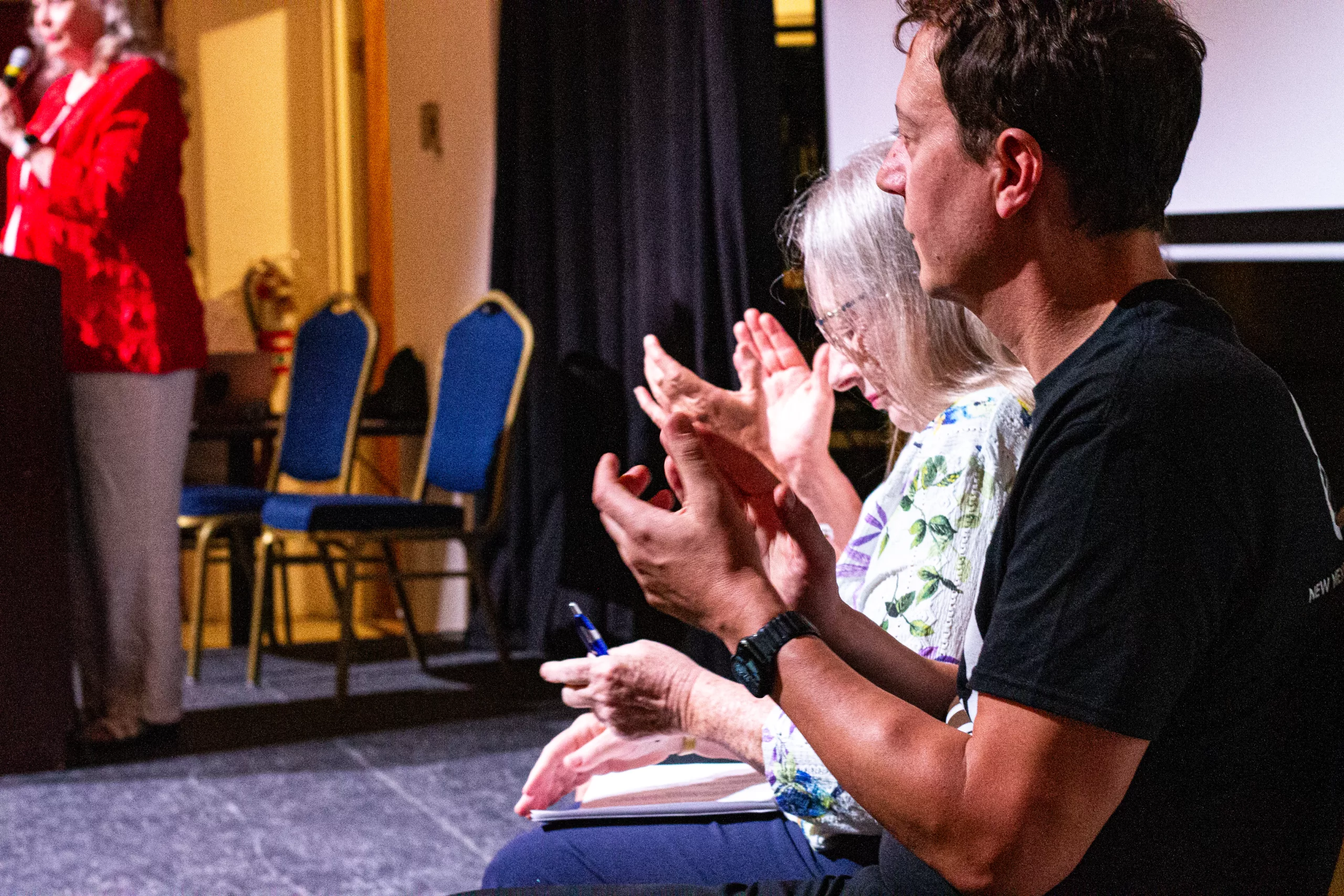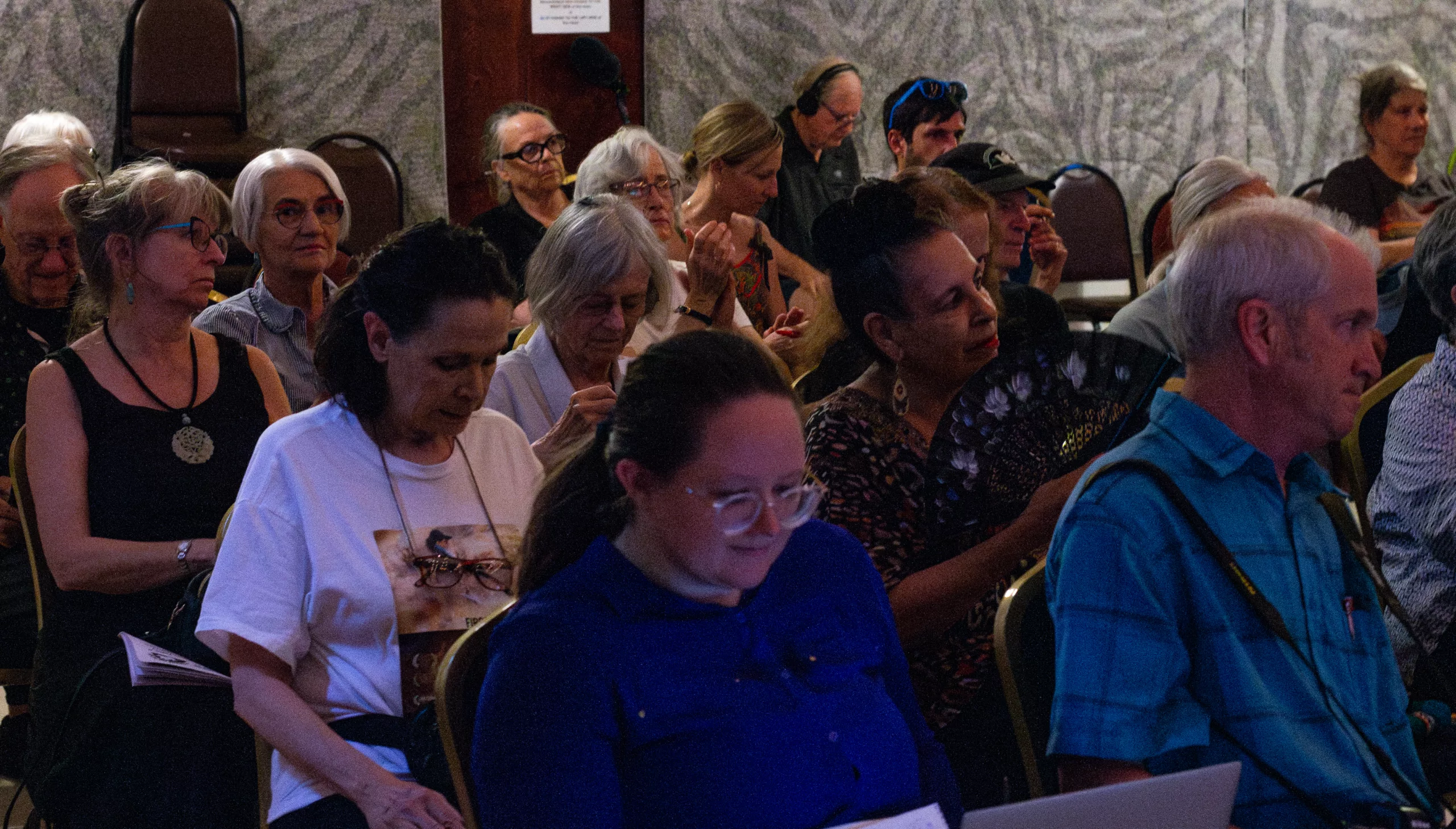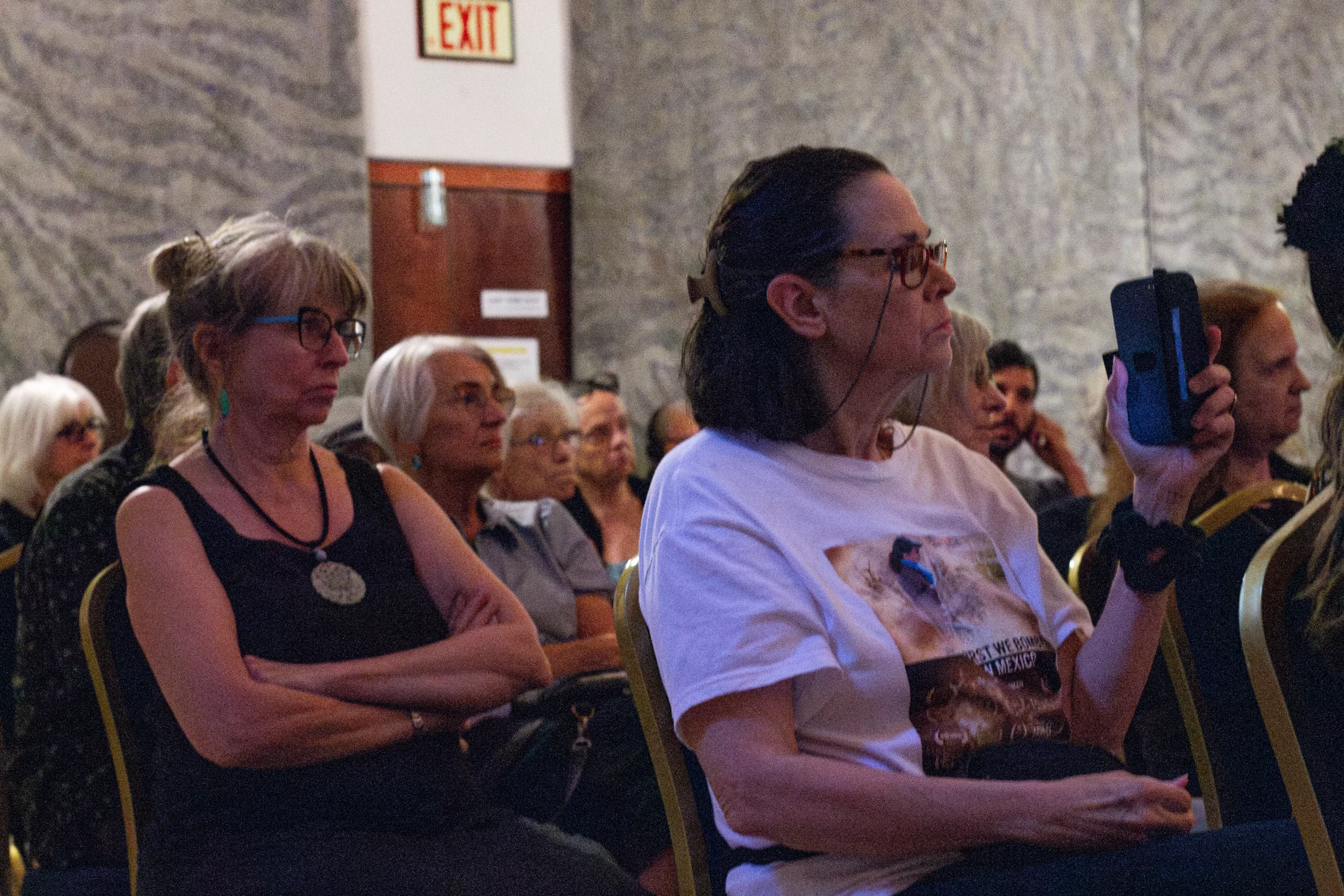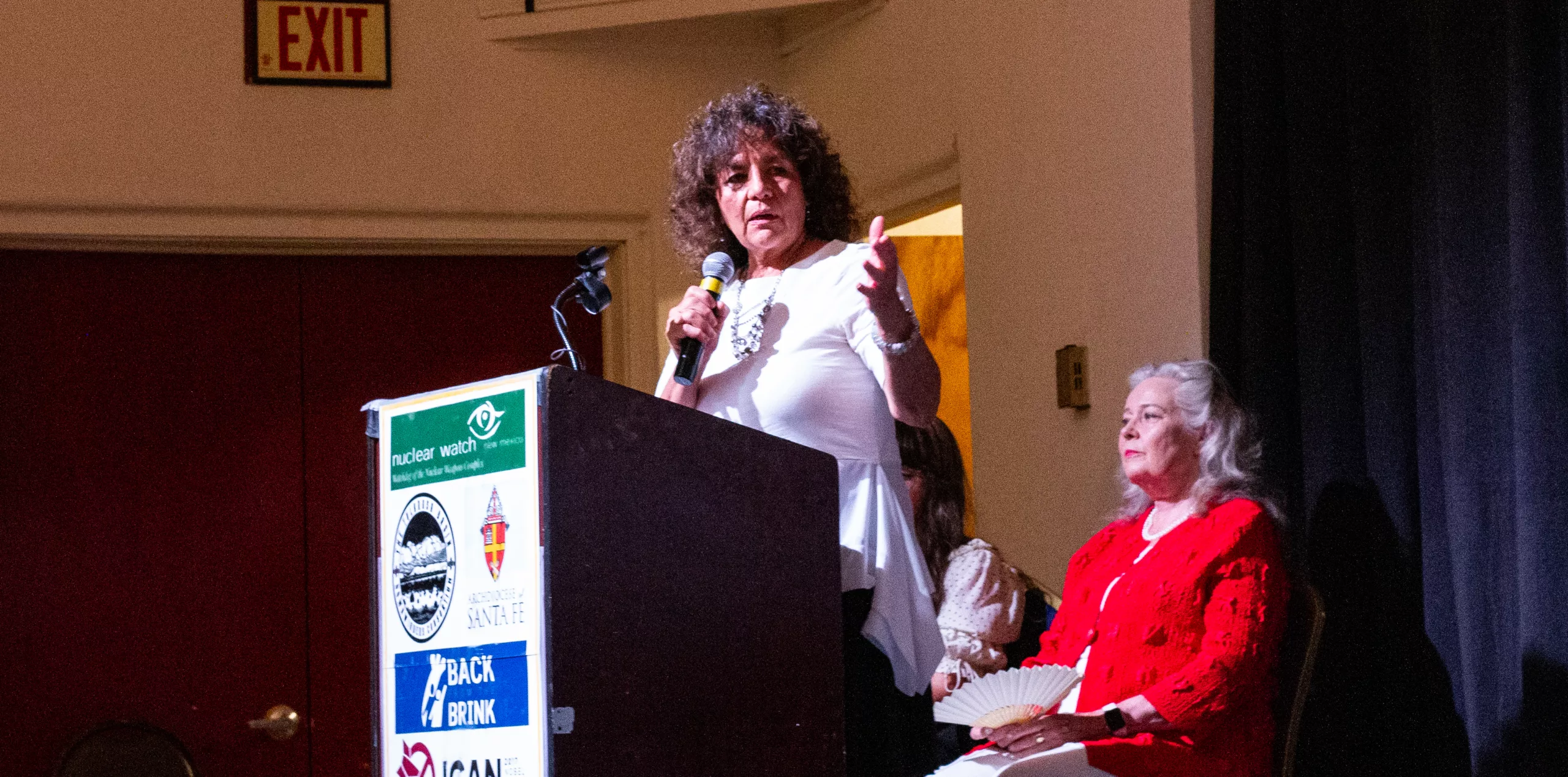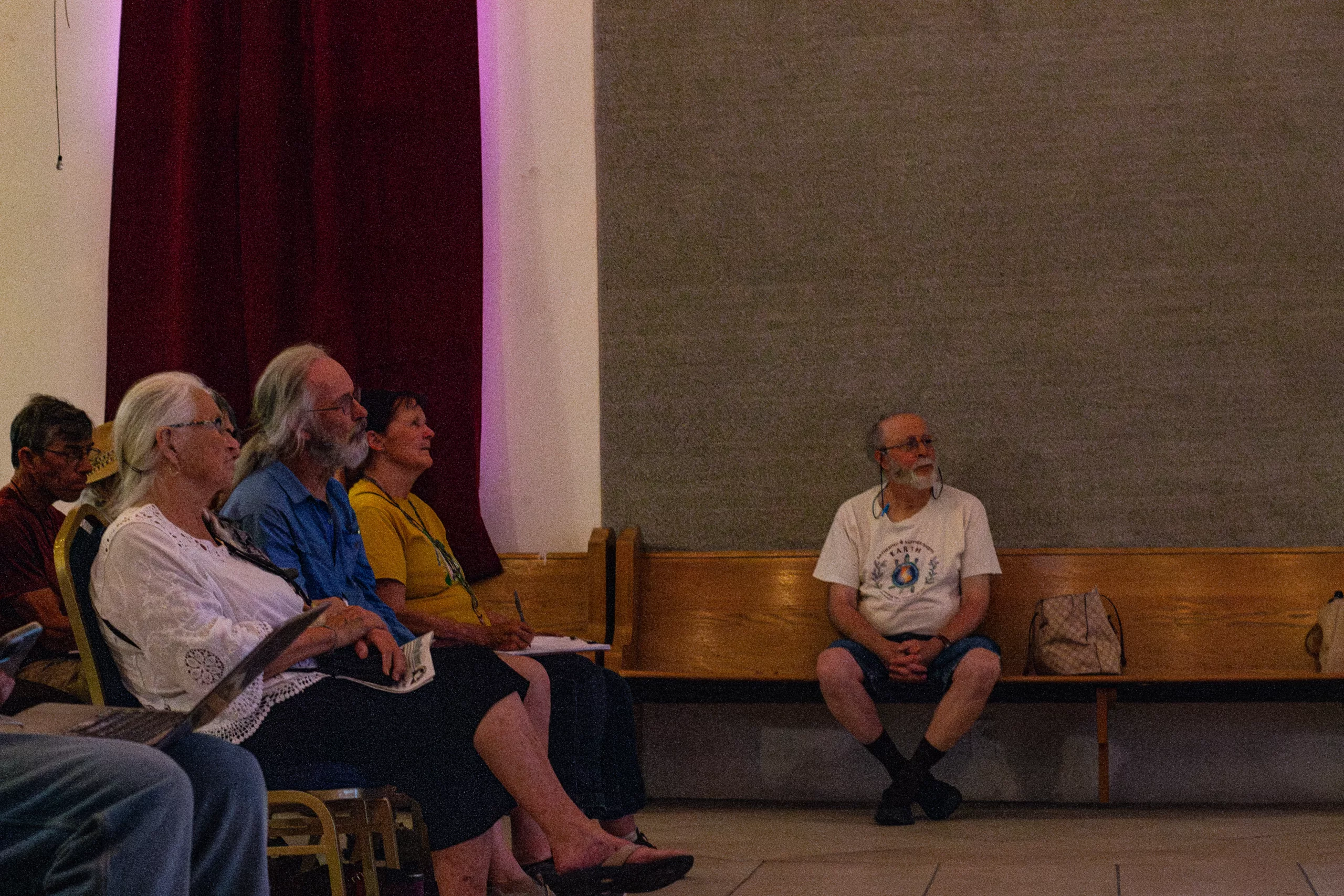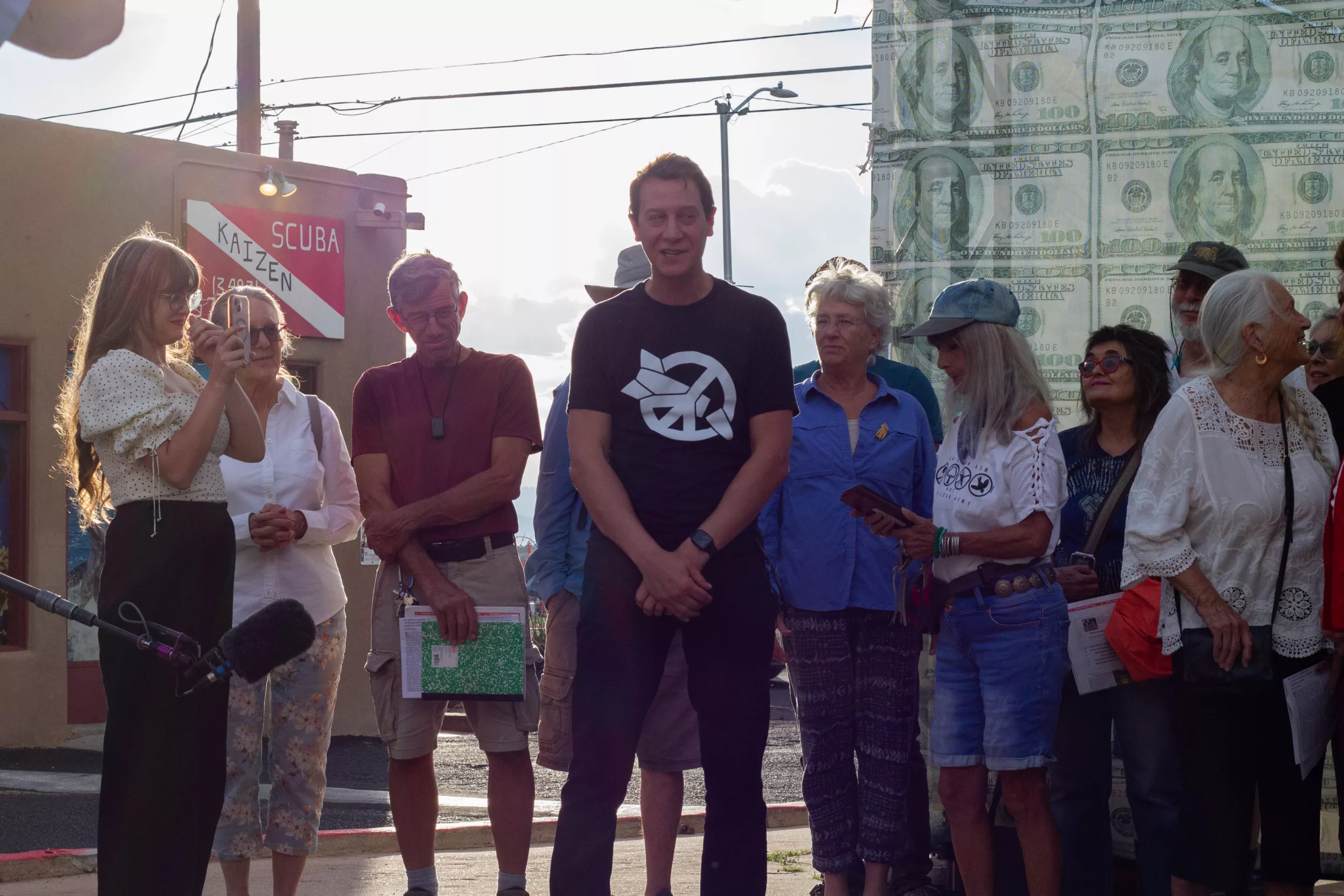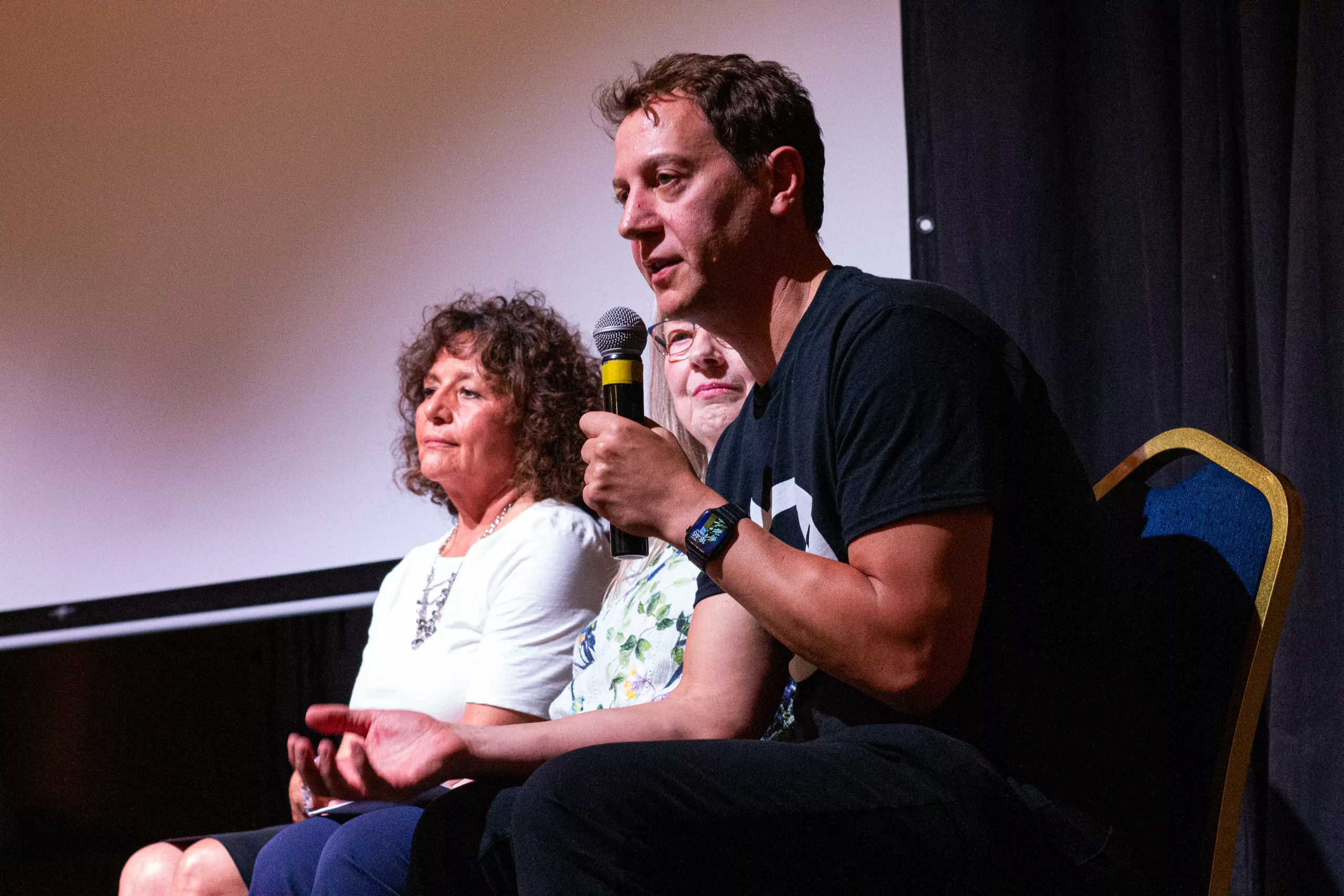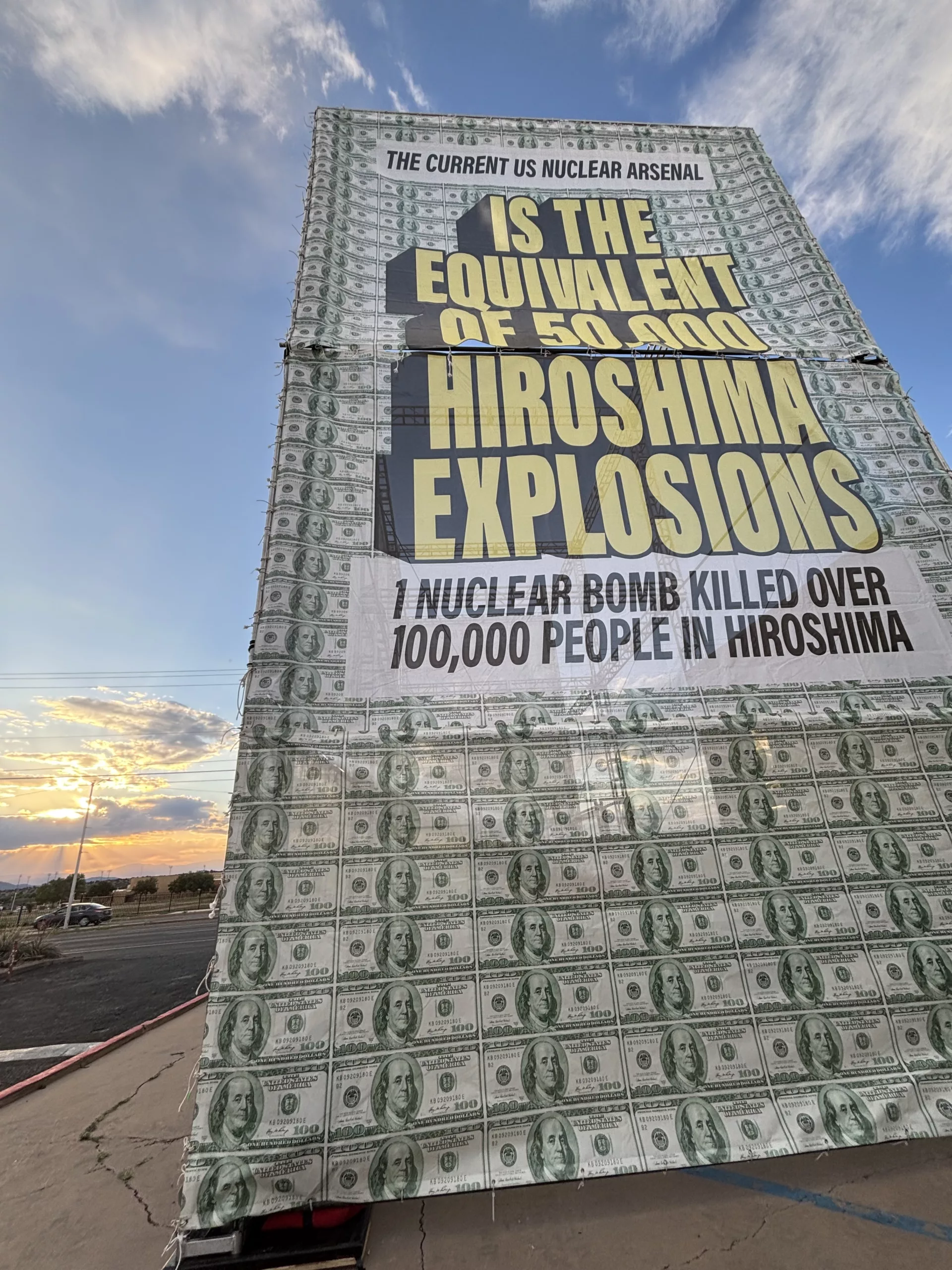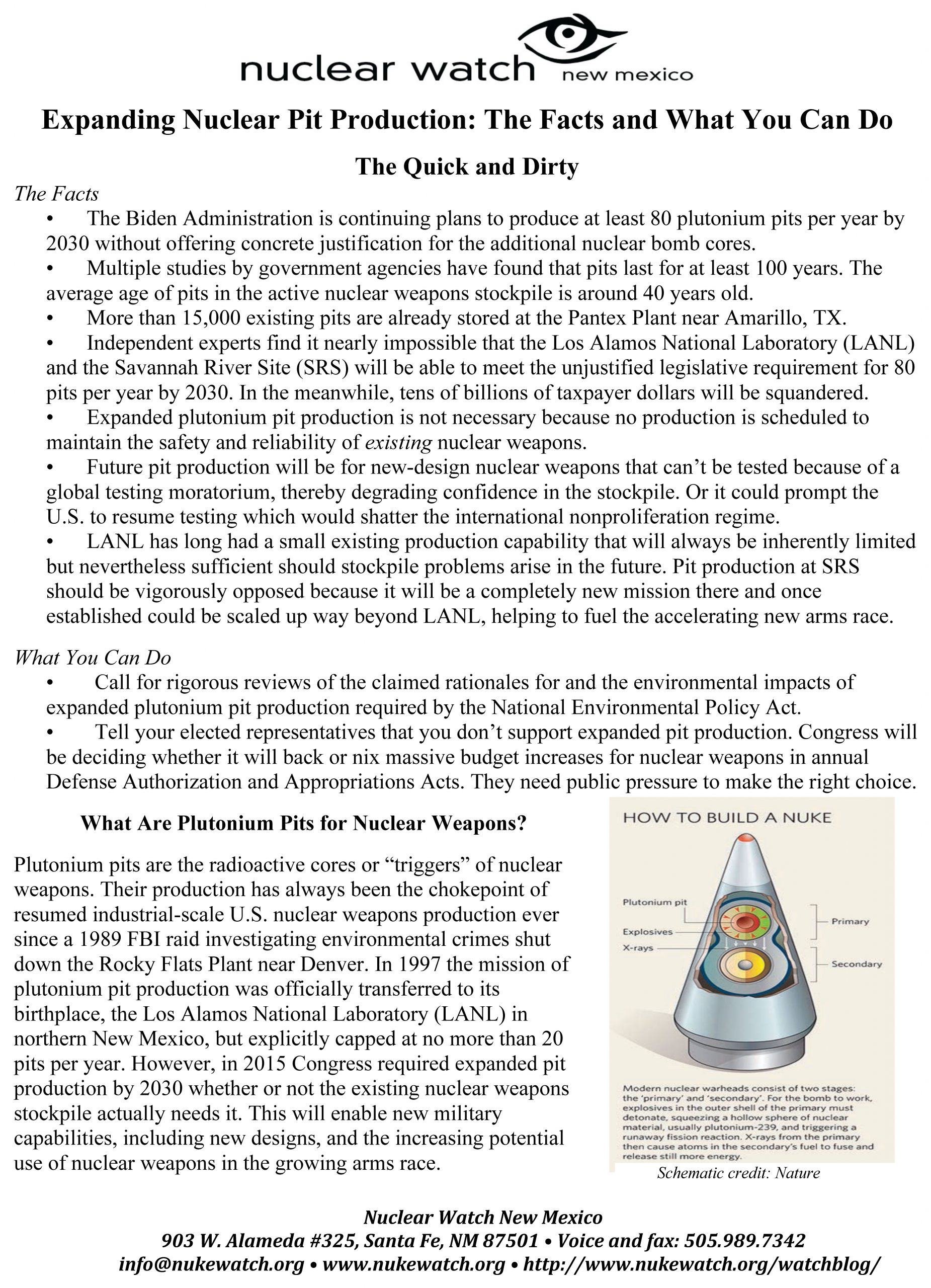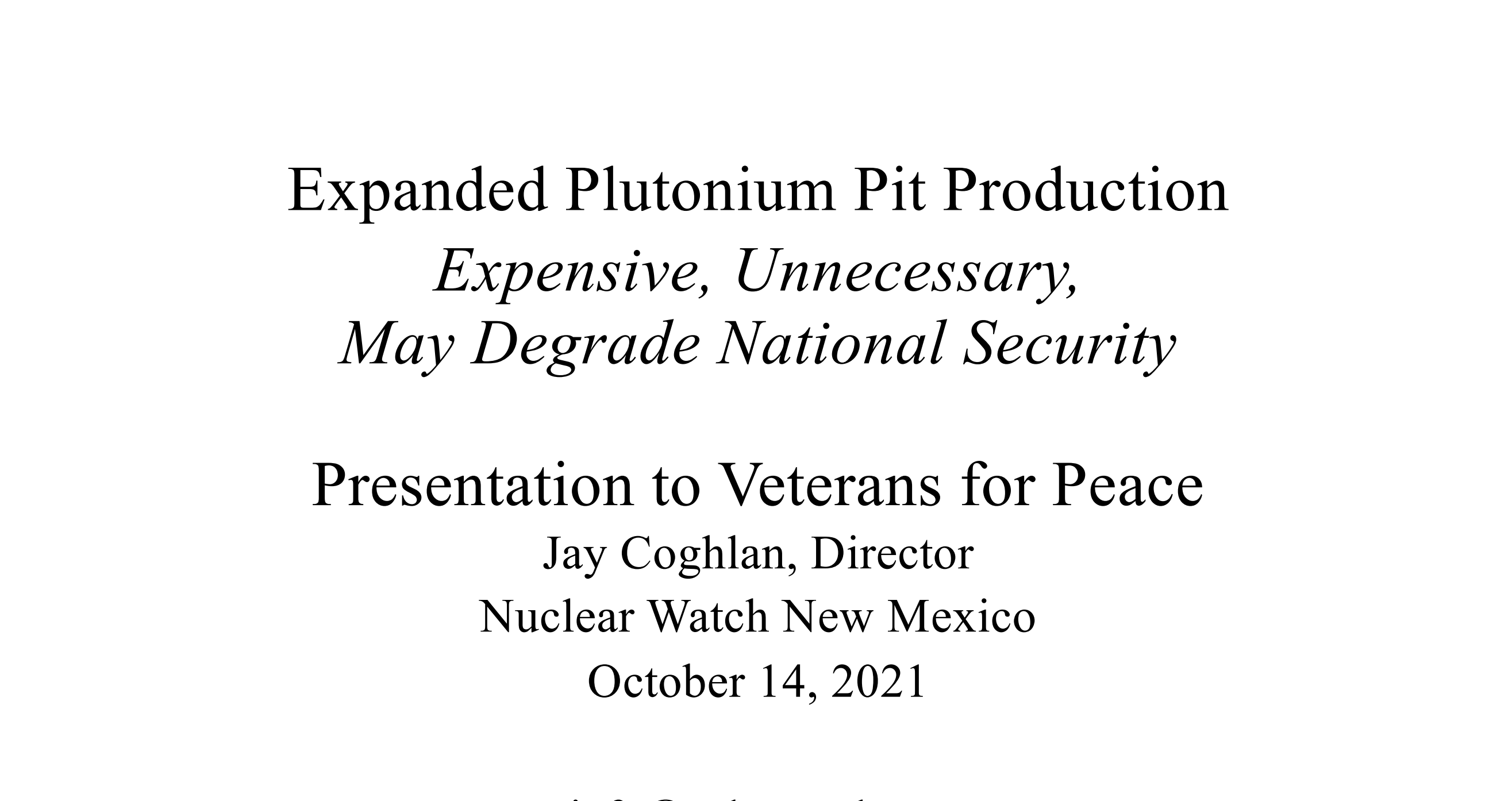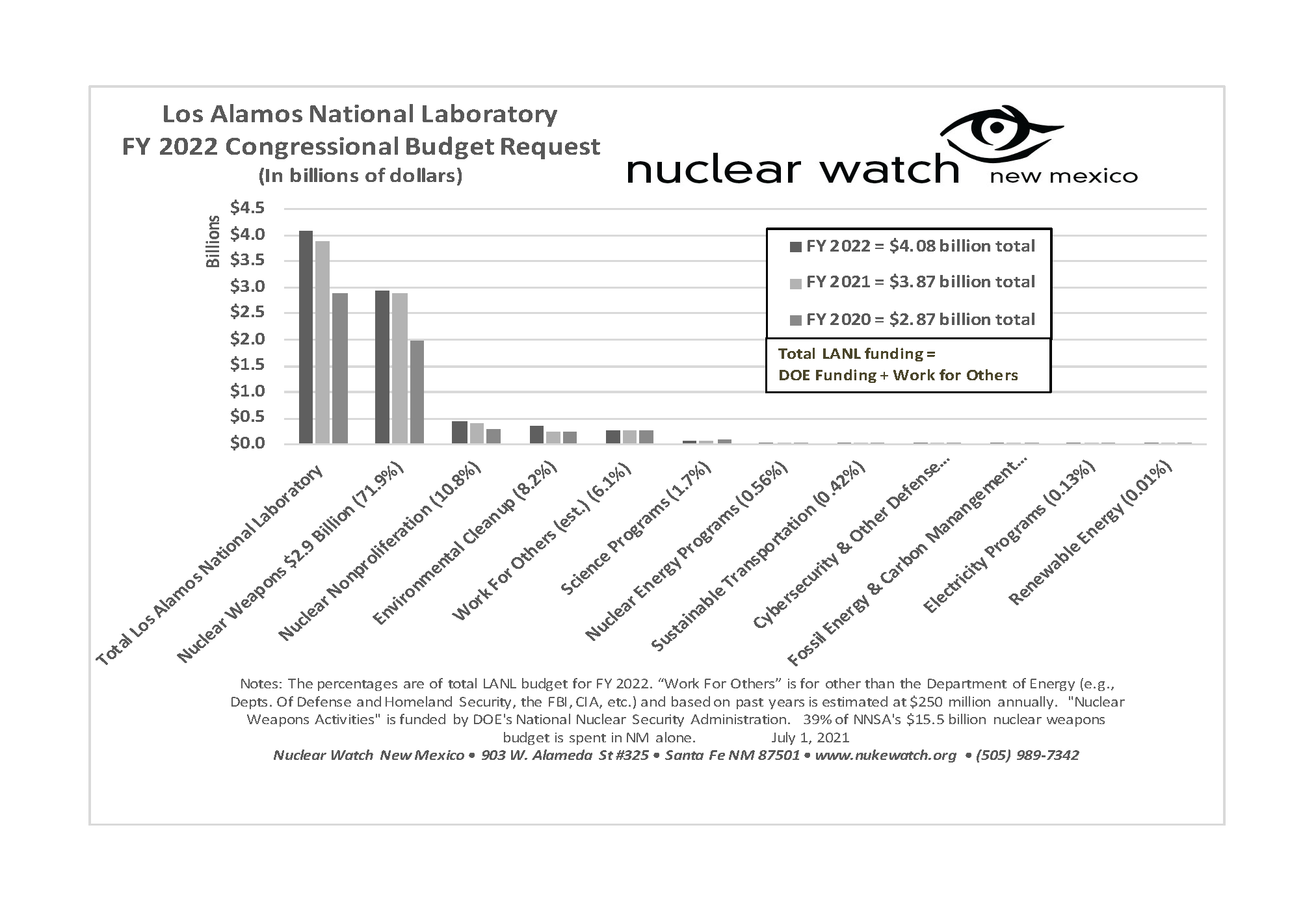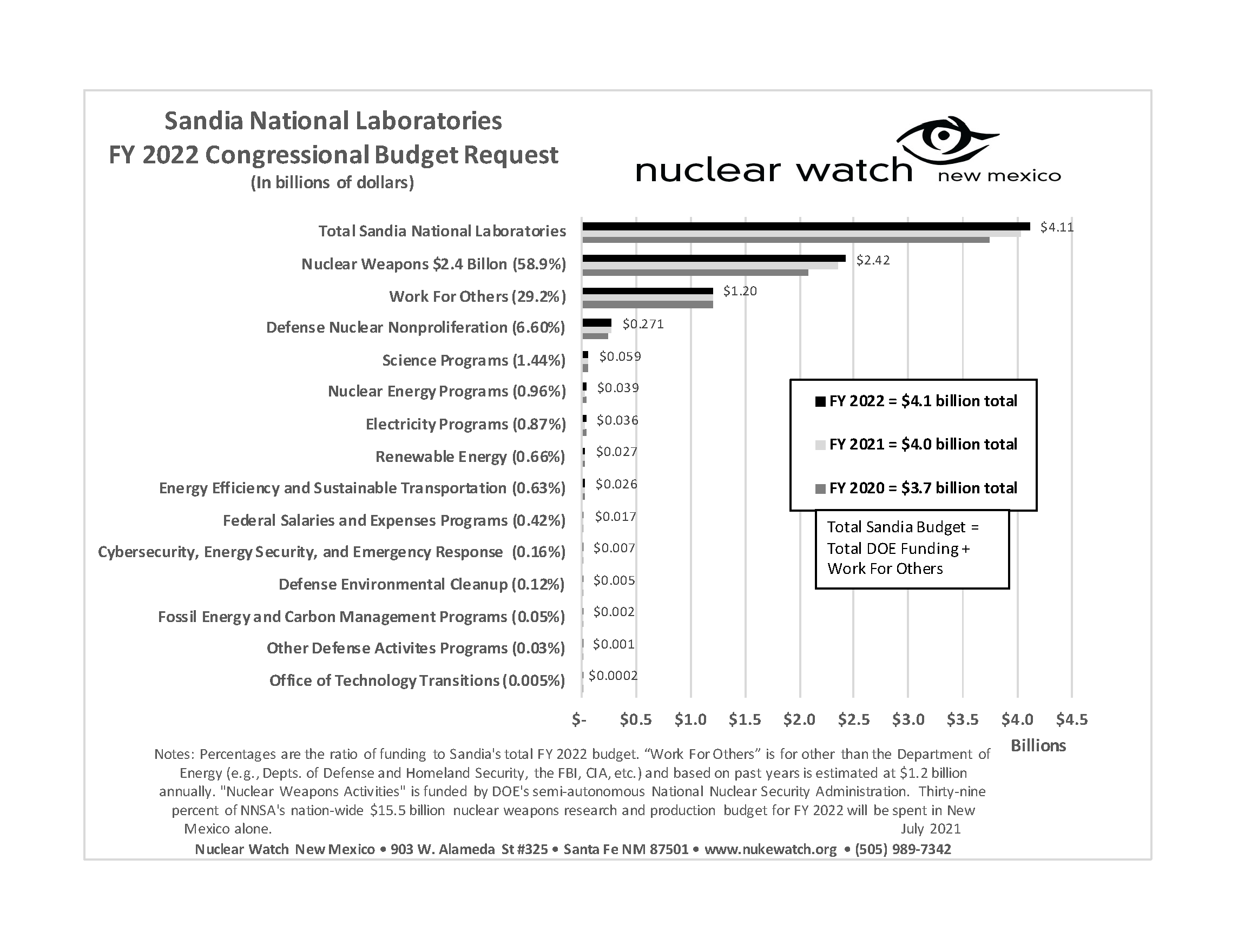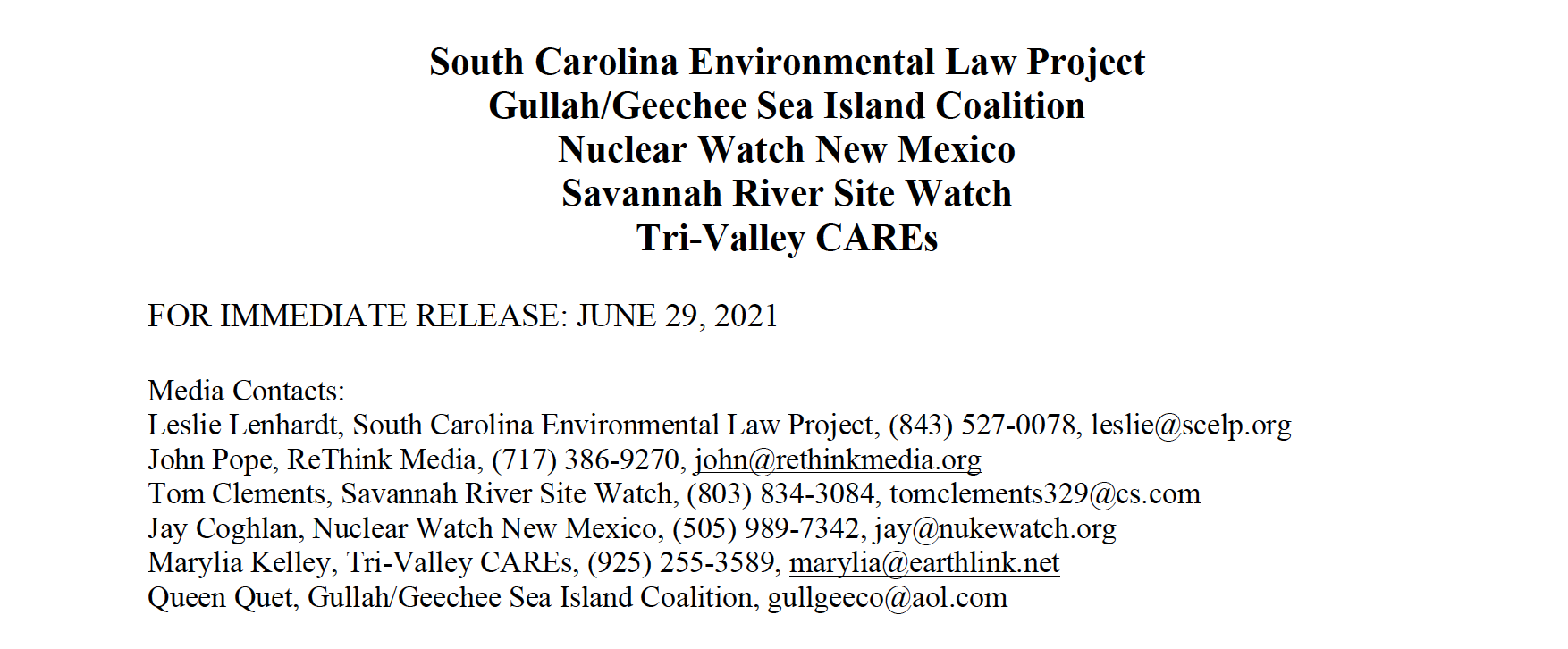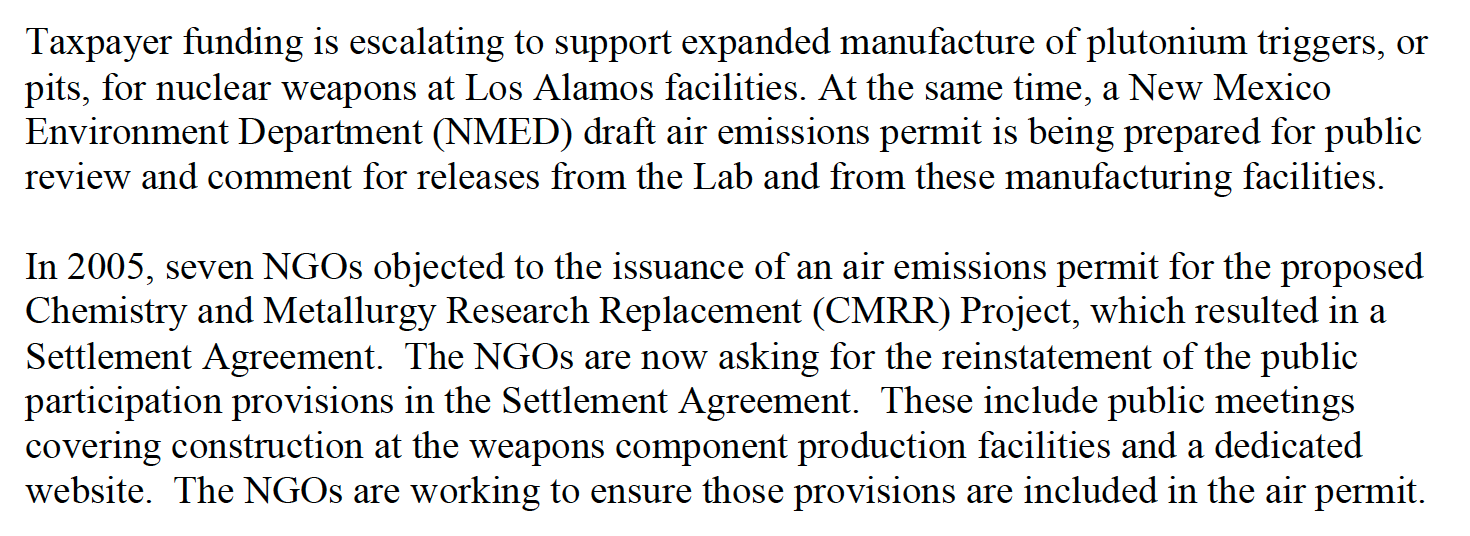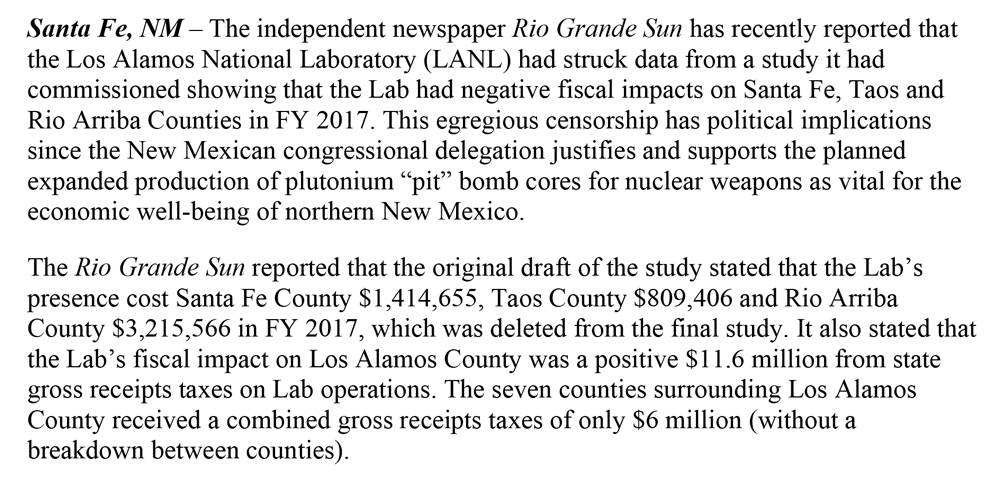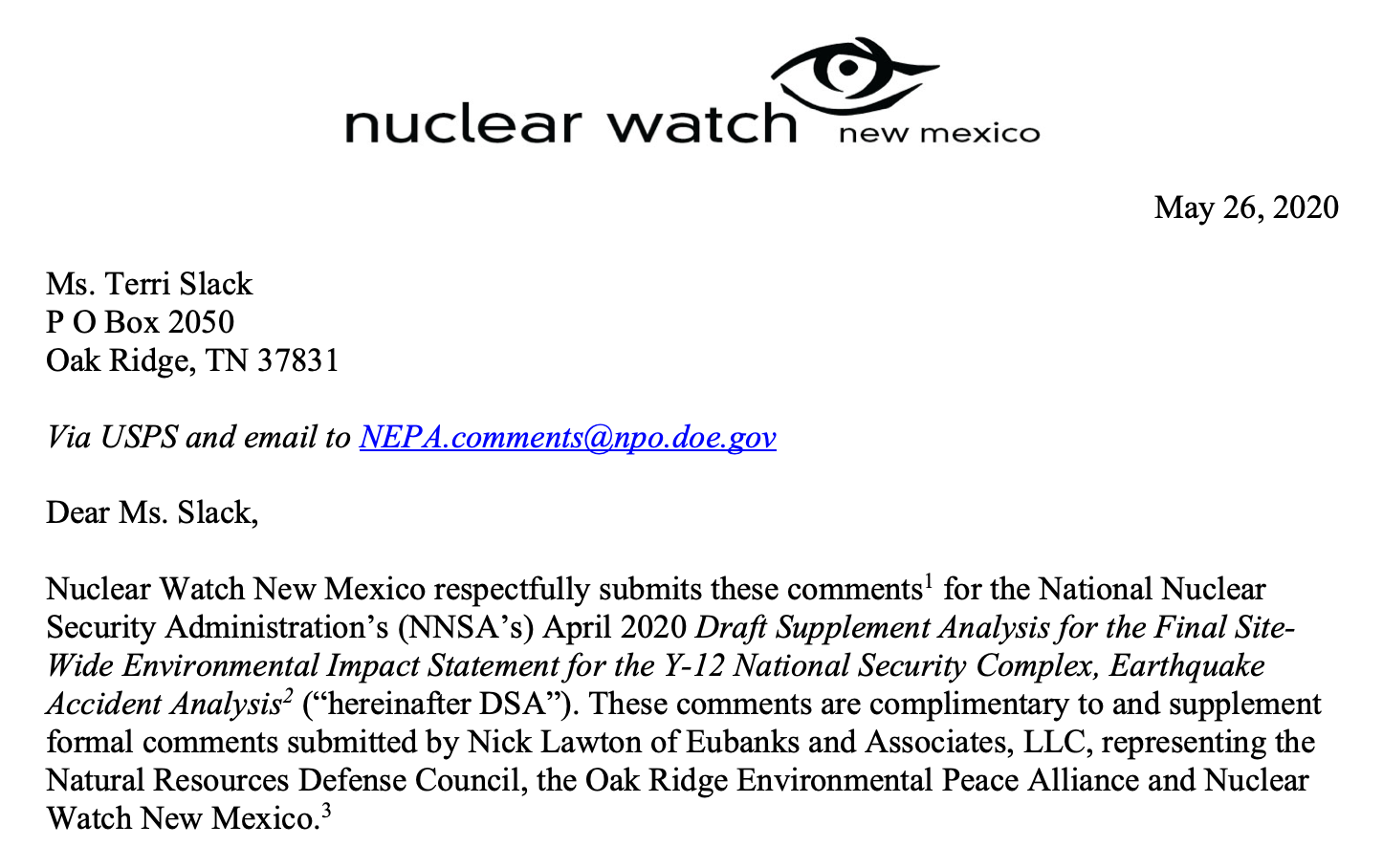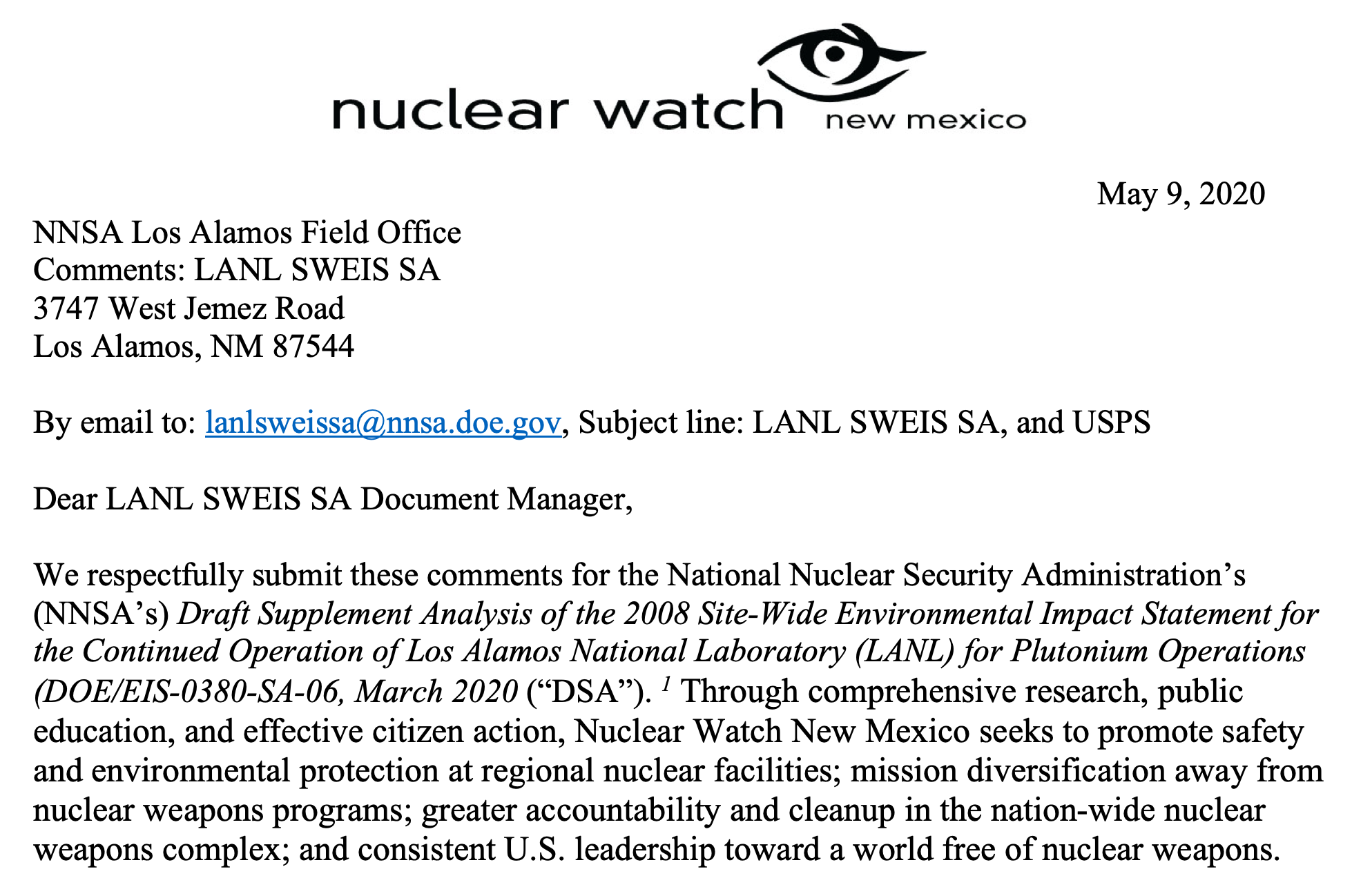ALL RECENT WORK
Lab Chromium Contamination Confirmed on San Ildefonso Pueblo Land
Comprehensive Cleanup Needed Instead of More Nuclear Weapons
FOR IMMEDIATE RELEASE, November 14, 2025
Contact: Jay Coghlan, 505.989.7342, c. 505.470.3154 | Email
Contact: Scott Kovac, 505.316.4148 | Email
Santa Fe, NM – The New Mexico Environment Department has announced:
“A toxic chromium plume from Los Alamos National Laboratory has spread beyond Lab boundaries onto Pueblo de San Ildefonso land for the first time, with contamination exceeding state groundwater standards… These new results are conclusive evidence that the U.S. Department of Energy’s efforts to contain the chromium plume have been inadequate.”
In reality, chromium groundwater contamination probably migrated beyond the LANL/San Ildefonso Pueblo boundary long ago, with past Lab maps of the plume “magically’ stopping at the border. In the past, tribal leadership has commented that it was fortunate that the contamination stopped there, but that any future indications of groundwater contamination on Pueblo land could have serious consequences. The San Ildefonso Pueblo is a sovereign Native American tribal government.
As late as the late 1990s the Lab was falsely claiming that groundwater contamination was impossible because underlying volcanic tuff is “impermeable.” [1] This ignored the obvious fact that the Parajito Plateau is heavily seismically fractured, providing ready pathways for contaminant migration to deep groundwater. By 2005 even LANL acknowledged that continuing increasing contamination of the regional aquifer is inevitable.[2] Some 300,000 northern New Mexicans rely upon the aquifer for safe drinking water. The potential serious human health effects (including cancer) caused by chromium contamination was the subject of the popular movie Erin Brockovich.
Trump Orders Nuclear Weapons Testing for New Nuclear Arms Race
New Plutonium “Pit” Bomb Cores at Los Alamos Lab Could Make It Real
FOR IMMEDIATE RELEASE, October 30, 2025
Contact: Jay Coghlan, 505.989.7342, c. 505.470.3154 | Email
Santa Fe, NM – Just minutes before meeting with Chinese President Xi Jinping, Trump posted on his Truth Social media platform that “Because of other countries testing programs, I have instructed the Department of War to start testing our Nuclear Weapons on an equal basis. That process will begin immediately.” House Speaker Mike Johnson soon followed on CNN saying, “I think it is an obvious and logical thing to ensure that our weapons systems work.”
No other countries are currently testing nuclear weapons (the last was by North Korea in 2017). Further, any nuclear weapons tests by the U.S. would be performed by the Department of Energy (whose last test was in 1992), not the Department of War (until recently the Department of Defense). Trump was likely referring to Vladimir Putin’s recent claims of a new nuclear powered cruise missile and a tsunami-causing nuclear-armed torpedo that could threaten America’s coastal cities. In addition, China is dramatically expanding its own fleet of intercontinental ballistic missiles.
But central to all this is the U.S.’ own $2 trillion “modernization” program that will rebuild every nuclear warhead in the planned stockpile with new military capabilities and produce new-design nuclear weapons as well. This so-called modernization program will also build new nuclear weapons production facilities expected to be operational until ~2080, and buy new missiles, subs, and bombers from the usual rich defense contractors, all to keep nuclear weapons forever.
VIEW THE RECORDING: Santa Fe Ecumenical Conversations Towards Nuclear Disarmament at Santa Maria de la Paz Catholic Community – Monday, October 27
Archbishop John C. Wester and NukeWatch New Mexico presented a special evening at Santa Maria de la Paz Catholic Community on Monday, October 27, from 6:00 to 8:00 p.m. MT. Following a presentation from NukeWatch executive director Jay Coghlan on U.S. nuclear weapons “modernization,” the Archbishop shared reflections from his pastoral letter, Living in the Light of Christ’s Peace, and speak about the importance of dialogue and hope in working toward nuclear disarmament.
View the recording at https://www.youtube.com/watch?v=9LFmQzMoJds&t=1s
Full Event Recording: Press Conference & Commemoration – Hiroshima Atomic Bombing 80th Anniversary Event (August 6, 2025)
Nobel Peace Conference: A Message to Humanity – Featuring a Video with Nuclear Watch New Mexico on Our Plutonium Pit Federal Lawsuit to Show What Citizen Action on the Legal Front Can Accomplish for Nuclear Disarmament
The video above shows the entire conference (but begins playing at our portion); to view our video alone on YouTube CLICK HERE or watch below!
LANL Expands Nuclear Bomb Production, Rejects Cleanup, Still Plans to Release Tritium
FOR IMMEDIATE RELEASE, August 3, 2025
Contact: Scott Kovac – 505.316.4148 | Email
Santa Fe, NM – Eighty years after the first radioactive waste was buried at the Los Alamos National Laboratory (LANL), Lab officials have released plans to “defer” cleanup of one of the older radioactive dumps. Material Disposal Area C (“Area C”) is an 11.8-acre site that was active from 1948 to 1974. It contains metals, hazardous constituents, and radioactively and chemically contaminated materials in six unlined disposal pits and 108 shafts. The total waste and fill in the pits and shafts are estimated at 198,104 cubic meters. Area C also has a serious gas plume of industrial solvents. Given the amount of long-lived plutonium wastes that are likely to be in Area C, leaving it buried 25 feet deep in a landfill rated for only 1,000 years is not acceptable.
On June 18, 2025, the Department of Energy (DOE) sent the New Mexico Environment Department (NMED) a letter outlining its plans to “defer corrective action” (i.e. cleanup) at Area C. It stated that the dump “is associated with active Facility operations and will be deferred from further corrective action under [NMED’s] Consent Order [governing cleanup] until MDA C is no longer associated with active Facility operations.”
Planned Nuclear Weapons Activities Increase to 84% of Lab’s Budget; All Other Programs Cut
FOR IMMEDIATE RELEASE, June 30, 2025
Contact: Scott Kovac – 505.316.4148 | Email
The Department of Energy and Los Alamos National Laboratory have released the LANL congressional budget request for the upcoming fiscal year, 2026, which begins on October 1, 2025. The request shows a continued major increase and expansion of the plutonium pit production program (plutonium pits are the triggers of nuclear weapons). LANL is frantically trying to increase its capabilities to begin making 30 pits per year by 2028.
NukeWatch created the above chart to give a visual of how taxpayer dollars are annually spent at the Lab. LANL’s FY 2026 total budget request is $6 billion, which is a 17% increase over the FY 2025 $5.2 billion total budget. This includes a 24% increase in the nuclear weapons budget over FY 2025.
Nuclear Weapons Activities represent 84% of LANL’s total budget.
Under the headline of “Unleashing a Golden Era of Energy Dominance and Energy Innovation and Protecting the Nation,” the nuclear weapons budget is increasing dramatically. As a baseline, 65% of the Department’s proposed $46 billion budget is earmarked for its semi-autonomous nuclear weapons agency, the National Nuclear Security Administration (NNSA). In turn, more than 80% of NNSA’s proposed FY 2026 funding is for its nuclear weapons research and production programs, with a 25% funding increase over FY 2025.
Planned Nuclear Weapons Activities Increase to 84% of Lab’s Budget; All Other Programs Cut

The Department of Energy and Los Alamos National Laboratory have released the LANL congressional budget request for the upcoming fiscal year, 2026, which begins on October 1, 2025. The request shows a continued major increase and expansion of the plutonium pit production program (plutonium pits are the triggers of nuclear weapons). LANL is frantically trying to increase its capabilities to begin making 30 pits per year by 2028.
NukeWatch created the attached chart to give a visual of how taxpayer dollars are annually spent at the Lab. LANL’s FY 2026 total budget request is $6 billion, which is a 17% increase over the FY 2025 $5.2 billion total budget. This includes a 24% increase in the nuclear weapons budget over FY 2025.
Nuclear Weapons Activities represent 84% of LANL’s total budget.
Under the headline of “Unleashing a Golden Era of Energy Dominance and Energy Innovation and Protecting the Nation,” the nuclear weapons budget is increasing dramatically. As a baseline, 65% of the Department’s proposed $46 billion budget is earmarked for its semi-autonomous nuclear weapons agency, the National Nuclear Security Administration (NNSA). In turn, more than 80% of NNSA’s proposed FY 2026 funding is for its nuclear weapons research and production programs, with a 25% funding increase over FY 2025.
Due to so-called “reconciliation” funding, “Total Weapons Activities” increase to just under $30 billion. This adds up to a 53% increase above FY 2025 for the nuclear weapons research and production programs across the country. To help pay for this, national nonproliferation and cleanup programs are being cut by 5%, science by 14%, cybersecurity and emergency response by 25%, and energy efficiency and renewable energy programs by 74%.
NNSA’s Nuclear Weapons Programs Slated for 53% Increase
FOR IMMEDIATE RELEASE, June 3, 2025
Contact: Jay Coghlan – 505.989.7342 | Email
Santa Fe, NM – Topline budget figures for the Department of Energy (DOE) have been released under the headline of “Unleashing a Golden Era of Energy Dominance and Energy Innovation and Protecting the Nation.” But as a baseline, 65% of the Department’s proposed $46 billion budget is earmarked for its semi-autonomous nuclear weapons agency, the National Nuclear Security Administration (NNSA). In turn, more than 80% of NNSA’s proposed FY 2026 funding is for its nuclear weapons research and production programs, with a 25% funding increase over FY 2025.
But that is not all. The Trump Administration is adding another $4.8 billion from so-called “reconciliation” funding, bringing NNSA’s “Total Weapons Activities” to just under $30 billion. Taken together, this is a 53% increase above FY 2025 for NNSA’s nuclear weapons research and production programs. To help pay for this, nonproliferation and cleanup programs are being cut by 5%, science by 14%, cybersecurity and emergency response by 25%, and energy efficiency and renewable energy programs by 74%.
Plutonium Pit PEIS Scoping Hearing Presentation: Slides and Recording
Get Prepared: A coalition of advocacy groups, including Union of Concerned Scientists, Tri-Valley CAREs, and NukeWatch New Mexico recently held a training to help participants prepare effective comments.
Watch the recording here
Password: gP=&0LYZ
Lawsuit Compels Nationwide Public Review of Plutonium Bomb Core Production
FOR IMMEDIATE RELEASE, May 9, 2025
Media Contacts:
Ben Cunningham, Esquire, SCELP, 843-527-0078, ben@scelp.org
Queen Quet, Gullah/Geechee Sea Island Coalition, 843-838-1171, GullGeeCo@aol.com
Tom Clements, Savannah River Site Watch, 803-834-3084, tomclements329@cs.com
Jay Coghlan, Nuclear Watch New Mexico, 505-989-7342, jay@nukewatch.org
Scott Yundt, Tri-Valley CAREs, 925-443-7148, scott@trivalleycares.org
AIKEN, S.C. — Today the National Nuclear Security Administration (NNSA), the semi-autonomous nuclear weapons agency within the Department of Energy, published a formal Notice of Intent in the Federal Register to complete a nationwide “programmatic environmental impact statement” on the expanded production of plutonium “pit” bomb cores. Pits are the essential radioactive triggers of modern nuclear weapons. The NNSA is aggressively seeking their expanded production for new-design nuclear weapons for the new nuclear arms race.
The South Carolina Environmental Law Project (SCELP) successfully represented the Gullah/Geechee Sea Island Coalition and Nuclear Watch New Mexico, Savannah River Site Watch and Tri-Valley Communities Against a Radioactive Environment in a legal challenge to NNSA’s attempt to improperly jump start dual site pit production. On September 30, 2024, United States District Court Judge Mary Geiger Lewis ruled that the NNSA had violated the National Environmental Policy Act (NEPA) by failing to properly consider alternatives before proceeding with its plan to produce at least 30 pits per year at the Los Alamos National Laboratory (LANL) in New Mexico and at least 50 pits per year at the Savannah River Site (SRS) in South Carolina.
NukeWatch Los Alamos Lab Site-Wide EIS Workshop – February 6, 2025
Full Video Recording: NukeWatch Los Alamos Lab Site-Wide EIS Workshop |
NukeWatch Presentation: Los Alamos Lab Site-Wide EIS Workshop |
|---|---|
|
NukeWatch Los Alamos Lab Site-Wide EIS Workshop |
 |
Historic Settlement Reached in NEPA Lawsuit Over Plutonium “Pit” Bomb Core Production
FOR IMMEDIATE RELEASE, January 17, 2025
Media Contacts:
Ben Cunningham, Esquire, SCELP, 843-527-0078, ben@scelp.org
Tom Clements, Savannah River Site Watch, 803-834-3084, tomclements329@cs.com
Jay Coghlan, Nuclear Watch New Mexico, 505-989-7342, jay@nukewatch.org
Scott Yundt, Tri-Valley CAREs, 925-443-7148, scott@trivalleycares.org
Queen Quet, Gullah/Geechee Sea Island Coalition, 843-838-1171, GullGeeCo@aol.com
AIKEN, S.C. — Nonprofit public interest groups have reached an historic settlement agreement with the Department of Energy’s semi-autonomous nuclear weapons agency, the National Nuclear Security Administration (NNSA). This is the successful result of a lawsuit against NNSA over its failure to complete a programmatic environmental impact statement on the expanded production of plutonium “pit” bomb cores, as required by the National Environmental Policy Act (NEPA). This agreement and a joint motion to dismiss have been submitted to Judge Mary Lewis Geiger of the Federal District of South Carolina. Should the Court enter the dismissal and retain jurisdiction to enforce the settlement, the agreement will go into effect.
This lawsuit was first filed in June 2021 by co-plaintiffs Savannah River Site Watch of Columbia, SC; Nuclear Watch New Mexico of Santa Fe, NM; Tri-Valley Communities Against a Radioactive Environment (CAREs), based in Livermore, CA; and the Gullah/Geechee Sea Island Coalition of coastal Georgia. NNSA promptly moved to have the case dismissed which in February 2023 Judge Lewis rejected, calling her decision “not a close call.”
In September 2024, Judge Lewis ruled that DOE and NNSA had violated NEPA by failing to properly consider alternatives before proceeding with their plan to produce plutonium pits, a critical component of nuclear weapons, at the Los Alamos National Laboratory (LANL) in New Mexico and, for the first time ever, at the Savannah River Site (SRS) in South Carolina. The Court found that the plan’s purpose had fundamentally changed from NNSA’s earlier analyses which had not considered simultaneous pit production at two sites. Judge Lewis directed the Defendants and Plaintiffs to prepare a joint proposal for an appropriate remedy which fostered additional negotiations.
New Draft LANL Site-Wide Environmental Impact Statement is Released
NNSA’s Preferred Future for the Lab is Radically Expanded Nuclear Weapons Programs
FOR IMMEDIATE RELEASE, January 10, 2025
Jay Coghlan – 505.989.7342 | Email
Santa Fe, NM – The National Nuclear Security Administration (NNSA) has finally released its Draft Site-Wide Environmental Impact Statement (SWEIS) for Continued Operation of the Los Alamos National Laboratory. This is more than two years after it was first announced and sixteen years after the last site-wide EIS. During that time the Lab has become more and more a nuclear weapons production site for the new global nuclear arms race. Accordingly, the central point of the new draft LANL SWEIS is “NNSA has identified the Expanded Operations Alternative as the preferred alternative for the continuing operations of LANL.” Draft LANL SWEIS, page S-13.
As policy background, the draft LANL SWEIS pays lip service to the 1970 NonProliferation Treaty (NPT):
“In Article VI of the NPT, treaty parties “undertake to pursue negotiations in good faith on effective measures relating to cessation of the nuclear arms race at an early date and to nuclear disarmament…” The U.S. takes this commitment seriously and has emphasized dedication to both the long-term goal of eliminating nuclear weapons and the requirement that the U.S. has modern, flexible, and resilient nuclear capabilities that are safe and secure, until such a time as nuclear weapons can prudently be eliminated from the world.” P. 1-7.
Left unsaid is that no nuclear power, including the United States, has ever even tried to enter into good faith negotiations toward nuclear weapons disarmament, pledged to more than a half-century ago. Instead, all nuclear weapons states are now engaged in massive “modernization” programs to keep nuclear weapons forever, leading to today’s accelerating nuclear weapons arms race. Also, very much left unsaid is the Treaty on the Prohibition of Nuclear Weapons, ratified by 73 countries, nearing its fourth anniversary since it went into effect.
Independent Review of Chromium Groundwater Contamination Fails to Make Final Cleanup Recommendation
After 20 Years Los Alamos Lab Still Doesn’t Know Size of Plume
At Present Rate Cleanup Will Take More Than a Century
FOR IMMEDIATE RELEASE, January 2, 2025
Contact: Jay Coghlan, Nuclear Watch New Mexico, 505-989-7342, jay@nukewatch.org
Santa Fe, NM – On December 30, 2024, in the middle of the holiday season, the Los Alamos National Laboratory (LANL) posted the report Independent Review of the Chromium Interim Measures Remediation System to its largely unknown Legacy Cleanup Electronic Public Reading Room. This report attempts to address the Lab’s extensive contamination of the region’s deep groundwater aquifer by a large plume of hexavalent chromium, whose potentially serious human health effects (including cancer) was the subject of the popular movie Erin Brockovich.
LANL’s chromium contamination plume is at least one mile long, a half mile wide and 100 feet thick.[1] It is commonly regarded as the Lab’s most serious environmental threat. One drinking water supply well for Los Alamos County has been shut down because of the plume. Lab maps of the contamination depict it as abruptly stopping at the border of San Ildefonso Pueblo, which is highly unlikely.
The bottom line of the newly released chromium report is:
“…at this time the plume is not sufficiently characterized to design a final remedy… data gaps and uncertainties need to be addressed before committing to an alternative or final remedy.”
This is a full two decades after the chromium plume was first reported.
Court Rules U.S. Nuclear Weapons Production Plan Violates Federal Law
FOR IMMEDIATE RELEASE, October 3, 2024
Media Contacts:
Ben Cunningham, Esquire, SCELP, 843-527-0078, ben@scelp.org
Tom Clements, Savannah River Site Watch, 803-834-3084, tomclements329@cs.com
Jay Coghlan, Nuclear Watch New Mexico, 505-989-7342, jay@nukewatch.org
Scott Yundt, Tri-Valley CAREs, 925-443-7148, scott@trivalleycares.org
Queen Quet, Gullah/Geechee Sea Island Coalition, 843-838-1171, GullGeeCo@aol.com
AIKEN, S.C. — On September 30, United States District Court Judge Mary Geiger Lewis ruled that the United States Department of Energy (“DOE”) and its semi-autonomous nuclear weapons agency, the National Nuclear Security Administration (“NNSA”), violated the National Environmental Policy Act (“NEPA”) by failing to properly consider alternatives before proceeding with their plan to produce plutonium pits, a critical component of nuclear weapons, at the Los Alamos National Laboratory (“LANL”) in New Mexico and, for the first time ever, at the Savannah River Site (“SRS”) in South Carolina.
The Court found that the plan’s purpose had fundamentally changed from NNSA’s earlier analyses which had not considered simultaneous pit production at two sites. These changes necessitated a reevaluation of alternatives, including site alternatives, which Defendants failed to undertake prior to moving forward while spending tens of billions of taxpayers’ dollars. Therefore, the Court entered judgment in favor of Plaintiffs, the nonprofit public interest groups Savannah River Site Watch, Nuclear Water New Mexico and Tri-Valley Communities Against a Radioactive Environment (CAREs); the Gullah/Geechee Sea Island Coalition; and Tom Clements as an individual plaintiff.
As a result of this ruling, the Defendants are required to newly assess pit production at a nation-wide programmatic level which will mean undertaking a thorough analysis of the impacts of pit production at DOE sites throughout the United States, including radioactive waste generation and disposal. Under the National Environmental Policy Act (NEPA), this will provide the opportunity for public scrutiny of and formal comment on their assessments.
Full Video Recording: NukeWatch and Dr. Michael Ketterer Present Results from Recent Sampling for Plutonium Contamination Around the Los Alamos National Lab
High Detections of Plutonium in Los Alamos Neighborhood – As We Enter a New Nuclear Arms Race the Last One is Still Not Cleaned Up
FOR IMMEDIATE RELEASE, August 15, 2024
Dr. Michael Ketterer – 928.853.7188 | Email
Jay Coghlan – 505.989.7342 | Email
Santa Fe, NM – In April Nuclear Watch New Mexico released a map of plutonium contamination based on Lab data. Today, Dr. Michael Ketterer, Professor Emeritus of Chemistry and Biochemistry, Northern Arizona University, is releasing alarmingly high results from samples taken from a popular walking trail in the Los Alamos Town Site, including detections of some of the earliest plutonium produced by humankind.
On July 2 and 17 Dr. Ketterer, with the assistance of Nuclear Watch New Mexico, collected water, soil and plant samples from Acid Canyon in the Los Alamos Town Site and soil and plant samples in Los Alamos Canyon at the Totavi gas station downstream from the Lab. The samples were prepared and analyzed by mass spectrometry at Northern Arizona University to measure concentrations of plutonium, and to ascertain its sources in the environment.
NNSA Delays Urgent Research on Plutonium “Pit” Aging While Spending Tens of Billions on Nuclear Weapons Bomb Core Production
FOR IMMEDIATE RELEASE, April 17, 2024
Tom Clements, SRS Watch – 803.240.7268 | Email
Scott Yundt, TVC – 415.990.2070 | Email
Jay Coghlan – 505.989.7342 | Email
Nearly three years after filing a Freedom of Information Act request, the public interest group Savannah River Site Watch has finally received the National Nuclear Security Administration’s (NNSA’s) congressionally-required “Research Program Plan for Plutonium and Pit Aging.” However, the document is 40% blacked out, including references and acronyms. Plutonium “pits” are the radioactive cores of all U.S. nuclear weapons. The NNSA claims that potential aging effects are justification for a ~$60 billion program to expand production. However, the Plan fails to show that aging is a current problem. To the contrary, it demonstrates that NNSA is delaying urgently needed updated plutonium pit aging research.
In 2006 independent scientific experts known as the JASONs concluded that plutonium pits last at least 85 years without specifying an end date [i] (the average pit age is now around 40 years). A 2012 follow-on study by the Lawrence Livermore nuclear weapons lab concluded:
“This continuing work shows that no unexpected aging issues are appearing in plutonium that has been accelerated to an equivalent of ~ 150 years of age. The results of this work are consistent with, and further reinforce, the Department of Energy Record of Decision to pursue a limited pit manufacturing capability in existing and planned facilities at Los Alamos instead of constructing a new, very large pit manufacturing facility…” [ii]
Since then NNSA has reversed itself. In 2018 the agency decided to pursue the simultaneous production of at least 30 pits per year at the Los Alamos National Laboratory (LANL) in northern New Mexico and at least 50 pits per year at the Savannah River Site (SRS) in South Carolina. Upgrades to plutonium facilities at LANL are slated to cost $8 billion over the next 5 years. The redundant Savannah River Plutonium Processing Facility in South Carolina will cost up to $25 billion, making it the second most expensive building in human history.
NNSA’s Nuclear Weapons Budget Takes Huge Jump
Arms Race Accelerates with MIRVed Warheads
Los Alamos Lab Cleanup Cut
FOR IMMEDIATE RELEASE, March 11, 2024
Jay Coghlan – 505.989.7342 | Email
Santa Fe, NM – Ironically the day after the film Oppenheimer was awarded multiple Oscars, the Department of Energy’s semi-autonomous National Nuclear Security Administration (NNSA) asked Congress for its biggest nuclear weapons budget ever. NNSA’s FY 2025 request for “Total Weapons Activities” is $19.8 billion, $700 million above what Congress recently enacted for FY 2024. It is also a full billion dollars above what President Biden asked for last year, which Congress then added to and will likely do so again.
The Biden Administration states that the $19.8 billion will be used to:
“[P]rioritize implementation of the 2022 National Defense Strategy and Nuclear Posture Review by modernizing the Nation’s nuclear deterrent to keep the American people safe. The Budget supports a safe, secure, reliable, and effective nuclear stockpile and a resilient, responsive nuclear security enterprise necessary to protect the U.S. homeland and allies from growing international threats.” whitehouse.gov/wp-content/uploads/2024/03/budget_fy2025.pdf, page 75.
The 2022 National Defense Strategy and Nuclear Posture Review for the first time posited two nuclear “near peers”, i.e. Russia and China, that need to be simultaneously “deterred.” This hinted at a potentially large nuclear buildup which this budget may now be implementing. That claimed need to deter two nuclear near peers was explicitly taken a step beyond just deterrence in an October 2023 report from the Strategic Posture Commission. It declared:
“Decisions need to be made now in order for the nation to be prepared to address the threats from these two nuclear-armed adversaries arising during the 2027-2035 timeframe. Moreover, these threats are such that the United States and its Allies and partners must be ready to deter and defeat both adversaries simultaneously.” ida.org/research-and-publications/publications/all/a/am/americas-strategic-posture, page vii (bolded emphasis added)
NNSA Suppresses How Taxpayers Money Is Spent
FOR IMMEDIATE RELEASE, January 19, 2024
Jay Coghlan – 505.989.7342 | Email
Santa Fe, NM – The National Nuclear Security Administration (NNSA) has just released cursory two or three page summaries of contractors’ performance paid for by the American taxpayer. For the just ended fiscal year 2023, NNSA gave nothing less than grades of “Excellent” or “Very Good” in six broad mission goals for its major contractors. This is despite the constant cost overruns and schedule delays that are the rule, not the exception, in the nation-wide nuclear weapons complex. NNSA and its parent Department of Energy have been on the Government Accountability Office’s “High Risk List” for project mismanagement ever since GAO started that List in 1991.
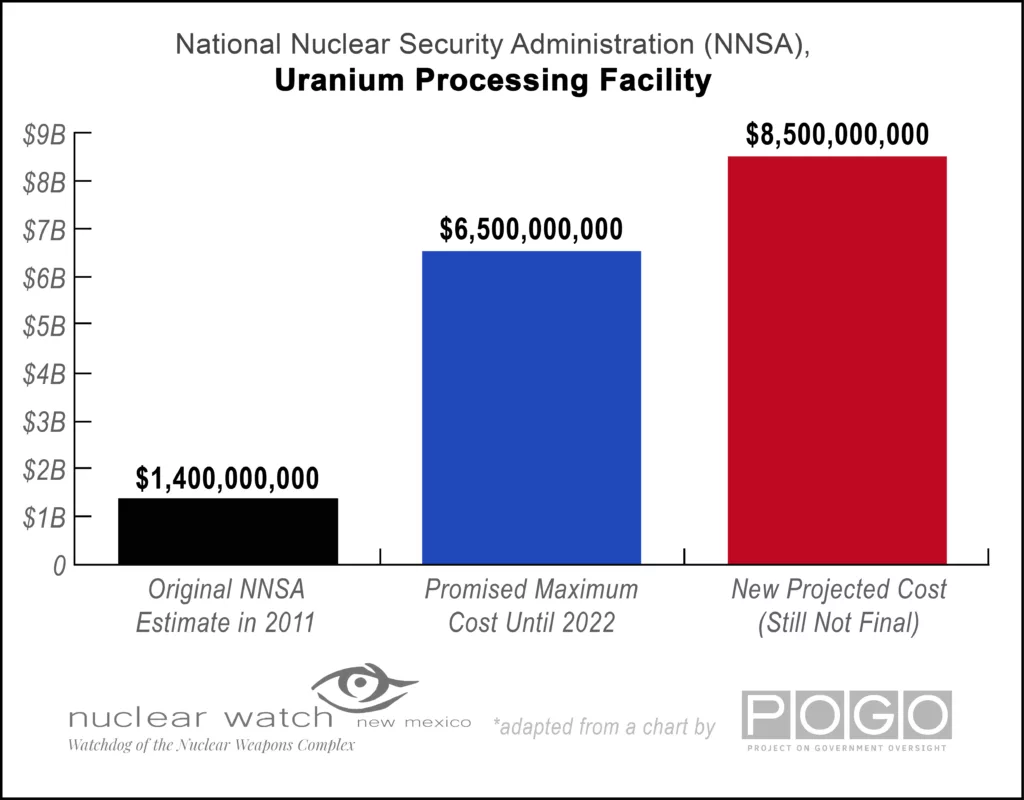 A current example is the Uranium Processing Facility (UPF) at the Y-12 Plant near Oak Ridge, Tennessee, originally estimated in 2011 to cost $1.4 to $3.5 billion. After costs started going through the roof, NNSA and Senator Lamar Alexander (R.-TN), then-chair of Senate Energy and Water Appropriations, swore that UPF would never go over $6.5 billion. But even after eliminating non-nuclear weapons production missions and a formal decision to continue operations at two old, unsafe buildings slated for replacement, the Uranium Processing Facility is now estimated to cost $8.5 billion. However, even that is not the final price, as NNSA is still to “rebaseline” UPF costs at some unspecified date.
A current example is the Uranium Processing Facility (UPF) at the Y-12 Plant near Oak Ridge, Tennessee, originally estimated in 2011 to cost $1.4 to $3.5 billion. After costs started going through the roof, NNSA and Senator Lamar Alexander (R.-TN), then-chair of Senate Energy and Water Appropriations, swore that UPF would never go over $6.5 billion. But even after eliminating non-nuclear weapons production missions and a formal decision to continue operations at two old, unsafe buildings slated for replacement, the Uranium Processing Facility is now estimated to cost $8.5 billion. However, even that is not the final price, as NNSA is still to “rebaseline” UPF costs at some unspecified date.
U.S. Strategic Posture Commission Ratchets Up Nuclear Arms Race
FOR IMMEDIATE RELEASE, October 12, 2023
Jay Coghlan – 505.989.7342 | Email
Santa Fe, NM – Today, America’s Strategic Posture, The Final Report was released by the Congressional Commission on the Strategic Posture of the United States. In its own words:
“The Congressional Commission on the Strategic Posture of the United States was established by the Fiscal Year (FY) 2022 National Defense Authorization Act (NDAA), and concludes that America’s defense strategy and strategic posture must change in order to properly defend its vital interests and improve strategic stability with China and Russia. Decisions need to be made now in order for the nation to be prepared to address the threats from these two nuclear-armed adversaries arising during the 2027-2035 timeframe. Moreover, these threats are such that the United States and its Allies and partners must be ready to deter and defeat both adversaries simultaneously.”
Los Alamos Lab’s Future at a Crossroads: Cleanup or More Nuclear Weapons? NukeWatch Applauds NM State Rejection of Fake Cleanup
FOR IMMEDIATE RELEASE, September 18, 2023
Jay Coghlan – 505.989.7342, c 505.470.3154 | Email
Scott Kovac – c. 505.316.4148 | Email
Santa Fe, NM – In an important win for genuine cleanup at the Los Alamos National Laboratory (LANL), the New Mexico Environment Department (NMED) has rejected the Lab’s plans for so-called cleanup through “cap and cover.” LANL’s plan would leave existing radioactive and toxic wastes uncharacterized and forever buried in unlined pits and trenches as a permanent threat to groundwater. At issue is remediation of the Lab’s “Material Disposal Area C” waste dump that has 7 pits and 108 shafts of radioactive and toxic wastes. Area C is located in the heart of nuclear weapons production at LANL, contiguous to the Lab’s main plutonium facility which is expanding production of plutonium “pit” bomb cores.
In a September 7, 2023 “Public Notice of Statement of Basis,” the Environment Department ruled:
“For maximum protection of human health and the environment and to ensure that the drinking water resource can be conservatively protected, NMED has determined that the selected [cleanup] remedy for MDA C must consist of waste excavation, characterization, and appropriate disposal of the buried waste… Excavation will ensure that the source of contamination at MDA C is removed…”
Oppenheimer’s Legacy: South Carolina at the Center of the New Nuclear Arms Race 8/16/23
Learn about the role of the U.S. Department of Energy – and the Savannah River Site in South Carolina particular – in production of plutonium “pits” for new nuclear weapons as a key part of the new nuclear arms race from this August 16, 2023 event: https://www.youtube.com/watch?v=ZK9YOFoT6r0
Plutonium Detections From Trinity Test Discovered 78 years After Test – Confirm RECA Must Be Expanded
FOR IMMEDIATE RELEASE, July 31, 2023
Tina Cordova, Tularosa Basin Downwind Consortium – 505.897.6787 | Email
Dr. Michael E. Ketterer – 928.853.7188 | Email
Scott Kovac, Nuclear Watch New Mexico – 505.989.7342 | Email
Santa Fe, NM – New preliminary information strongly supports Radiation Exposure Compensation Act (RECA) status for New Mexicans downwind of the Trinity Test Site. In the past weeks, Michael E. Ketterer, (Professor Emeritus, Chemistry and Biochemistry, Northern Arizona University, Flagstaff, AZ) has completed a short “proof of principle” study that directly investigates where plutonium in soils originates by analyzing isotopic ratios, in a known portion of the Trinity Test plume.
Dr. Ketterer sampled soils along highways NM 42, US 54, NM 55, US 60, and US 380. The isotopes show that there is definitely plutonium from the Trinity Test in the northeast plume, and distinguishes it from global (stratospheric) background and New Mexico regional background from Nevada Test Site fallout. Soils along all five of these highways contain plutonium that reflects mixtures of Trinity Test debris and global/Nevada regional background fallout; in some cases, nearly 100% of the Pu originates from the Trinity Test.
While Dr. Ketterer has not encountered any activities (expressed as Bq/kg or pCi/g, Becquerels or picocuries respectively) of plutonium that cause alarm from the radio-toxicity standpoint, there’s very limited data.
Nuclear Weapons Today – Peril and Promise, with Jay Coghlan and Ralph Hutchison

Nuclear Weapons Today – Peril and Promise, with Jay Coghlan and Ralph Hutchison: https://www.youtube.com/watch?v=P_0aqUG9hmw&t=15s
Biden Releases Record NNSA Nuclear Weapons Budget
FOR IMMEDIATE RELEASE, March 14, 2023
Jay Coghlan – 505.989.7342 | Email | Scott Kovac – 505.989.7342 | Email
Santa Fe, NM – President Biden has released his proposed FY 2024 budget for the Department of Energy’s semi-autonomous nuclear weapons agency, the National Nuclear Security Administration (NNSA). The budget for NNSA’s “Total Weapons Activities” for nuclear weapons research and production programs is slated to increase by 10% to $18.8 billion.
Of that $18.8 billion requested for FY 2024, over $3 billion is devoted to “Life Extension Programs” or “Alterations” that extend the service lives of existing nuclear weapons by decades while giving them new military capabilities. It also includes two new-design nuclear weapons, the W87-1 ICBM warhead (increased 50% to $1 billion) and the sub-launched W93 warhead (increased 62% to $390 million). Meanwhile, funding for dismantlements that provide a good nonproliferation example and save taxpayers’ money by eliminating long-term security costs is decreased by 4% to $53.7 million. That is a small fraction of one percent of NNSA’s Total Weapons Activities.
Two bright spots, yet still small relative to the U.S.’ planned $2 trillion nuclear weapons “modernization” program, are the zeroing out of funding for the Sea-Launched Cruise Missile (SLCM) warhead and stronger language on the retirement of the 1.2 megaton B83 bomb. Trump proposed to bring back nuclear-armed sea-launched cruise missiles, which were retired by President George H. Bush after the end of the Cold War. Biden’s 2022 Nuclear Posture Review canceled the SLCM, but Congress insisted on funding it, which will only grow stronger with Republican control the House.
In Response to Lawsuit, NNSA Releases FY 2022 Performance Evaluation Reports as “Frequently Requested Documents” as Required by FOIA; Reveals Pit Production Schedule is Likely Increasingly Delayed
FOR IMMEDIATE RELEASE, March 9, 2023
Jay Coghlan – 505.989.7342 | Email | Scott Kovac – 505.989.7342 | Email
Santa Fe, NM – Today, the National Nuclear Security Administration[1] (NNSA) finally posted its FY 2022 Performance Evaluation Reports to its electronic “FOIA Reading Room.” These reports are “Frequently Requested Documents” as defined by the Freedom of Information Act (meaning three or more requests) and are therefore required to be posted under the law. The catalyst for this was a lawsuit filed by Nuclear Watch New Mexico in September 2022.
NNSA’s Performance Evaluation Reports for its eight nuclear weapons research and production sites[2] grade annual contractor performance and award performance fees accordingly. Approximately 57,000 people are employed by the NNSA nuclear weapons complex, 95% of them contractor personnel. The Department of Energy and NNSA (or its predecessor DOE Defense Programs) have been on the independent Government Accountability Office’s “High Risk List” for project mismanagement and waste of taxpayers’ dollars since 1992.
ALLIANCE FOR NUCLEAR ACCOUNTABILITY MEDIA ADVISORY: WHAT TO LOOK FOR IN THE U.S. DEPARTMENT OF ENERGY’S FY 2024 NUCLEAR WEAPONS AND CLEANUP BUDGET REQUEST
Alliance for Nuclear Accountability | March 8, 2023 ananuclear.org
The Biden Administration is releasing its Fiscal Year 2024 federal budget on Thursday, March 9. It is expected to be a “skinny budget” with just topline financial numbers. If the pattern of the last few years for the Department of Energy’s (DOE’s) budget is continued, there can be three more releases over the next six weeks that grow progressively more detailed (there is initially little if any site-specific budget information). Historically around 60% of DOE’s funding has been earmarked for nuclear weapons production and cleanup of Cold War wastes and contamination.
The release of the presidential budget begins the annual legislative process for funding DOE programs and sites. The two bicameral congressional subcommittees that have jurisdiction over the DOE budget are the Armed Services Committee Strategic Forces Subcommittee which “authorizes” funding, and the Energy and Water Development Appropriations Subcommittee which actually provides funding. Congress has managed to pass the Defense Authorization Act for more than 50 consecutive years, but is increasingly unable to pass appropriations bills, leading to short-term Continuing Resolutions (CRs). Given bipartisan friction and the beginning of election campaigning, Continuing Resolutions are likely for this coming federal fiscal year 2024, which begins October 1, 2023.
The Alliance for Nuclear Accountability strongly opposed the massive 25% FY 2021 increase that the Trump Administration gave to the nuclear weapons programs of DOE’s semi-autonomous National Nuclear Security Administration (NNSA). The Biden Administration not only kept Trump’s increases in subsequent budgets but substantially added to them, particularly for expanded production of plutonium “pit” bomb cores for nuclear weapons. Meanwhile, dismantlements of nuclear warheads have slowed to a crawl and funding for cleanup of Cold War radioactive and hazardous wastes has remained flat.
DOE’s nuclear weapons and environmental management programs have been on the Government Accountability Office’s “High Risk List” for project mismanagement and waste of taxpayers’ dollars for more than 30 consecutive years. Defense Department and DOE costs for so-called “modernization” of U.S. nuclear forces begun under Obama is expected to be around $2 trillion over the next 30 years.
State Environment Department Begins to Rein in Work On LANL’s Chromium Plume Given Major Differences With DOE
FOR IMMEDIATE RELEASE, February 21, 2023 | Scott Kovac – 505.989.7342 | Email
At a February 9, 2023 public community forum hosted by the Department of Energy’s Environmental Management Los Alamos Office, there were strong indications that the New Mexico Environment Department (NMED) is convinced that DOE’s plans to remediate the chromium groundwater contamination plume under Los Alamos National Laboratory (LANL) is not working. Kimberly Lebak, program manager for N3B, the LANL cleanup contractor, described how it is finalizing the 2023 milestones under the Consent Order that governs cleanup, despite the fact that the NMED Groundwater Bureau has requested that DOE stop injecting treated water by April 1, 2023. DOE and NMED are not seeing eye-to-eye concerning the “Interim Measure” that N3B is using to contain the chromium plume.
The two agencies disagree on the Interim Measure, originally designed to prevent chromium from migrating across the San Ildefonso Pueblo border while DOE tries to figure out a final remedy.
District Court Denies Department of Energy’s Motion to Dismiss Plutonium Pits Suit
FOR IMMEDIATE RELEASE, February 13, 2023 | South Carolina Environmental Law Project, Savannah River Site Watch, Nuclear Watch New Mexico, Tri-Valley CAREs, Gullah/Geechee Sea Island Coalition
AIKEN, S.C. — In a win for public participation and environmental protection, the United States District Court of South Carolina denied the Department of Energy’s motion to dismiss a 2021 legal action filed by multiple citizen groups. The suit was prompted by the agencies’ failure to take the “hard look” required by the National Environmental Policy Act at their plans to more than quadruple the production of plutonium pits for new nuclear weapons and split their production between the Los Alamos National Laboratory and the Savannah River Site.
In her ruling, Judge Mary Geiger Lewis thoroughly rejected the defendants’ arguments that the plaintiffs lacked standing, saying it was “not a close call”.
“We were able to defeat yet another attempt to use standing as a weapon to keep members of the public out of the government’s decision-making process,” said Leslie Lenhardt, Senior Managing Attorney at the South Carolina Environmental Law Project (SCELP).
To date, the Department of Energy (DOE) has refused to fully examine the environmental and safety impacts of their cross-country plan, which would create massive quantities of dangerous and radioactive material, put hundreds of billions of taxpayer dollars on the line, risk a new nuclear arms race, and violate the nation’s foundational environmental law.
Past NukeWatch Events
URGENT ACTION NEEDED to Help Protect the Defense Nuclear Facilities Safety Board!
Congress must act to keep the Defense Nuclear Facilities Safety Board (DNFSB) from losing its quorum on October 18. We need YOUR help to get them to take action in the pending Continuing Resolution to keep the government running!
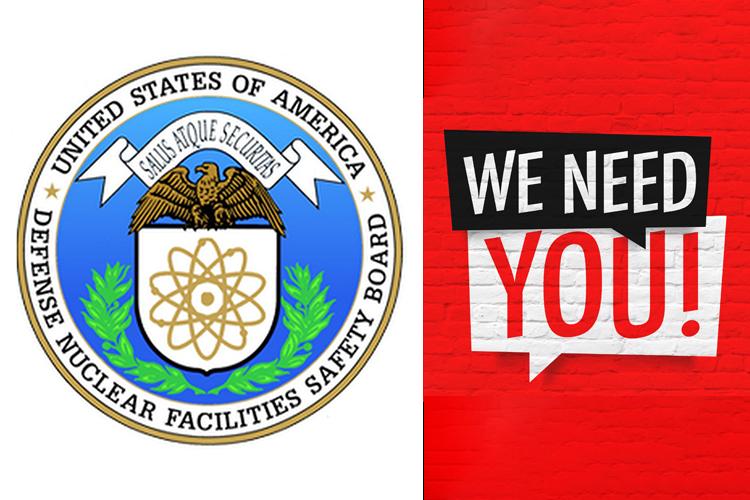 The Defense Nuclear Facilities Safety Board is an independent agency within the executive branch of the Federal Government. (https://www.dnfsb.gov/) The DNFSB is chartered with the responsibility to provide recommendations and advice to the Secretary of Energy regarding public health and safety issues at Department of Energy (DOE) defense nuclear facilities, including with respect to the health and safety of employees and contractors and the nearby communities.
The Defense Nuclear Facilities Safety Board is an independent agency within the executive branch of the Federal Government. (https://www.dnfsb.gov/) The DNFSB is chartered with the responsibility to provide recommendations and advice to the Secretary of Energy regarding public health and safety issues at Department of Energy (DOE) defense nuclear facilities, including with respect to the health and safety of employees and contractors and the nearby communities.
Congress established the Board in 1988 in response to longtime, ongoing concerns about the level of health and safety protection that DOE was providing the public and workers at defense nuclear facilities, including concerns from Alliance for Nuclear Accountability (ANA) groups. We would not know about the many DOE nuclear safety problems without the Safety Board.
There are five positions on the Board for experts in the field of nuclear safety with demonstrated competence and knowledge relevant to its independent investigative and oversight functions. However, since early 2025, the Board has been reduced to just two members, Mr. Thomas A. Summers (a Republican nominee whose term ends on October 18, 2025), and Dr. Patricia L. Lee. The Board currently has a temporary one-year statutory quorum. Since there is no indication that Mr. Summers might be allowed to extend his term, the Board may be down to one person after October, and will then lack a quorum. Without its quorum, the DNFSB can not carry out its mission effectively.
Congress must take action to protect nuclear safety by preserving DNFSB’s quorum!
Here’s how you can help:
Congress is in the process of negotiating a new Continuing Resolution (CR) to fund the government for FY 2026. The CR should contain a provision to enable the Defense Nuclear Facilities Safety Board to continue in its current capacity. The provision is a temporary measure only until the Administration and Senate can nominate and confirm additional Board Members. Take action now to urge Chuck Shumer (Senate Minority Leader) and other Senators to protect the DNFSB!Continue reading
JOIN US: Upcoming Virtual Workshops on the Nationwide Programmatic Environmental Impact Statement
JOIN US: Virtual Workshop
On the Nationwide Programmatic Environmental Impact Statement on the Expanded Production of Plutonium “Pit” Bomb Cores
Public comments help increase transparency and safety.
It is crucial that the National Nuclear Security Administration (NNSA) and US Department of Energy hear from scientists, experts, and community members like you.
Public Comment Training #2: Expanded Plutonium Pit Production
Date: Thursday, June 26
Time: 6:00–7:00 p.m. ET, 4:00–5:00 p.m. MT
![]()
This workshop will feature:
- Talking points and suggested scoping comments
- Explanation of procedural process
- The Union of Concerned Scientists’ new comprehensive study of pit production at www.ucs.org/resources/plutonium-pit-production
- Question & answers with subject matter experts
Background: Pursuant to the National Environmental Policy Act, Nuclear Watch New Mexico, Savannah River Site Watch and Tri-Valley CAREs successfully sued the National Nuclear Security Administration (NNSA) over its failure to complete a required nationwide “programmatic environmental impact statement” (PEIS) for its most costly program ever, the expanded production of plutonium “pit” bomb cores. Their production is the current chokepoint to resumed industrial-scale of nuclear weapons by the United States. Ironically, no future pit production is to maintain the safety and reliability of the existing nuclear stockpile. Instead, all future pit production is for new design nuclear weapons for the new nuclear arms race.
To meet its enforced legal obligation, the NNSA must consider written comments submitted by July 14 on what the scope of the PEIS should be. NNSA wants to keep its scope narrowly confined to discussion of alternative levels of pit production rather than questioning the need for production to begin with. A few examples of needed scope include compliance with the NonProliferation Treaty, reusing existing pits, ensuring nuclear safety, the lack of credible cost estimates and where radioactive wastes will go. For more see suggested scoping comments at https://nukewatch.org/wp-content/uploads/2025/05/Pit-PEIS-suggested-scoping-comments-5-27-25.pdf
Scoping comments due by July 14 can be emailed to PitPEIS@nnsa.doe.gov or mailed to:
Ms. Kristen M. Dors, NEPA Compliance Officer
NNSA Los Alamos Field Office
3747 W. Jemez Road, Los Alamos, NM 87544
For additional background, see NNSA’s formal Notice of Intent at https://www.energy.gov/nepa/articles/doeeis-0573-notice-intent-may-2025 for the PEIS Following publication of a draft PEIS (expected in a year), in person public hearings will be held in Livermore, CA; Santa Fe, NM; Kansas City, MO; Aiken; SC, and Washington, DC.
Let’s transform this Pit Production Programmatic Environmental Impact Statement into a public referendum on the new nuclear arms race!
Organized By:
Nuclear Watch New Mexico | nukewatch.org
Savannah River Site Watch | srswatch.org
 Tri-Valley CAREs | trivalleycares.org
Tri-Valley CAREs | trivalleycares.org
Union of Concerned Scientists | ucs.org
Sign the Petition to Deny LANL’s Request to Release Radioactive Tritium into the Air to Governor Lujan Grisham and New Mexico Environment Department
Los Alamos National Laboratory (LANL) plans to begin large releases of radioactive tritium gas any time after June 2, 2025. The only roadblock is that LANL needs a “Temporary Authorization” from the New Mexico Environment Department (NMED), which could happen soon. Below are the facts:
• Why the rush? LANL has explicitly stated, “There is no urgency for this project beyond the broader mission goals to reduce onsite waste liabilities.”
• LANL claims need the need to vent based on modeling, not physical sampling of container headspace.
• LANL wants to vent about 9 grams of tritium (~100,000 curies) over the span of a few days. This is three times the amount of tritium as Japan is dumping into the Pacific Ocean over the span of 30 years from the tsunami and nuclear reactor explosions at Fukushima Daiichi Nuclear Power Plant.
• One teaspoon of tritiated water (HTO) can contaminate around 100 billion gallons of water.
• When calculating the risk, LANL only does so for adults – they are not required to do so for children, infants or pregnant women/fetuses – ignoring the real impact on our communities. The author of one report, Bernd Franke, stated, “In the case of tritium, infants and small children get a radiation dose about three times greater than adults, with the same concentrations of tritium in air, water, and food.”
Public Hearings: Submit Comments on the Draft LANL SWEIS
- Review and submit comments on the Draft LANL SWEIS through March 11, 2025.
- Comments may be submitted via one of the following means:
- By email to: LANLSWEIS@nnsa.doe.gov; By mail to Mr. Stephen Hoffman, LANL SWEIS Document Manager, DOE/NNSA, 3747 W. Jemez Road, Los Alamos, New Mexico 87544; Verbally at one of the public hearings; In written form at one of the public hearings
-
Public hearings are scheduled for:
- February 11, 2025, at the Santa Fe Community Convention Center, Sweeney Room, 1-4 p.m. and 5-8 p.m. There will be a virtual option for these two meeting. Virtual hearing access instructions (g., website link or phone number) will be announced at least 15 days before the hearing and will be published in local newspapers, noticed to the GovDelivery mailing list, and available on the following websites: https://www.energy.gov/nnsa/nnsa-nepa-reading-roomand https://www.energy.gov/nepa/public-comment-opportunities.
- February 12, 2025, in Española at Mision y Convento, 5-8 p.m. This meeting is in-person only.
- February 13, 2025, in Los Alamos at Fuller Lodge, Pajarito Room, 5-8 p.m. In-person only.
- Comments may be submitted via one of the following means:
Briefing on Plutonium Migration at the Los Alamos National Laboratory
Who: Nuclear Watch New Mexico and chemist Dr. Michael Ketterer, Professor Emeritus of Chemistry and Biochemistry at Northern Arizona University
What: Nuclear Watch has mapped plutonium migration based on sampling data from Intellus, the Lab’s environmental sampling database. Our map graphically demonstrates widespread contamination down the Rio Grande to Cochiti Lake and vertically to deep groundwater. We believe it shows the need for comprehensive cleanup at LANL instead of proposed “cap and cover” that will leave toxic and radioactive wastes permanently buried in unlined pits and trenches.
When: 11:00 am MT Thursday April 25, 2024
Where: https://us06web.zoom.us/j/95570087953?pwd=R1hNUEIyb1BLaktDQzZQaWNEdlpoQT09
Meeting ID: 922 1214 9822 Passcode: 975887
This virtual briefing is for media and the public. Nuclear Watch and Dr. Ketterer will briefly present followed by Q&A. Media and reporters will be given preference for questions. Please feel free to forward this notice to others.
Our plutonium contamination map and background materials will be available at www.nukewatch.org by 10:00 am MT Thursday April 25.
Nuclear Communities of the Southwest: New Exhibit at the Albuquerque Museum
NukeWatch’s Nuclear New Mexico Map will be on display as part of Nuclear Communities of the Southwest at the Albuquerque Museum. This exhibition features videos, photographs, and memorabilia from Sandia and Los Alamos National Laboratories as well as the Kirtland Air Force Base. This exhibition will put these historical objects in conversation with downwinder voices and artists’ responses to New Mexico’s involvement in the development of nuclear technologies.
It will open in the museum’s Keleher Gallery on March 23, 2024, and will run through September 15, 2024.
Please see the flyer above for the opening event information.
First Annual Plutonium Trail Caravan
On Saturday, April 6, you will be able to join the First Annual Plutonium Trail Caravan! It will start at Pojoaque and end at Lamy. It will also stop in Eldorado and you are welcome to join the caravan on its way to the final stop in Lamy. There will be several stops along the way, with more details coming soon. Please save the date for 30 minutes on the afternoon of April 6. There will be fun satiric songs, banners, and plenty of people to ask questions about risks to neighborhoods on the route.
2023
U.S. Strategic Posture Commission Ratchets Up Nuclear Arms Race
FOR IMMEDIATE RELEASE, October 12, 2023
Jay Coghlan – 505.989.7342 | Email
Santa Fe, NM – Today, America’s Strategic Posture, The Final Report was released by the Congressional Commission on the Strategic Posture of the United States. In its own words:
“The Congressional Commission on the Strategic Posture of the United States was established by the Fiscal Year (FY) 2022 National Defense Authorization Act (NDAA), and concludes that America’s defense strategy and strategic posture must change in order to properly defend its vital interests and improve strategic stability with China and Russia. Decisions need to be made now in order for the nation to be prepared to address the threats from these two nuclear-armed adversaries arising during the 2027-2035 timeframe. Moreover, these threats are such that the United States and its Allies and partners must be ready to deter and defeat both adversaries simultaneously.”
Los Alamos Lab’s Future at a Crossroads: Cleanup or More Nuclear Weapons? NukeWatch Applauds NM State Rejection of Fake Cleanup
FOR IMMEDIATE RELEASE, September 18, 2023
Jay Coghlan – 505.989.7342, c 505.470.3154 | Email
Scott Kovac – c. 505.316.4148 | Email
Santa Fe, NM – In an important win for genuine cleanup at the Los Alamos National Laboratory (LANL), the New Mexico Environment Department (NMED) has rejected the Lab’s plans for so-called cleanup through “cap and cover.” LANL’s plan would leave existing radioactive and toxic wastes uncharacterized and forever buried in unlined pits and trenches as a permanent threat to groundwater. At issue is remediation of the Lab’s “Material Disposal Area C” waste dump that has 7 pits and 108 shafts of radioactive and toxic wastes. Area C is located in the heart of nuclear weapons production at LANL, contiguous to the Lab’s main plutonium facility which is expanding production of plutonium “pit” bomb cores.
In a September 7, 2023 “Public Notice of Statement of Basis,” the Environment Department ruled:
“For maximum protection of human health and the environment and to ensure that the drinking water resource can be conservatively protected, NMED has determined that the selected [cleanup] remedy for MDA C must consist of waste excavation, characterization, and appropriate disposal of the buried waste… Excavation will ensure that the source of contamination at MDA C is removed…”
Oppenheimer’s Legacy: South Carolina at the Center of the New Nuclear Arms Race 8/16/23
Learn about the role of the U.S. Department of Energy – and the Savannah River Site in South Carolina particular – in production of plutonium “pits” for new nuclear weapons as a key part of the new nuclear arms race from this August 16, 2023 event: https://www.youtube.com/watch?v=ZK9YOFoT6r0
Plutonium Detections From Trinity Test Discovered 78 years After Test – Confirm RECA Must Be Expanded
FOR IMMEDIATE RELEASE, July 31, 2023
Tina Cordova, Tularosa Basin Downwind Consortium – 505.897.6787 | Email
Dr. Michael E. Ketterer – 928.853.7188 | Email
Scott Kovac, Nuclear Watch New Mexico – 505.989.7342 | Email
Santa Fe, NM – New preliminary information strongly supports Radiation Exposure Compensation Act (RECA) status for New Mexicans downwind of the Trinity Test Site. In the past weeks, Michael E. Ketterer, (Professor Emeritus, Chemistry and Biochemistry, Northern Arizona University, Flagstaff, AZ) has completed a short “proof of principle” study that directly investigates where plutonium in soils originates by analyzing isotopic ratios, in a known portion of the Trinity Test plume.
Dr. Ketterer sampled soils along highways NM 42, US 54, NM 55, US 60, and US 380. The isotopes show that there is definitely plutonium from the Trinity Test in the northeast plume, and distinguishes it from global (stratospheric) background and New Mexico regional background from Nevada Test Site fallout. Soils along all five of these highways contain plutonium that reflects mixtures of Trinity Test debris and global/Nevada regional background fallout; in some cases, nearly 100% of the Pu originates from the Trinity Test.
While Dr. Ketterer has not encountered any activities (expressed as Bq/kg or pCi/g, Becquerels or picocuries respectively) of plutonium that cause alarm from the radio-toxicity standpoint, there’s very limited data.
Nuclear Weapons Today – Peril and Promise, with Jay Coghlan and Ralph Hutchison

Nuclear Weapons Today – Peril and Promise, with Jay Coghlan and Ralph Hutchison: https://www.youtube.com/watch?v=P_0aqUG9hmw&t=15s
Biden Releases Record NNSA Nuclear Weapons Budget
FOR IMMEDIATE RELEASE, March 14, 2023
Jay Coghlan – 505.989.7342 | Email | Scott Kovac – 505.989.7342 | Email
Santa Fe, NM – President Biden has released his proposed FY 2024 budget for the Department of Energy’s semi-autonomous nuclear weapons agency, the National Nuclear Security Administration (NNSA). The budget for NNSA’s “Total Weapons Activities” for nuclear weapons research and production programs is slated to increase by 10% to $18.8 billion.
Of that $18.8 billion requested for FY 2024, over $3 billion is devoted to “Life Extension Programs” or “Alterations” that extend the service lives of existing nuclear weapons by decades while giving them new military capabilities. It also includes two new-design nuclear weapons, the W87-1 ICBM warhead (increased 50% to $1 billion) and the sub-launched W93 warhead (increased 62% to $390 million). Meanwhile, funding for dismantlements that provide a good nonproliferation example and save taxpayers’ money by eliminating long-term security costs is decreased by 4% to $53.7 million. That is a small fraction of one percent of NNSA’s Total Weapons Activities.
Two bright spots, yet still small relative to the U.S.’ planned $2 trillion nuclear weapons “modernization” program, are the zeroing out of funding for the Sea-Launched Cruise Missile (SLCM) warhead and stronger language on the retirement of the 1.2 megaton B83 bomb. Trump proposed to bring back nuclear-armed sea-launched cruise missiles, which were retired by President George H. Bush after the end of the Cold War. Biden’s 2022 Nuclear Posture Review canceled the SLCM, but Congress insisted on funding it, which will only grow stronger with Republican control the House.
In Response to Lawsuit, NNSA Releases FY 2022 Performance Evaluation Reports as “Frequently Requested Documents” as Required by FOIA; Reveals Pit Production Schedule is Likely Increasingly Delayed
FOR IMMEDIATE RELEASE, March 9, 2023
Jay Coghlan – 505.989.7342 | Email | Scott Kovac – 505.989.7342 | Email
Santa Fe, NM – Today, the National Nuclear Security Administration[1] (NNSA) finally posted its FY 2022 Performance Evaluation Reports to its electronic “FOIA Reading Room.” These reports are “Frequently Requested Documents” as defined by the Freedom of Information Act (meaning three or more requests) and are therefore required to be posted under the law. The catalyst for this was a lawsuit filed by Nuclear Watch New Mexico in September 2022.
NNSA’s Performance Evaluation Reports for its eight nuclear weapons research and production sites[2] grade annual contractor performance and award performance fees accordingly. Approximately 57,000 people are employed by the NNSA nuclear weapons complex, 95% of them contractor personnel. The Department of Energy and NNSA (or its predecessor DOE Defense Programs) have been on the independent Government Accountability Office’s “High Risk List” for project mismanagement and waste of taxpayers’ dollars since 1992.
ALLIANCE FOR NUCLEAR ACCOUNTABILITY MEDIA ADVISORY: WHAT TO LOOK FOR IN THE U.S. DEPARTMENT OF ENERGY’S FY 2024 NUCLEAR WEAPONS AND CLEANUP BUDGET REQUEST
Alliance for Nuclear Accountability | March 8, 2023 ananuclear.org
The Biden Administration is releasing its Fiscal Year 2024 federal budget on Thursday, March 9. It is expected to be a “skinny budget” with just topline financial numbers. If the pattern of the last few years for the Department of Energy’s (DOE’s) budget is continued, there can be three more releases over the next six weeks that grow progressively more detailed (there is initially little if any site-specific budget information). Historically around 60% of DOE’s funding has been earmarked for nuclear weapons production and cleanup of Cold War wastes and contamination.
The release of the presidential budget begins the annual legislative process for funding DOE programs and sites. The two bicameral congressional subcommittees that have jurisdiction over the DOE budget are the Armed Services Committee Strategic Forces Subcommittee which “authorizes” funding, and the Energy and Water Development Appropriations Subcommittee which actually provides funding. Congress has managed to pass the Defense Authorization Act for more than 50 consecutive years, but is increasingly unable to pass appropriations bills, leading to short-term Continuing Resolutions (CRs). Given bipartisan friction and the beginning of election campaigning, Continuing Resolutions are likely for this coming federal fiscal year 2024, which begins October 1, 2023.
The Alliance for Nuclear Accountability strongly opposed the massive 25% FY 2021 increase that the Trump Administration gave to the nuclear weapons programs of DOE’s semi-autonomous National Nuclear Security Administration (NNSA). The Biden Administration not only kept Trump’s increases in subsequent budgets but substantially added to them, particularly for expanded production of plutonium “pit” bomb cores for nuclear weapons. Meanwhile, dismantlements of nuclear warheads have slowed to a crawl and funding for cleanup of Cold War radioactive and hazardous wastes has remained flat.
DOE’s nuclear weapons and environmental management programs have been on the Government Accountability Office’s “High Risk List” for project mismanagement and waste of taxpayers’ dollars for more than 30 consecutive years. Defense Department and DOE costs for so-called “modernization” of U.S. nuclear forces begun under Obama is expected to be around $2 trillion over the next 30 years.
State Environment Department Begins to Rein in Work On LANL’s Chromium Plume Given Major Differences With DOE
FOR IMMEDIATE RELEASE, February 21, 2023 | Scott Kovac – 505.989.7342 | Email
At a February 9, 2023 public community forum hosted by the Department of Energy’s Environmental Management Los Alamos Office, there were strong indications that the New Mexico Environment Department (NMED) is convinced that DOE’s plans to remediate the chromium groundwater contamination plume under Los Alamos National Laboratory (LANL) is not working. Kimberly Lebak, program manager for N3B, the LANL cleanup contractor, described how it is finalizing the 2023 milestones under the Consent Order that governs cleanup, despite the fact that the NMED Groundwater Bureau has requested that DOE stop injecting treated water by April 1, 2023. DOE and NMED are not seeing eye-to-eye concerning the “Interim Measure” that N3B is using to contain the chromium plume.
The two agencies disagree on the Interim Measure, originally designed to prevent chromium from migrating across the San Ildefonso Pueblo border while DOE tries to figure out a final remedy.
District Court Denies Department of Energy’s Motion to Dismiss Plutonium Pits Suit
FOR IMMEDIATE RELEASE, February 13, 2023 | South Carolina Environmental Law Project, Savannah River Site Watch, Nuclear Watch New Mexico, Tri-Valley CAREs, Gullah/Geechee Sea Island Coalition
AIKEN, S.C. — In a win for public participation and environmental protection, the United States District Court of South Carolina denied the Department of Energy’s motion to dismiss a 2021 legal action filed by multiple citizen groups. The suit was prompted by the agencies’ failure to take the “hard look” required by the National Environmental Policy Act at their plans to more than quadruple the production of plutonium pits for new nuclear weapons and split their production between the Los Alamos National Laboratory and the Savannah River Site.
In her ruling, Judge Mary Geiger Lewis thoroughly rejected the defendants’ arguments that the plaintiffs lacked standing, saying it was “not a close call”.
“We were able to defeat yet another attempt to use standing as a weapon to keep members of the public out of the government’s decision-making process,” said Leslie Lenhardt, Senior Managing Attorney at the South Carolina Environmental Law Project (SCELP).
To date, the Department of Energy (DOE) has refused to fully examine the environmental and safety impacts of their cross-country plan, which would create massive quantities of dangerous and radioactive material, put hundreds of billions of taxpayer dollars on the line, risk a new nuclear arms race, and violate the nation’s foundational environmental law.
Top Environment Official Takes Inside Info to Nuclear Weapons Agency, Gets Puny Slap-on-Wrist for Ethical Violation; Governor Should Enforce State Code of Conduct
FOR IMMEDIATE RELEASE, February 8, 2023 | Joni Arends, Concerned Citizens for Nuclear Safety – 505.986.1973 | Email
Jay Coghlan – 505.989.7342 | Email
Santa Fe, NM – The Department of Energy (DOE) will spend $9.4 billion dollars in New Mexico during this fiscal year 2023, 10% more than the State’s entire operating budget of $8.5 billion. To help enable its agenda of expanding nuclear weapons production that will cause more radioactive wastes and contamination, the DOE’s semi-autonomous National Nuclear Security Administration (NNSA) or its contractors often go head hunting for top State officials.
The New Mexico Environment Department (NMED) has sued DOE over the slow pace of cleanup at the Los Alamos National Laboratory (LANL). Stephanie Stringer, former Deputy Cabinet Director (the number two position at NMED), applied to work for NNSA in August 2022, and resigned to take that job in November. During that time, she was privy to NMED litigation strategy against DOE and chaired the New Mexico Water Quality Control Commission that denied a citizens’ motion against one of LANL’s most crucial facilities for expanding plutonium pit production, the Radioactive Liquid Waste Treatment Facility. As a result, the New Mexico Ethics commission fined Stringer a paltry $250. Assuming that Stringer is earning at least $100,000 base salary in her new position, that fine would have cost her approximately five hours of her time.
Comment on the Lawrence Livermore National Laboratory Draft Site-Wide Environmental Impact Statement
Nuclear Watch New Mexico January 21, 2023 | Email
Via email to: LLNLSWEIS@nnsa.doe.gov
Ms. Fana Gebeyehu-Houston,
LLNL SWEIS Document Manager,
1000 Independence Ave., SW, Washington, DC 20585
Dear Ms. Fana Gebeyehu-Houston:
Thank you for the opportunity to comment on the National Nuclear Security Administration’s (NNSA) Draft Site-Wide Environmental Impact Statement (SWEIS) for the continued operation of the Lawrence Livermore National Laboratory Main Site in Livermore, CA and Site 300 high explosives testing range near Tracy, CA.
Nuclear Watch New Mexico takes particular interest in the Livermore Lab as the sister lab of the Los Alamos National Laboratory (LANL). We have long been involved in the issue of plutonium pit production at LANL. We see the two labs as inextricably linked given that LANL will be producing plutonium pits for the new W87-1 warhead, for which LLNL is the lead design agency.
Our mission statement: Nuclear Watch New Mexico seeks to promote safety and environmental protection at nuclear facilities; mission diversification away from nuclear weapons programs; greater accountability and cleanup in the nation-wide nuclear weapons complex; and consistent U.S. leadership toward a world free of nuclear weapons.
NukeWatch DNFSB 2022 Hearing Comments 1-20-23
Nuclear Watch New Mexico January 20, 2023 | Email
Defense Nuclear Facilities Safety Board
625 Indiana Avenue NW, Suite 700
Washington, DC 20004
Via email at <hearing@dnfsb.gov>
Re: Comments concerning the November 16, 2022 public hearing regarding legacy cleanup activities, nuclear safety, and increased production activities at the Los Alamos National Laboratory
Dear Safety Board:
Nuclear Watch New Mexico (NukeWatch) appreciates the opportunity to provide follow up written comments for the November 16, 2022 public hearing in Santa Fe, NM. We want to thank the Board for its continuing concern over Los Alamos National Laboratory (LANL) safety issues and for having a public hearing to begin with. Further, we are grateful for the DNFSB’s perseverance in the face of the Department of Energy’s arguably illegal attempts to restrict its access. We look forward to many more years of the Safety Board’s insights and recommendations on nuclear facilities at DOE and NNSA sites, for which the DNFSB is uniquely positioned. Your service is invaluable and irreplaceable. Thank you!
Our mission statement: Nuclear Watch New Mexico seeks to promote safety and environmental protection at nuclear facilities; mission diversification away from nuclear weapons programs; greater accountability and cleanup in the nation-wide nuclear weapons complex; and consistent U.S. leadership toward a world free of nuclear weapons.
PLUTONIUM PIT PRODUCTION BRIEFING
Jay Coghlan, Nuclear Watch New Mexico January 17, 2023 | Email
GAO report: NNSA Does Not Have a Comprehensive Schedule or Cost Estimate for Pit Production Capability, January 12, 2023, gao.gov/products/gao-23-104661
- “NNSA’s Plutonium Pit Production Scope of Work Includes Dozens of Programs, Projects, and Other Activities Managed by Multiple NNSA Offices at Multiple Sites.” p. 19
- “NNSA Does Not Have a Comprehensive Schedule or Cost Estimate for Establishing its Pit Production Capability.” p. 40
- They [NNSA officials] said they did not want to introduce uncertainty about dates and wanted to avoid releasing preliminary or unpalatable information that was subject to change.” pp. 40-41
- “NNSA will have spent billions of dollars without having an overall idea of total program costs, or when program objectives, to include the capability to produce 80 pits per year, will be reached.” pp. 55-56
Independent Government Accountability Office Releases Scathing Report on Expanding Plutonium Pit Production; Pressure Mounts on Los Alamos Lab to Increase Production
FOR IMMEDIATE RELEASE, January 12, 2023 | Jay Coghlan – 505.989.7342 | Email
Santa Fe, NM – Today, the independent Government Accountability Office (GAO) released a scathing report entitled NNSA Does Not Have a Comprehensive Schedule or Cost Estimate for Pit Production Capability. The National Nuclear Security Administration (NNSA) and its parent Department of Energy have been on the GAO’s High Risk List for project mismanagement since 1991.
Plutonium pits are the essential radioactive cores of nuclear weapons. There has been only limited production at the Los Alamos National Laboratory (LANL) since 1989 when a FBI raid investigating environmental crimes abruptly shut down production at the Rocky Flats Plant near Denver. NNSA now plans to spend $2.9 billion in FY 2023 alone to establish production of at least 30 pits per year at LANL and 50 pits per year at the Savannah River Site (SRS) in South Carolina.
The two main findings of GAO’s report are:
- NNSA’s Plutonium Pit Production Scope of Work Includes Dozens of Programs, Projects, and Other Activities Managed by Multiple NNSA Offices at Multiple Sites (p 19)
Blog Posts & Media
Lab Chromium Contamination Confirmed on San Ildefonso Pueblo Land
Comprehensive Cleanup Needed Instead of More Nuclear Weapons
The New Mexico Environment Department has announced:
“A toxic chromium plume from Los Alamos National Laboratory has spread beyond Lab boundaries onto Pueblo de San Ildefonso land for the first time, with contamination exceeding state groundwater standards… These new results are conclusive evidence that the U.S. Department of Energy’s efforts to contain the chromium plume have been inadequate.”
In reality, chromium groundwater contamination probably migrated beyond the LANL/San Ildefonso Pueblo boundary long ago, with past Lab maps of the plume “magically’ stopping at the border. In the past, tribal leadership has commented that it was fortunate that the contamination stopped there, but that any future indications of groundwater contamination on Pueblo land could have serious consequences. The San Ildefonso Pueblo is a sovereign Native American tribal government.
As late as the late 1990s the Lab was falsely claiming that groundwater contamination was impossible because underlying volcanic tuff is “impermeable.” [1] This ignored the obvious fact that the Parajito Plateau is heavily seismically fractured, providing ready pathways for contaminant migration to deep groundwater. By 2005 even LANL acknowledged that continuing increasing contamination of the regional aquifer is inevitable.[2] Some 300,000 northern New Mexicans rely upon the aquifer for safe drinking water. The potential serious human health effects (including cancer) caused by chromium contamination was the subject of the popular movie Erin Brockovich.
LANL Prioritizes Plutonium “Pit” Bomb Core Production Over Safety
The independent Defense Nuclear Facilities Safety Board recently released its Review of the Los Alamos Plutonium Facility Documented Safety Analysis. It concluded that:
“While LANL facility personnel continue to make important upgrades to the Plutonium Facility’s safety systems, many of those projects have encountered delays due to inconsistent funding and other reasons. DOE and LANL should consider prioritizing safety-related infrastructure projects to ensure that the Plutonium Facility safety strategy adequately protects the public, as the facility takes on new and expansive national security missions.” (Page 24)
In early October 2024, the Department of Energy’s semi-autonomous National Nuclear Security Administration (NNSA) announced with great fanfare that the Los Alamos Lab had produced its first “diamond stamped” plutonium pit for the nuclear weapons stockpile. Tens of billions of taxpayers’ dollars have been sunk into LANL’s long delayed and over budget pit production program. Given no further announcements, it is not currently known whether or not the Lab is meeting its congressionally required production goals. Endemic nuclear safety problems have long been an intractable issue, at one point even forcing a three-year halt to plutonium operations at LANL’s Plutonium Facility-4 (“PF-4”).
In its recent Review, the Safety Board reported:
“The [2009] Plutonium Facility safety basis described very large potential [radioactive] dose consequences to the public following seismic events…. DOE committed to upgrade and seismically qualify the ventilation system, with a particular focus on a specific ventilation subsystem…”
“As the only facility in the DOE complex that can process large quantities of plutonium in many forms, [PF-4] represents a unique capability for the nation’s nuclear deterrent. The Board has long advocated for the use of safety-related active confinement systems in nuclear facilities for the purposes of confining radioactive materials…Passive confinement systems are not necessarily capable of containing hazardous materials with confidence because they allow a quantity of unfiltered air contaminated with radioactive material to be released from an operating nuclear facility following certain accident scenarios. Safety related active confinement ventilation systems will continue to function during an accident, thereby ensuring that radioactive material is captured by filters before it can be released into the environment… (Page 2, bolded emphases added)
Trump Orders Nuclear Weapons Testing for New Nuclear Arms Race
New Plutonium “Pit” Bomb Cores at Los Alamos Lab Could Make It Real
Just minutes before meeting with Chinese President Xi Jinping, Trump posted on his Truth Social media platform that “Because of other countries testing programs, I have instructed the Department of War to start testing our Nuclear Weapons on an equal basis. That process will begin immediately.” House Speaker Mike Johnson soon followed on CNN saying, “I think it is an obvious and logical thing to ensure that our weapons systems work.”
No other countries are currently testing nuclear weapons (the last was by North Korea in 2017). Further, any nuclear weapons tests by the U.S. would be performed by the Department of Energy (whose last test was in 1992), not the Department of War (until recently the Department of Defense). Trump was likely referring to Vladimir Putin’s recent claims of a new nuclear powered cruise missile and a tsunami-causing nuclear-armed torpedo that could threaten America’s coastal cities. In addition, China is dramatically expanding its own fleet of intercontinental ballistic missiles.
But central to all this is the U.S.’ own $2 trillion “modernization” program that will rebuild every nuclear warhead in the planned stockpile with new military capabilities and produce new-design nuclear weapons as well. This so-called modernization program will also build new nuclear weapons production facilities expected to be operational until ~2080, and buy new missiles, subs, and bombers from the usual rich defense contractors, all to keep nuclear weapons forever.
“A House of Dynamite” New Netflix Nuclear Catastrophe Film: Fiction, for Now
The reviews are rolling in for “A House of Dynamite,” which premiered in Europe earlier this month before coming to the U.S. on October 10th, with a full Netflix release scheduled for the 24th. Here’s the trailer, and see the schedule for Santa Fe theater showings here:
This Week! Santa Fe Theater Screenings for the Film “A House of Dynamite”
I attended one of these screenings last night, and I’ll let the professional critic reviews give the gist:
The Kathryn Bigelow thriller looks at what might happen if a ballistic missile were headed to the U.S. The director hopes the movie will start a conversation. New York Times: At Venice, ‘A House of Dynamite’ Is Scarier Than Most Horror Films
“The Netflix thriller captures from multiple perspectives the White House response to an unattributed missile launch headed for a major U.S. city in the harrowing 20 minutes until projected impact…”An unrelenting chokehold thriller so controlled, kinetic and unsettlingly immersive that you stagger out at the end of it wondering if the world will still be intact.” ‘A House of Dynamite’ Review: Idris Elba and Rebecca Ferguson in Kathryn Bigelow’s Precision-Tooled, Viscerally Unsettling Nail-Biter
“Told from the perspective of soldiers at a remote Alaskan missile base, staffers in the White House situation room, military officials at US Central Command (CENTCOM), and the president of the United States, the film weaves an overlapping timeline to show how the United States would respond to a missile attack…The film doesn’t want viewers to ask themselves how to thwart a nuclear attack on the United States. Rather, it wants the viewer to question the value of having nuclear weapons at all. ‘None of this makes sense,’ the President (Idris Elba) bemoans, ‘Making all these bombs and all these plans.'”
“A House of Dynamite is a terrifying examination of how terribly wrong things can go even with highly competent people in charge…But that’s also not necessarily the world we’re living in…The film shows why the worst can happen, even when competent, well-meaning people are trying to do the right thing.
But what if competence and decency are in short supply?” A House of Dynamite: Bigelow’s latest thriller shows why nuclear bombs are only part of the danger
This film left me reeling with tension and anxiety and exactly as the Times article titles it, is scarier than most horror films. Unlike ‘Oppenheimer,’ which largely glorified the invention of the atomic weapon, ‘A House of Dynamite’ makes it impossible to ignore the threat that nuclear weapons pose to our world. Working backwards from perspectives, and focused on how we can actually improve our odds of keeping this story a fictional one, here is what struck me most about this film:
-
-
Only one person decides what happens. But the real threat isn’t one reckless leader — it’s a reckless system. The final segment of the film features the “nuclear football” heavily, a briefcase containing launch procedures and options. In the United States, the president holds the sole and absolute authority to order the use of nuclear weapons. In the film, there are many voices in the President’s ear, but two primary perspectives quickly emerge after the defense fails and the ICBM remains inbound to its U.S. target: “One side advocates a retaliatory strike; the other, nothing. ‘It’s surrender or suicide,’ one adviser tells the President,” – thebulletin.org. The military aide carrying the nuclear football is tasked with providing the President the list of options if retaliation is chosen. An absolute must-read, Daniel Ellsberg’s book “The Doomsday Machine” breaks down many of the themes in the film with pure and terrifyingly honest account of Cold War-era nuclear strategy. In terms of launch authority, he describes how the inherent instability of the delegated command structure of the nuclear apparatus makes accidental or unwanted war an ever-present danger.
-
Strong Political and Public Opposition Means Consolidated Interim Storage Facility (CISF) in NM “Impossible in the Near Future”
NEW UPDATE OCTOBER 10, 2025:
Holtec abandons plan to build New Mexico storage facility for spent nuclear fuel
This is excellent news. The Governor and state legislature (specifically Senator Jeff Steinborn and Representative McQueen) are to be commended for not allowing New Mexico to become the nation’s dumping ground for highly radioactive commercial spent fuel rods, especially when the Land of Enchantment has never had its own nuclear energy plant. Hard work from many New Mexicans made this happen.
So-called “interim” storage would never be interim when the federal government has failed for more than four decades to find a permanent repository for these lethal wastes. This also shows how hollow all the hype is about the claimed renaissance of nuclear power, when on the front end the industry can’t survive without taxpayer handouts, and on the back end can’t solve its radioactive waste problem.
Holtec’s quote that “New Mexico’s acquiescence is necessary” for interim storage to go forward is interesting, implying that we have to surrender as the nuclear colony that we are. Well, guess what, we didn’t surrender, and I predict you’ll see more of this. Moreover, whether you’re pro-nuclear or anti-nuclear, Holtec is an ethically questionable company, which is why the attorneys general of New Jersey and Massachusetts have sued it.
Adiós and good riddance, Holtec!
New York Times: Tax Break Scandal Leads to $5 Million Fine for N.J. Energy Company
SEE MORE:
Nuclear Weapons Issues & The Accelerating Arms Race: September 2025
Nuclear Weapons Update:
Putin has offered Trump a one-year extension of the numerical cap on strategic nuclear weapons in the new Strategic Arms Reduction Treaty which is 1,550 warheads (however, B52s are counted as one warhead while they can carry a dozen). New START expires in February 2026, which will be the first time the world will be without any nuclear arms control treaties since the mid-1970s. Trump has said it sounded like a good idea.
Note: New START ratification in 2010 provided the opportunity for Republicans in the Senate to attach the condition of $88 billion for nuclear weapons “modernization” that has since metastasized to ~$2 trillion. Nuclear disarmament must be prioritized as the ultimate goal over simply continued arms control.
A mere extension of the numerical cap would not involve Congressional ratification. The extension of New START’s numerical cap is in part to allow for a year in which to begin negotiations for a treaty replacement.
Plutonium Pit Production:
A draft plutonium pit production programmatic environmental impact statement is expected to be released next year in early 2026.
Accelerating Arms Race:
Is North Korea set to become world’s ‘fourth ICBM power’ after missile breakthrough? | Park Chan-kyong | South China Morning Post | September 11, 2025
A new era in North Korea’s missile programme may be dawning, as analysts warn of an imminent test launch of an intercontinental ballistic missile capable of carrying multiple warheads to the US mainland. Fresh from his appearance at China’s Victory Day parade in Beijing last week, North Korean leader Kim Jong-un personally oversaw the trial of a lighter, more robust solid-fuel ICBM engine, state media reported on Tuesday, touting the achievement as a “strategic” breakthrough.
Saudi Arabia signs a mutual defense pact with nuclear-armed Pakistan after Israel’s attack on Qatar | MUNIR AHMED & JON GAMBRELL | AP NEWS | September 18, 2025
DUBAI, United Arab Emirates (AP) — Pakistan’s defense minister says his nation’s nuclear program “will be made available” to Saudi Arabia if needed under the countries’ new defense pact, marking the first specific acknowledgment that Islamabad had put the kingdom under its nuclear umbrella.
Defense Minister Khawaja Mohammad Asif’s comments underline the importance of the pact struck this week between Pakistan and Saudi Arabia, which have had military ties for decades.
The move is seen by analysts as a signal to Israel, long believed to be the Middle East’s only nuclear-armed nation. It comes after Israel’s attack targeting Hamas leaders in Qatar last week killed six people and sparked new concerns among Gulf Arab nations about their safety as the Israel-Hamas war devastated the Gaza Strip and set the region on edge.
Russia suspected of helping North Korea build nuclear submarines, Seoul investigating | Park Chan-kyong | South China Morning Post | September 18, 2025
South Korea is investigating reports that Russia has supplied North Korea with nuclear submarine reactor modules, a move analysts see as highly plausible and one that could mark a breakthrough in Pyongyang’s decades-long push for a nuclear-powered navy… At the 8th Party Congress in January 2021, North Korea declared five core defence goals, including the development of nuclear-powered submarines and submarine-launched strategic nuclear weapons.
China Hardens Military Stance Against U.S. With Nuclear Weapons and Tough Talk | Brian Spegele | The Wall Street Journal| September 18, 2025
China played down its rapidly rising military might for years. In the past few weeks, Beijing has broadcast a steady drumbeat of firepower displays and muscular rhetoric, carrying an unmistakable warning for the U.S… Part of China’s confidence stems from the rapid growth of its firepower. The Pentagon estimates that China’s stockpile of nuclear warheads has more than doubled since 2020, alongside a growing array of options to launch those weapons, from mobile ground-launch systems to increasingly stealthy submarines.
Nuclear Weapons Issues & The Accelerating Arms Race: August 2025
Nuclear Weapons Budget:
• NNSA’s detailed budget was finally released, the latest ever. $2.8 billion is for “plutonium modernization” (i.e., pit production) projects, of which $1.8 billion for LANL. The Lab’s nuclear weapons programs are having a full billion dollars added to them for FY 2026 (which begins this October 1) on top of the $4 billion they already have. The Lab’s $6 billion FY 2026 budget is now 84% nuclear weapons. Meanwhile cleanup and nonproliferation programs are being cut by 5% and renewable energy research completely eliminated.
• Over for the next four years the “reconciliation” bill adds another $750 million for plutonium modernization (mostly at SRS) and $1 billion “to accelerate the construction of National Nuclear Security Administration facilities.” Continue reading→
August 6th U.S. Atomic Bombing of Hiroshima Commemoration in Santa Fe
Eighty Years Later, it is Beyond Time to Get Rid of Nuclear Weapons.
Last week on August 6, 2025, the 80th anniversary of the U.S. atomic bombing of Hiroshima, community members gathered at the Center for Progress and Justice on Cerrillos Road in Santa Fe to honor the solemn occasion and demand an end to the ongoing nuclear weapons harm and destruction that first began here in New Mexico.
The event was organized by Nuclear Watch New Mexico in collaboration with the Up in Arms campaign by Ben Cohen, co-founder of Ben & Jerry's, to reduce military and nuclear weapons spending, the International Campaign to Abolish Nuclear Weapons (winners of the 2017 Nobel Peace Prize), the Santa Fe Archdiocese, the Back from the Brink New Mexico Hub, and the Tularosa Basin Downwinders Consortium. It centered around a massive public art installation from Up in Arms of a towering cubic structure framed by messages on top of images of $100 bills. The structure is sized to literally hold $100 billion of those bills, respresenting what the U.S. spends every year on nuclear weapons (the total cost of nuclear weapons "modernization" is up to $2 trillion). Visible to thousands of drivers each day, the large installation pressures viewers to reckon with the scale of this cost and to imagine what else those resources could make possible. A prominent message on one of the four sides quotes the president in saying, "'We don't need to build brand new ones. We already have so many,' — Donald Trump" and below it, "His budget includes a down payment of $2 trillion of nuclear weapons." Another side reads, "The current U.S. nuclear arsenal is the equivalent of 50,00 Hiroshima explosions. One nuclear bomb killed over 100,000 people in Hiroshima."
The installation will remain on display for the foreseeable future, GO SEE IT NOW! 1420 Cerrillos Road, Santa Fe, NM 87505.
During the event, speakers Archbishop John C. Wester (by video from Japan), Tina Cordova of the Tularosa Basin Downwinders, Sophie Stroud from Nuclear Watch New Mexico, Anne Pierce-Jones from Back from the Brink, Ben Cohen representing Up in Arms, and Seth Shelden from ICAN all gave concrete steps and actions that concerned citizens can take to help promote a safer world. The speakers were presented by former Santa Fe County Commissioner Anna Hansen, who stated, “Disarmament is the only answer. I have spent my life working to end the nuclear cycle, as many have, and most of us in this room have never known a world without nuclear weapons.”
Speakers drew connections between the devastation in Hiroshima and the continued production of plutonium pits at LANL. At Los Alamos National Lab alone, five billion dollars will be poured into nuclear weapons programs in Fiscal Year 2026, starting this October. One billion dollars was added to last year’s budget, which includes a 42% increase for nuclear warheads. At the same time, nonproliferation programs are being cut, the science budget sliced in half, and funds for renewable energy zeroed out and gone completely. The push for "modernization" of the US’s nuclear arsenal is directly linked to plutonium pit production at Los Alamos, specifically expanding plutonium pit production. LANL will receive $1.7 billion in direct costs for pit production in 2026. Add in the indirect costs, and it’s roughly double that. All of this future pit production is exorbitantly expensive, yet the National Nuclear Security Administration still has no credible cost estimate for these plans.
WHAT YOU NEED TO KNOW: New plutonium pits are not needed to maintain the existing stockpile - it is all for future, new designs. And these new weapons cannot be tested because of the testing moratorium - or conversely could pressure the US to resume testing. In 2006, independent experts concluded that existing plutonium pits last at least a century. Their average age now is about 43 years. A new pit aging study is expected this year. Expansion plans should stop until then.
The U.S.’s $2 trillion “modernization” program is a plan to keep nuclear weapons forever. It is claimed to be essential for “deterrence.” But deterrence relies upon the flawed assumption that all actors will behave rationally, and that accidents or miscalculations will never occur. History says otherwise. Moreover, the U.S. and Russia have always rejected minimal deterrence in favor of nuclear warfighting capabilities that could end civilization overnight. That is why we have 1,000s of nuclear weapons and are funneling billions of dollars into mass death machines, even though everybody knows that a nuclear war must never be fought and can never be won.
See more on the myth of deterrance here:
Deterrence is the Threat: NukeWatch Presentation for Western New Mexico University – April 1, 2025
Media coverage of the event includes the Santa Fe New Mexican articles below:
New Mexico reckons with its role in Japan’s atomic devastation on 80th anniversary of Hiroshima
‘End the nuclear cycle’: Antinuclear New Mexicans speak out 80 years after Hiroshima bombing
View the full event recording - Click HERE or below:
Nuclear Weapons Issues & The Accelerating Arms Race: June/July 2025
Nuclear Weapons Budget:
• The just passed “reconciliation” bill and Trump’s proposed FY 2026 budget are reverse Robin Hood iniatives, robbing from the poor to give to the rich. While Medicaid is gutted, there are huge tax breaks for the ultra-wealthy and a big bump up for nuclear weapons.
• The following is from the DC-based Center for Arms Control and Non-Proliferation (https://armscontrolcenter.org/fiscal-year-2026-defense-budget-request-briefing-book/):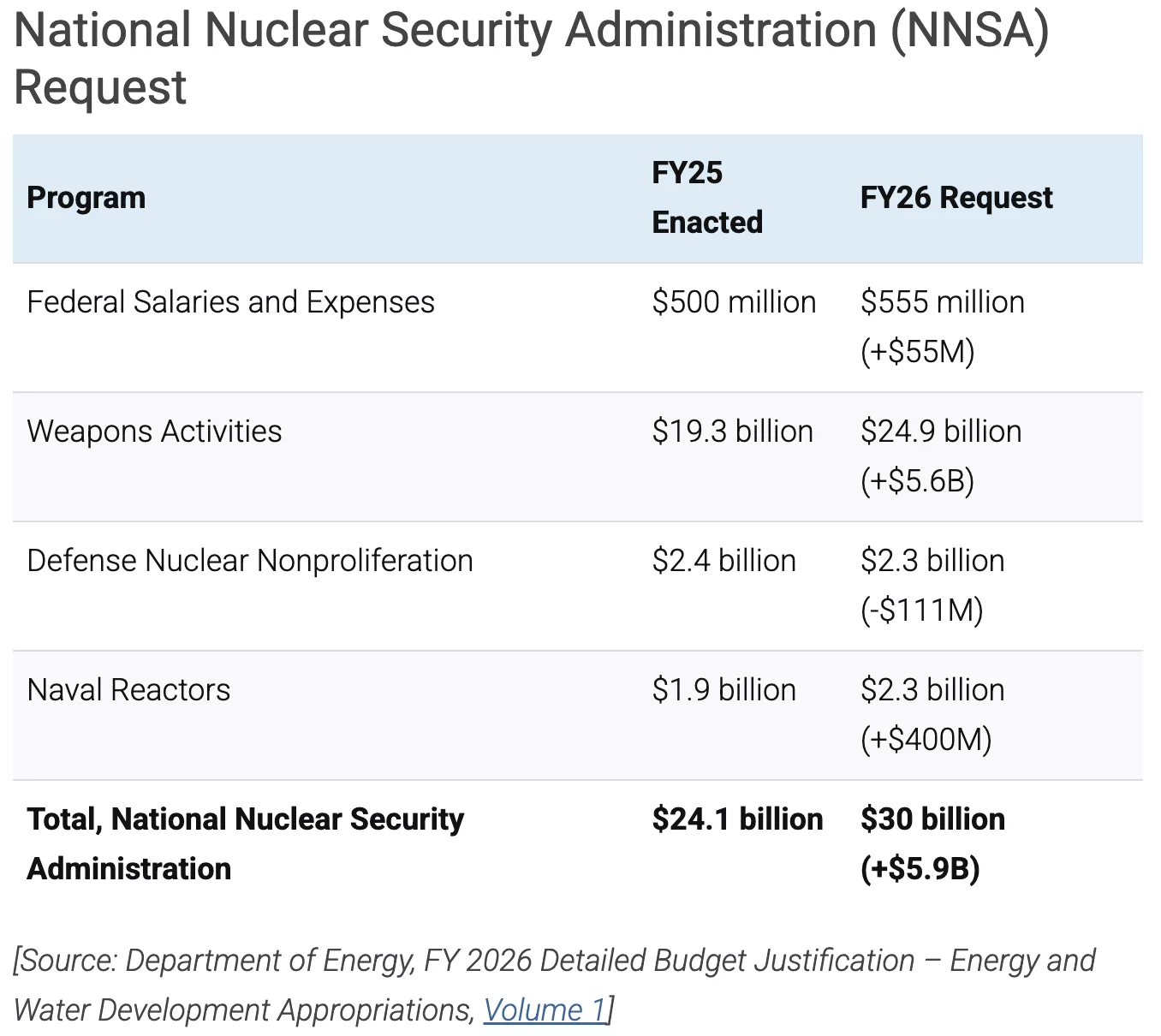
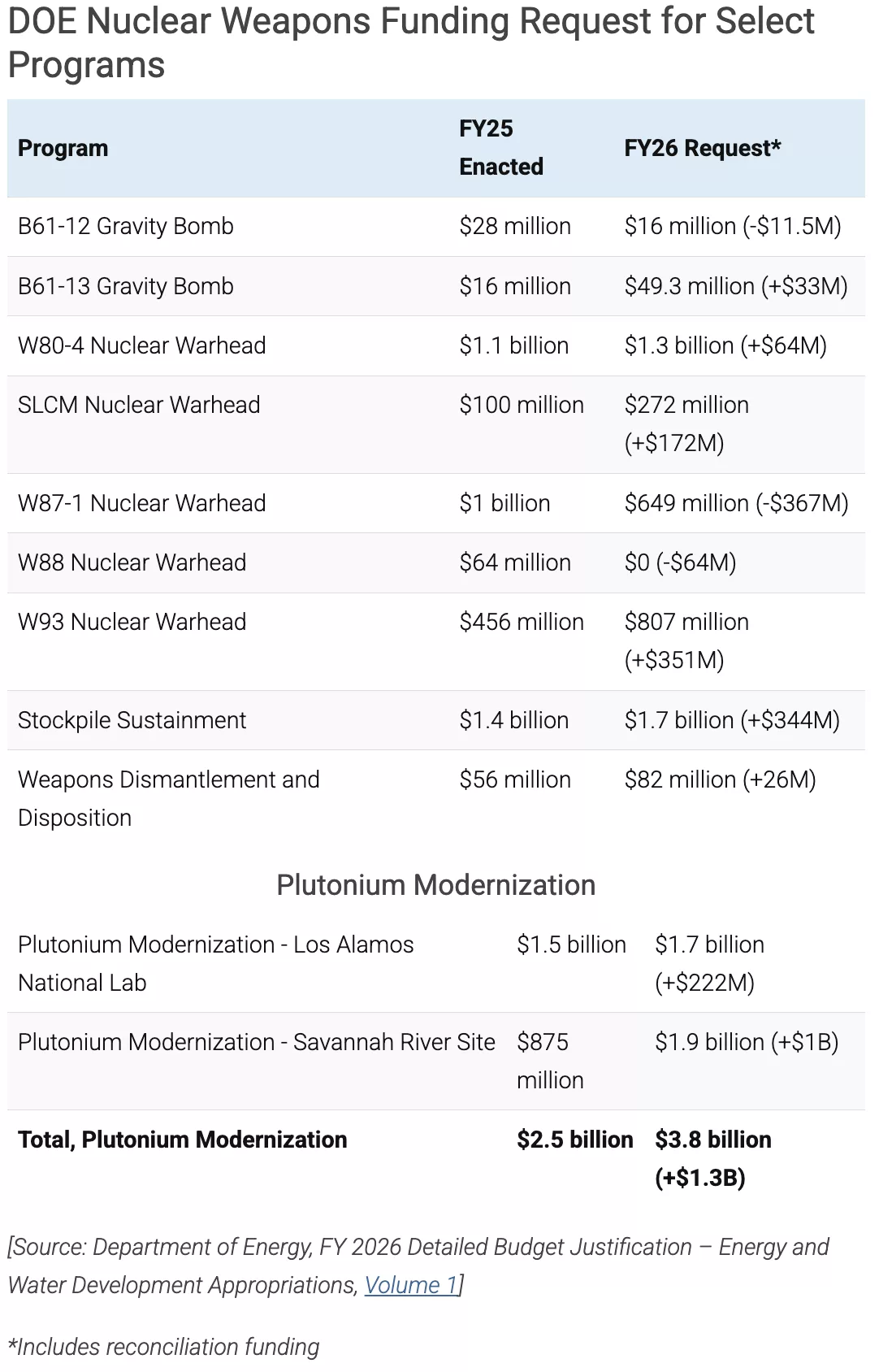 Note: the + or – signs result from the “reconciliation” bill.
Note: the + or – signs result from the “reconciliation” bill.
• Radiation Exposure Compensation Act: Sen. Josh Hawley of MO got RECA extension and expansion attached to the bill, which is really something. Tina Cordova of the Tularosa Basin Downwinders Consortium has acknowledged that many deserving people have still been left out. See more: https://www.santafenewmexican.com/news/local_news/new-mexico-downwinders-celebrate-bittersweet-victory-in-trumps-big-beautiful-bill/article_9dc4ae5e-d4d0-4689-a255-a83576076963.html Finally, it is good for only two years because it was part of budget “reconciliation” that is supposed to deal only with funding matters (hence is limited to this 2-year term of Congress). We will continue to fight to get RECA permanently extended and expanded.
Nuclear Weapons Update:
The manufacture of new pits has more to do, as per the last Nuclear Posture Review (NPR), with preserving and “modernizing” the infrastructure than it does with the warheads themselves. This is in essence a huge continuing program of institutional preservation that guarantees large inflows of taxpayer dollars and corporate profits.
Further, we are talking about W87-1 pits for the new Sentinel intercontinental ballistic missile, which is already 80% over budget before the Air Force admitted it had to build new silos. Moreover, the reported production of ~800 plutonium pits when there are only to be 400 fielded Sentinels may lead to the uploading of multiple warheads per missile (AKA MIRVing for Multiple Independently-targeted Reentry Vehicles). This is regarded as deeply destabilizing since land-based ICBMs are known fixed targets which encourage pre-emptive strikes and/or use them or lose them scenarios.
Accelerating Arms Race
• The U.S. bombed Iranian hardened, deeply buried uranium enrichment sites with B2s carrying 30,000 lb. conventional bunker busters (32 hours roundtrip from Whiteman AFB in Missouri). The U.S. has rushed produced nuclear B61-13s for this kind of job.
Planned Nuclear Weapons Activities Increase to 84% of Lab’s Budget; All Other Programs Cut

The Department of Energy and Los Alamos National Laboratory have released the LANL congressional budget request for the upcoming fiscal year, 2026, which begins on October 1, 2025. The request shows a continued major increase and expansion of the plutonium pit production program (plutonium pits are the triggers of nuclear weapons). LANL is frantically trying to increase its capabilities to begin making 30 pits per year by 2028.
NukeWatch created the attached chart to give a visual of how taxpayer dollars are annually spent at the Lab. LANL’s FY 2026 total budget request is $6 billion, which is a 17% increase over the FY 2025 $5.2 billion total budget. This includes a 24% increase in the nuclear weapons budget over FY 2025.
Nuclear Weapons Activities represent 84% of LANL’s total budget.
Under the headline of “Unleashing a Golden Era of Energy Dominance and Energy Innovation and Protecting the Nation,” the nuclear weapons budget is increasing dramatically. As a baseline, 65% of the Department’s proposed $46 billion budget is earmarked for its semi-autonomous nuclear weapons agency, the National Nuclear Security Administration (NNSA). In turn, more than 80% of NNSA’s proposed FY 2026 funding is for its nuclear weapons research and production programs, with a 25% funding increase over FY 2025.
Due to so-called “reconciliation” funding, “Total Weapons Activities” increase to just under $30 billion. This adds up to a 53% increase above FY 2025 for the nuclear weapons research and production programs across the country. To help pay for this, national nonproliferation and cleanup programs are being cut by 5%, science by 14%, cybersecurity and emergency response by 25%, and energy efficiency and renewable energy programs by 74%.
Past Work Product (2020-2021)
Groups Fire Back at Feds’ Move to Dismiss Plutonium Pit Lawsuit
Federal agencies continue to reject a full review of the public safety and environmental risks of producing nuclear bomb cores at multiple DOE sites.
Jay Coghlan, director of Nuclear Watch New Mexico, commented, “The government has yet to explain to American taxpayers why it will spend more than $50 billion to build new plutonium pit bomb cores for new-design nuclear weapons when we already have thousands of existing pits proven to be reliable for a century or more. This has nothing to do with maintaining the safety and reliability of the existing stockpile and everything to do with building up a new nuclear arms race that will threaten the entire world.”
SRS WATCH / EIN PRESSWIRE October 26, 2021
AIKEN, SOUTH CAROLINA — Public interest groups shot back at the U.S. Department of Energy and the National Nuclear Security Administration’s attempt to suppress a lawsuit seeking a comprehensive environmental review of the agencies’ plans to produce large quantities of nuclear bomb cores, or plutonium pits, at DOE sites in New Mexico and South Carolina.
Expanded Plutonium “Pit” Bomb Production Rules Over Genuine Cleanup Los Alamos Lab Plans to Make Existing Nuclear Waste Dumps Permanent Without Eliminating Threat to Groundwater
The Department of Energy (DOE) has submitted a report to the New Mexico Environment Department (NMED) declaring its preferred plan to “cap and cover” radioactive and toxic wastes at one of the Los Alamos National Laboratory’s (LANL’s) oldest dumps. DOE’s $12 million cleanup-on-the-cheap plan for Material Disposal Area C will create a permanent nuclear waste dump above our regional groundwater. In contrast, DOE has asked Congress for one billion dollars for expanded plutonium “pit” bomb core production at LANL for fiscal year 2022 alone.
LANL used to falsely claim that groundwater contamination was impossible and even asked NMED for a waiver from even having to monitor for it. We now know that there is extensive groundwater contamination from hexavalent chromium (the carcinogen in the Erin Brockovich movie) and high explosives. Traces of plutonium have been detected 1,300 feet under Area C in regional groundwater monitoring wells. The dump also has a large toxic gaseous plume of industrial solvents known as volatile organic compounds (VOCs) which threatens nearby facilities.
Lawsuit Filed Against Biden Administration Over Nuclear Bomb Core Production Plans
Federal agencies’ refusal to review cross-country expansion of plutonium pit production violates the National Environmental Policy Act and the Administrative Procedures Act, groups say.
AIKEN, S.C. – Today, a coalition of community and public interest groups filed a lawsuit against the U.S. Department of Energy (DOE) and the National Nuclear Security Administration (NNSA). This legal action is prompted by the agencies’ failure to take the “hard look” required by the National Environmental Policy Act at their plans to more than quadruple the production of plutonium pits and split their production between the Los Alamos National Laboratory in New Mexico and the Savannah River Site in South Carolina.
MEDIA ADVISORY – South Carolina Environmental Law Project and Nuclear Watchdogs Hold Virtual Press Conference
WHAT:
Public interest groups will hold a press conference for a major announcement of a forthcoming legal action as the U.S. Department of Energy and the National Nuclear Security Administration forge ahead with plans to drastically expand production of plutonium pits, the cores of nuclear weapons, at the Savannah River Site in South Carolina and the Los Alamos National Lab in New Mexico. The legal action follows previous unanswered requests from the groups to DOE and NNSA as seen in correspondence in February and April.
Following New Mexico Environment Department Lawsuit DOE Dramatically Increases Funding for Los Alamos Lab Cleanup
Santa Fe, NM – The Biden Administration has finally released budget details for Department of Energy (DOE) programs that clean up Cold War contamination and radioactive and toxic wastes. In January the New Mexico Environment Department sued DOE in order to terminate a 2016 “Consent Order” that subordinated cleanup at the Los Alamos National Laboratory (LANL) to the budget that DOE wants, which is increased nuclear weapons production. The Biden Administration has responded by increasing proposed cleanup funding at the Lab by 33% from $226 million in FY 2021 to $333.5 million proposed for FY 2022 (which begins October 1, 2021).
Biden Continues Trump’s Bloated Nuclear Weapons Budget
Will That Change in Future Years?
Santa Fe, NM – In a classic move that discouraged media coverage, the Department of Energy’s semi-autonomous National Nuclear Security Administration (NNSA) released its long delayed FY 2022 Congressional Budget Request around 7:30 pm EST Friday, May 28, at the very beginning of the long Memorial Day weekend.
Nuclear Watch New Mexico strongly opposed the 25% FY 2021 increase that the Trump Administration bequeathed to NNSA’s nuclear weapons programs. That massive increase was originally sold in testimony to Congress as essential to maintaining the nuclear deterrence but later revealed as necessary to cover NNSA cost overruns and blown schedules.[i]
Groups Notify Biden Admin of Impending Lawsuit Over Nuclear Bomb Core Plans
Multi-state coalition says DOE’s plans to massively expand plutonium pit production violate a major environmental law and constitutes an environmental injustice.
Jay Coghlan of Nuclear Watch New Mexico commented, “Instead of maintaining the safety and reliability of the existing nuclear weapons stockpile, NNSA may actually undermine it because all future pit production is for speculative new-design nuclear weapons. This is a colossal and unnecessary waste of taxpayers’ money on top of already wasted taxpayers’ money.”
CHARLESTON, S.C. — A coalition of public interest organizations notified (PDF below) the U.S. Department of Energy (DOE) and the National Nuclear Security Administration (NNSA) urging a comprehensive review of plans to vastly ramp up production of nuclear bomb cores at the Los Alamos National Lab in New Mexico and the Savannah River Site in South Carolina.
In Tuesday’s letter to department officials, the groups say this lack of review violates the National Environmental Policy Act (NEPA) and would saddle already-burdened communities nearby the two DOE sites with significant quantities of toxic and radioactive waste, contravening President Biden’s executive order of making environmental justice a part of the mission of every agency.
Local Governments Should Leave the Regional Coalition of LANL Communities
Summary: Local governments get little in return for being members of the Regional Coalition of LANL Communities (RCLC). That is because the Coalition is ineffective, dysfunctional, wastes taxpayers’ money and stands in the way of genuine, comprehensive cleanup at the Los Alamos National Laboratory. The RCLC was created to serve the interests of the Department of Energy and Los Alamos County, both of whom strongly support expanded plutonium pit production for new nuclear weapons and supply 80% of the Coalition’s funding. The Regional Coalition brings no discernible economic benefit to local governments other than already rich Los Alamos County because the Lab’s presence is an economic net loss to them. Local governments should not put their time and money into the Coalition. Instead, their constituents would be better served if local governments left the coalition and advocated for comprehensive cleanup that would permanently protect the environment while providing hundreds of high paying jobs.
Background
In 2011 the Department of Energy pulled promised funding from the Community Involvement Fund administered by the New Mexico Community Foundation that supported independent, often critical citizen and tribal analyses of DOE cleanup programs. At the same time DOE began funding the Regional Coalition of LANL Communities modeled on earlier alliances with local governments around the Rocky Flats Plant near Denver, CO and the Mound Plant, near Mound, OH.
New Mexico Environment Department Takes Legal Action To Terminate Defective LANL Cleanup “Consent Order”
FOR IMMEDIATE RELEASE, February 25, 2021
The New Mexico Environment Department has announced that it is filing a lawsuit against the Department of Energy to terminate a “Consent Order” governing cleanup at the Los Alamos National Laboratory (LANL). Nuclear Watch New Mexico, which has fought against that Consent Order ever since it went into effect nearly five years ago, strongly supports and applauds NMED’s decision.
Much to its credit, in 2005 the State of New Mexico successfully compelled DOE to enter into a strong, enforceable Consent Order after years of tough negotiations and lawsuits brought against it by DOE and the University of California (then LANL’s manager). However, at the Lab’s request the anti-regulation Susanna Martinez Administration eviscerated that Consent Order with more than 150 milestone extensions.
Los Alamos Nuclear Weapons Lab Opens Office in the City of the Santa Fe (“Holy Faith”) of Peace and Environmental Protection
FEBRUARY 10, 2021
Santa Fe, NM – A Lab press release has announced that “[c]onnections between Los Alamos National Laboratory and the City of Santa Fe will be strengthened with the Laboratory’s opening of a new downtown office” after signing a 10-year lease on a 28,000-square-foot building. The Lab’s press release ignores LANL’s $2.9 billion nuclear weapons production budget (up 33% in one year), its proposed 46% cut to cleanup to $120 million, serious groundwater contamination and recent reports how it has neglected wildfire protection. Two catastrophic wildfires in the last 21 years on or near the Lab blanketed a large portion of northern New Mexico with possibly contaminated smoke.
The City of Santa Fe’s official name is the “La Villa Real de la Santa Fe de San Francisco de Asís” (“The Royal Town of the Holy Faith of Saint Francis of Assisi”), in honor of the beloved saint who preached peace and environmental protection and from whom the present Pope draws his name. Pope Francis has repeatedly called for the abolition of nuclear weapons and while in Japan paid homage to the victims of the Hiroshima and Nagasaki bombings. Those atomic bombs were designed and produced at the Los Alamos Lab.
LANL Falls Behind on Wildfire Protection While Expanding Nuclear Weapons Production Watchdog Calls for New Site-Wide Environmental Impact Statement
FEBRUARY 9, 2021
Santa Fe, NM – The Department of Energy’s Inspector General is reporting that the Los Alamos National Laboratory (LANL) is falling seriously behind in wildfire protection. This is despite the fact that the 2000 Cerro Grande Fire forced the mandatory evacuation of both LANL and the Los Alamos townsite, burned 3,500 acres of Lab property and came within a half-mile of Area G, its largest waste dump. At the time Area G stored above ground some 40,000 barrels of plutonium-contaminated radioactive wastes. It could have been catastrophic had they burst and sent respirable airborne plutonium across northern New Mexico (inhaled plutonium is a very serious carcinogen).
In 2011 the Los Conchas Fire raced 13 miles in 24 hours to the Lab’s western boundary, where it was stopped along State Highway 4. Both it and the Cerro Grande Fire sent huge plumes of harmful smoke across northern New Mexico, possibly carrying Lab contaminants as well (operation of radioactive air emissions monitoring equipment was suspended during the Cerro Grande Fire).
Nuclear Watch New Mexico’s Critique of Some NNSA Answers to Questions on LANL’s Planned Tritium Releases
November 4, 2020
The Los Alamos National Laboratory (LANL) proposes to vent up to 114,000 curies of radioactive tritium gas to the open atmosphere while claiming that it poses no public health and safety risks. Public outcry and congressional pressure prompted the National Nuclear Security Administration (NNSA) to host a public information virtual meeting on this issue on October 20. Due to the overwhelming turnout of some 150 interested citizens and ear-splitting technical difficulties NNSA is holding another public virtual meeting at 5:00 pm Thursday November 5.
Interested citizens can join the discussion at https://www.lanl.gov/environment/flanged-tritiumwaste-containers.shtml
If you wish to speak or ask questions you should pre-register at the same site.
DOE Issues Controversial Decision to Pursue a Plutonium Bomb Plant (PBP) at Savannah River Site (SRS); Inadequate Environmental Review and Lack of Justification for Production of 50 or More “Pits” per Year to Modernize Entire Nuclear Weapons Stockpile Open to Legal Challenge
November 5, 2020
The U.S. Department of Energy (DOE) today issued a formal decision that it will pursue a massive Plutonium Bomb Plant (PBP) at the DOE’s Savannah River Site (SRS) in South Carolina, in order to produce plutonium “pits,” or cores, for nuclear warheads. The provocative decision, which adds fuel to concerns about a new nuclear arms race with Russia and China, drew immediate opposition from public interest groups near DOE sites in South Carolina, New Mexico and California.
The issuance by DOE’s National Nuclear Security Administration (NNSA) of the “Record of Decision” (ROD) on the Environmental Impact Statement (EIS) on pit production at SRS, issued in late September, officially affirms the “preferred alternative” that DOE intends to produce a minimum of 50 plutonium “pits” per year by 2030 at SRS. Also on November 5, NNSA issued an “Amended Record of Decision” (AROD) to its 2008 nation-wide Complex Transformation Programmatic Environmental Impact Statement that incorporated its SRS pit-production decision.
Scoping Comments on the LLNL SWEIS
October 21, 2020
Ms. Fana Gebeyehu-Houston
NEPA Document Manager
National Nuclear Security Administration
Lawrence Livermore National Laboratory
P.O. Box 808, L-293, Livermore, CA 94551-0808
By Email to:LLNLSWEIS@nnsa.doe.gov
Re: Scoping Comments on the LLNL SWEIS
Dear NEPA Document Manager:
I appreciate this opportunity to submit comments on the scope of the National Nuclear Security Administration’s (NNSA) Site-Wide Environmental Impact Statement (SWEIS) for the continued operation of the Lawrence Livermore National Laboratory (LLNL) Main Site in Livermore, CA and Site 300 high explosives testing range near Tracy, CA.
Nuclear Watch New Mexico is a nonprofit watchdog organization based in Santa Fe, New Mexico. We seek to promote safety and environmental protection at nuclear facilities; mission diversification away from nuclear weapons programs; greater accountability and cleanup in the nation-wide nuclear weapons complex; and consistent U.S. leadership toward a world free of nuclear weapons.
Pursuant to the National Environmental Policy Act the purpose of scoping is: “early identification of concerns, potential impacts, relevant effects of past actions and possible alternative actions.” Therefore, I ask that the analyses I am requesting be fully undertaken – and my questions fully answered – in the draft SWEIS.
First, I am skeptical of the timing of the initiation of this new SWEIS for LLNL during the COVID-19 pandemic and just before the November 3 election. As a prerequisite, the
National Nuclear Security Administration (NNSA) should have already begun a nationwide programmatic environmental impact statement (PEIS) on expanded plutonium pit
production which would then inform the LLNL SWEIS of the Livermore Lab’s role in that national effort, which is not insignificant. Following that pit production PEIS, both a
LLNL and Los Alamos National Laboratory SWEIS should proceed in parallel. It is particularly striking that NNSA is claiming NEPA compliance while relying on an
outdated Complex Transformation Supplemental PEIS and LANL SWEIS, both completed in 2008, and refusing to prepare new or supplemental ones.
Non-Governmental Organizations Demand Resumption of Los Alamos Nuclear Bomb Plant Public Information Meetings
The NGOs request that the semi-annual public meetings resume by early fall 2020, and the CMRR Project website be updated and maintained until the RLUOB reconfiguration and PF-4 upgrades are completed. All documents and presentations from the previous 13 public meetings must be reposted. The NGOs are also asking that the unilateral decision by the DOE/National Nuclear Security Administration (NNSA) to increase the amount of plutonium equivalent allowed in the RLUOB from 8.4 grams to 400 grams be reviewed by NMED.
Los Alamos Lab Suppresses Data on Negative Economic Impact on Surrounding Counties; Wealthy White Los Alamos County Asks for 3,000 Acres Seized from Hispanics and Native Americans
“This is yet another example of the racial disparity that exists in the wake of communities like Los Alamos, established under the protective umbrella of government sanctioned white privilege. When you take something by force and don’t pay for it, that’s called stealing. So why is land stolen by the US government from the original Hispanic and Native American owners not being given back to them?…As the national reckoning over racial injustice unfolds, let us not forget how Los Alamos Lab came to be and the insult to injury that giving away land stolen from others represents.”
— Chuck Montaño, Nuclear Watch NM Steering Committee member. Mr. Montaño, born and raised in Santa Fe, NM, worked at the Los Alamos National Laboratory for 32 years where he investigated allegations of fraud, waste and abuse.
WATCHDOG GROUPS FILE LEGAL PETITION WITH ENERGY DEPT: Allege Agency is Slow Walking “Record of Decision” Re: Plutonium Bomb Core Production to Prevent Judicial Review; Stage Set for Litigation on Expanded Production

“DOE and NNSA appear to be deliberately slow-walking the issuance of a formal Record of Decision on expanded plutonium pit production in an apparent effort to prevent the federal courts from reviewing the agencies’ failure to comply with the National Environmental Policy Act.”
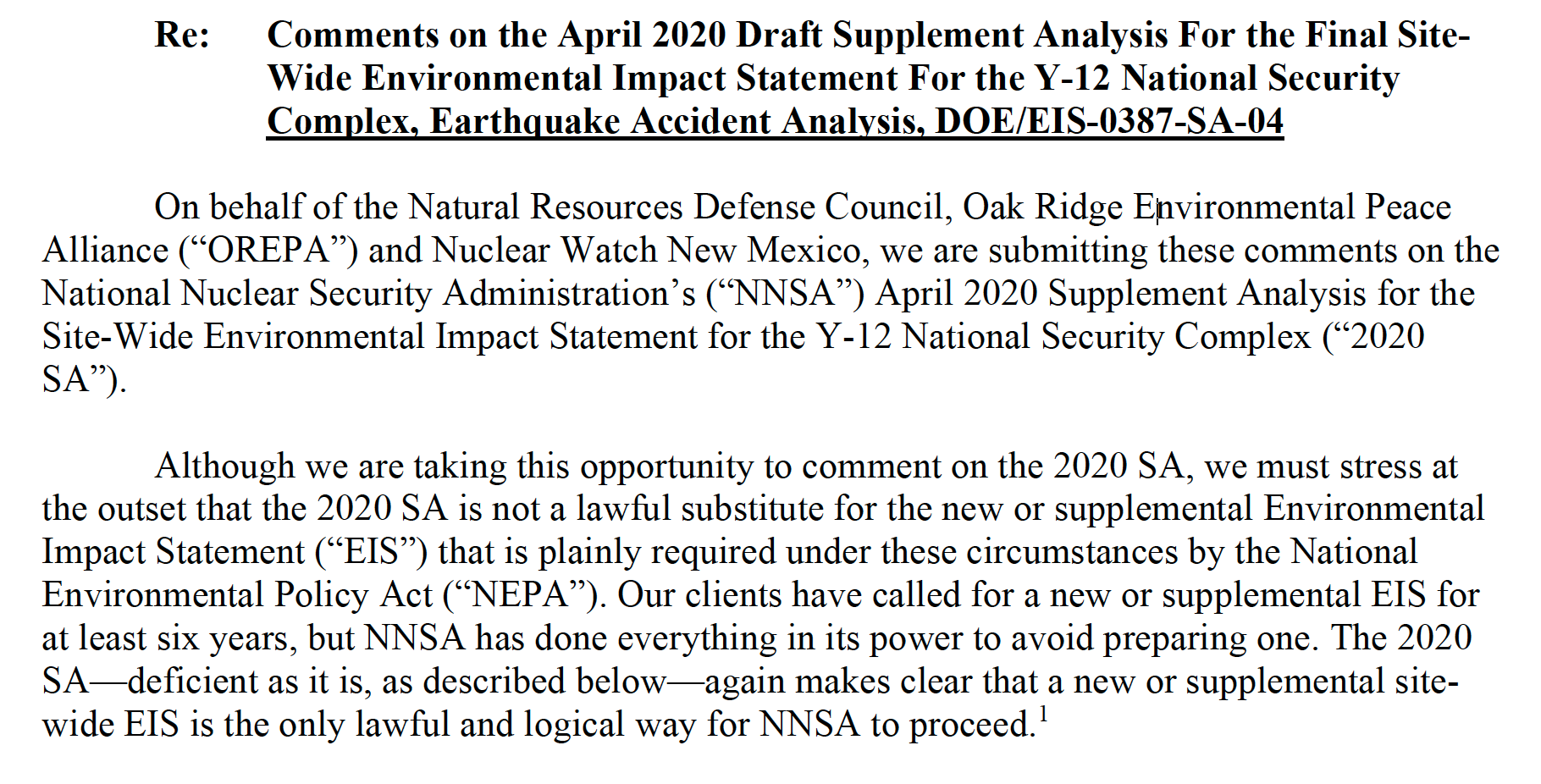
COLLECTIVE COMMENTS: on the National Nuclear Security Administration’s (NNSA’s) Draft Supplement Analysis of the 2008 Site-Wide Environmental Impact Statement for the Continued Operation of Los Alamos National Laboratory (LANL) for Plutonium Operations
These comments were signed onto by over 100 individuals and organizations.
THANK YOU to all those who participated!
75TH ANNIVERSARY HIROSHIMA DAY ONLINE COMMEMORATION CALLING FOR THE ABOLITION OF NUCLEAR WEAPONS
August 6, 2020
"Jay Coghlan of Nukewatch.org on the history of the Los Alamos labs, where the bomb was designed and fabricated, and how it continues to play the leading role in the creation of most U.S. nuclear weapons since then."
| 2019
November 26, 2019 Press Release November 24, 2019 Press Release November 19, 2019 Plutonium Pit Production Workshop Presenters:
August 12, 2019 NEPA Comments NukeWatch’s 22-page formal comments on expanded plutonium pit production Until NNSA fully complies with the National Environmental Policy Act through the preparation of a programmatic environmental impact statement on expanded plutonium pit production, Nuclear Watch believes that any irreversible or irretrievable commitment of resources to either the expansion of pit production at the Los Alamos Lab or to the repurposing of the MOX Facility at the Savannah River Site is unlawful. Read/Download the Full Document HERE July 25, 2019 NEPA Comments Scoping comments on NNSA draft EIS for plutonium pit production at the Savannah River Site THE NEED FOR A PROGRAMMATIC ENVIRONMENTAL IMPACT STATEMENT: This is our first and primary concern, that NNSA must first complete a programmatic environmental impact statement (PEIS) on its nation-wide plans for plutonium pit production, in advance of the Savannah River Site-specific environmental impact statement. To get right to the point, we argue that the SRS EIS process should go no further than this scoping period and should resume only after a completed formal Record of Decision for a new or supplemental PEIS. Read/Download the Full Document HERE July 9, 2019 Plutonium Pit Production Fact Sheet Expanding Nuclear Pit Production: The Facts and What You Can Do The Facts Read/Download the Full Document HERE June 10, 2019 News Release In a victory for transparency and legal compliance by the government, the U.S. Department of Energy’s National Nuclear Security Administration (NNSA) today published a “Notice of Intent” in the Federal Register to complete environmental reviews on its controversial proposal to expand plutonium “pit” production for new and refurbished nuclear weapons. [embeddoc url="https://nukewatch.org/wp-content/uploads/2019/06/SRS-plutonium-bomb-plant6-14-19.pptx" download="all" viewer="google"] Read/Download the Full News Release HERE June 4, 2019 Press Release On behalf of three public interest organizations - Nuclear Watch New Mexico, Tri-Valley Communities Against a Radioactive Environment and Savannah River Site Watch – attorneys for the law firm of Meyer Glitzenstein & Eubanks and the Natural Resources Defense Council recently sent a 16-page letter to Lisa Gordon-Hagerty, head of the National Nuclear Security Administration (NNSA). The detailed letter warns the nuclear agency to not proceed with aggressive plans to expand plutonium pit production without first meeting its legal requirements for timely public review and comment under the National Environmental Policy Act. Read/Download the Full Press Release HERE May 31, 2019 Press Release Last Wednesday, facility operations personnel entered a service room and noticed a leak emanating from a valve on the radioactive liquid waste (RLW) system. Upon subsequent visual inspection by a radiological control technician, RLUOB engineers believe that this valve, and 6 similar valves, may be constructed of carbon steel. The RLW system handles radioactive liquid waste streams from chemistry operations that include nitric and hydrochloric acids—carbon steel valves would be incompatible with these solutions. The suspect valves are also in contact with stainless steel piping, which would create another corrosion mechanism. RLUOB management plans to drain the affected piping sections and develop a work package to replace all of the suspect valves. They will also confirm the valve materials and if shown to be incorrect, investigate the cause of this failure in the design, procurement, and installation processes. The valves were installed in 2013 as part of a modification to add straining and sampling capabilities that were not in the included in the original design. [Please note that DNFSB reports are posted a few weeks later than dated.] This immediately raises two crucial issues: 1) the National Nuclear Security Administration’s (NNSA’s) plans for expanded plutonium pit production; and 2) the current attempt by the Department of Energy to restrict Safety Board access to its nuclear weapons facilities. Read/Download the Full Press Release HERE April 26, 2019 Consent Orders Comparison On March 1, 2005, after arduous negotiations and threats of litigation, the New Mexico Environment Department (NMED), Department of Energy (DOE), and Los Alamos National Laboratory (LANL) entered into a Consent Order specifying the schedule for investigation and cleanup of the Lab’s hundreds of contaminated sites. This Consent Order (CO) was LANL’s agreement to fence-to-fence cleanup of Cold War legacy wastes, which NMED began to enforce. Read/Download the Full Comparison HERE March 25, 2019 Press Release More than 25 years after the end of the Cold War, all eight established nuclear weapons powers are “modernizing” their stockpiles. Talks have broken down with North Korea, the new nuclear weapons power. Nuclear-armed India and Pakistan narrowly averted war last month. Russian President Vladmir Putin made new nuclear threats in response to Trump’s announced withdrawal from the Intermediate-Range Nuclear Forces Treaty. This could lead to hair-trigger missile emplacements in the heart of Europe and block extension of the New Strategic Arms Reduction Treaty with Russia. If so, the world will be without any nuclear arms control at all for the first time since 1972. Meanwhile, the U.S. criticizes non-weapons states for signing a nuclear weapons ban treaty, despite the fact there have long been treaties completely banning chemical and biological weapons of mass destruction that the U.S. seeks to enforce. The pending international NonProliferation Treaty (NPT) Preparatory Committee conference at the United Nations is widely expected to collapse in failure because of the nuclear weapons powers’ failure to enter into serious negotiations leading to nuclear disarmament. The NPT’s Article VI mandate for those negotiations has been in effect since 1970, when the Treaty was signed by 189 countries (more than any other treaty). Read/Download the Full Press Release HERE March 26, 2019 NukeWatch Budget Compilation Nuclear Watch New Mexico — Department of Energy FY 2020 Nuclear Weapons Budget Request |
| 2018
November 16, 2018 Plutonium Pit Production Fact Sheet Plutonium pits are the radioactive cores or “triggers” of nuclear weapons. Their production has always been a chokepoint of resumed industrial-scale U.S. nuclear weapons production ever since a 1989 FBI raid investigating environmental crimes shut down the Rocky Flats Plant near Denver. In 1997 the mission of plutonium pit production was officially transferred to its birthplace, the Los Alamos National Laboratory (LANL) in northern New Mexico, but officially capped at not more than 20 pits per year. However, in 2015 Congress required expanded pit production by 2030 whether or not the existing nuclear weapons stockpile actually needs it. This will support new military capabilities for nuclear weapons and their potential use. Read/Download the full fact sheet pdf HERE October 31, 2018 Nuclear Watch New Mexico, Savannah River Site Watch, and Tri-Valley CAREs sent a letter of demand to the U.S. Department of Energy’s National Nuclear Security Administration (NNSA) to inform the government that its plan to quadruple the production rate of plutonium bomb cores is out of compliance with the National Environmental Policy Act (NEPA). NNSA’s premature plan to quadruple the production rate of plutonium bomb cores (“pits”), the heart of all US nuclear weapons, is out of compliance with requisite environmental law, the groups argue, as NNSA has failed to undertake a legally-mandated programmatic review and hold required public hearings. View/Download the entire press release HERE NukeWatch Comments, September 27, 2018 Nuclear Watch New Mexico is submitted formal comments to express in the strongest possible terms our opposition to DOE Order 140.1 Interface with the Defense Nuclear Facilities Safety Board. We find that the Department of Energy’s (DOE’s) attempt to restrict and suppress DNFSB access is very misguided, arrogant, and likely illegal in that it acts contrary to the Board’s enabling legislation. June 8, 2018 Press Release New Contractors Selected For Expanded Nuclear Weapons Production at Los Alamos Santa Fe, NM. Today the Department of Energy's National Nuclear Security Administration (NNSA) announced its choice for the new management and operating contract for the Los Alamos National Laboratory (LANL).The new contractor, Triad National Security, LLC, is a limited liability company consisting of the Battelle Memorial Institute, the University of California and Texas A&M University. All three are non-profits, and it is unclear how this will affect New Mexico gross receipts taxes. Battelle claims to be the world's largest non-profit technology research and development organization, and manages a number of labs including the Lawrence Livermore and Idaho National Laboratories. Texas A&M was founded in 1876 as the state's first public institution of higher learning and has the largest nuclear engineering program in the country. DOE Secretary Rick Perry is an avid A&M alumnus. May 31, 2018 Press Release Santa Fe, NM & Columbia, SC - "Two key U.S. Department of Energy documents on future production of plutonium "pits" for nuclear weapons, not previously released to the public, fail to justify new and upgraded production facilities at both the Los Alamos National Laboratory (LANL) in New Mexico and the Savannah River Site (SRS) in South Carolina." May 15, 2018 Fact Sheet May 10, 2018 Press Release What's Not in NNSA's Plutonium Pit Production Decision
- NNSA did not mention that up to 15,000 "excess" pits are already stored at the Pantex Plant near Amarillo, TX, with up to another 5,000 in "strategic reserve." The agency did not explain why new production is needed given that immense inventory of already existing plutonium pits. (In 2006 independent experts found that pits last a least a century. Plutonium pits in the existing stockpile now average around 40 years old.) May 2, 2018 Press Release "NNSA should begin nation-wide review of plutonium pit production, why it's needed, and what it will cost the American taxpayer in financial, safety and environmental risks. These are all things that the public should know." -Jay Coghlan, Director, Nuclear Watch New Mexico. April 26, 2018 NukeWatch Comments LANL Rad Lab: Formal Comments Under Nat'l Environmental Policy Act Against raising plutonium limit at LANL Rad Lab View/download Nuclear Watch comments as submitted Excerpt:
- NNSA is planning a 10-fold increase in plutonium at the LANL Rad Lab with a view to ramping up the production of plutonium pits for new nuclear weapons. March 26, 2018 Press Release United States To Begin Construction Of New Nuclear Bomb Plant The National Nuclear Security Administration (NNSA) announced on Friday, March 23, that it was authorizing the start of construction of the Uranium Processing Facility (UPF) and two sub-projects at the Y-12 National Security Complex in Oak Ridge, Tennessee. The UPF is a facility dedicated solely to the manufacture of thermonuclear cores for US nuclear bombs and warheads.
Jay Coghlan of NukeWatch points out that "This project already has a long history, and it is instructive. In 2013, DOE announced it was 85% finished with the UPF design when it ran into the 'space/fit' issue- and more than a half-billion taxpayer dollars were just written off. In private business, that kind of thing gets you fired. In DOE's world of contractors running amok, they not only didn't get fired, not one Congressional hearing was held and the UPF budget went up the next year!" - See full press release for all the details (PDF) March 1, 2018 Press Release The Regional Coalition of LANL Communities: Benefits for the Select Few Santa Fe, NM- According to media reports, Andrea Romero, Executive Director of the Regional Coalition of LANL Communities, is accused of charging some $2,200 dollars of unallowable travel costs, such as alcohol and baseball tickets, while lobbying in Washington, DC for additional funding for the Los Alamos National Laboratory (LANL). She in turn accused the nonprofit group Northern New Mexico Protects of political motivations in revealing these questionable expenses. Romero is running in the Democrat Party primary against incumbent state Rep. Carl Trujillo for Santa Fe County's 46th district in the state House of Representatives. For all the details, see full press release PDF February 28, 2018 Press Release Santa Fe, NM. On December 17, 2017, the Department of Energy (DOE) awarded a separate $1.4 billion contract for cleanup at the Los Alamos National Laboratory (LANL) to Newport News Nuclear BWXT-Los Alamos, LLC (also known as "N3B"). This award followed a DOE decision to pull cleanup from LANL's prime contractor, Los Alamos National Security, LLC (LANS), after it sent an improperly prepared radioactive waste drum that ruptured underground at the Waste Isolation Pilot Plant (WIPP). That incident contaminated 21 workers and closed WIPP for nearly three years, costing taxpayers at least $1.5 billion to reopen. (See all the details in the full press release) February 26, 2018 Press Release Detailed NNSA Budget Documents Accelerates Nuclear Weapons Arms Race Santa Fe, NM. Late Friday February 23, the Trump Administration released the detailed FY 2019 budget for the National Nuclear Security Administration (NNSA), the semi-autonomous nuclear weapons agency within the federal Department of Energy. Overall, NNSA is receiving a $2.2 billion boost to $15.1 billion, a 17% increase above the FY 2018 enacted level. Of that, a full $11 billion is for the budget category [Nuclear] "Weapons Activities", 18% above the FY 2018 level. Of concern to the American taxpayer, DOE and NNSA nuclear weapons programs have been on the congressional Government Accountability Office's High Risk List for project mismanagement, fraud, waste and abuse since its inception in 1990... (See all the details in the full press release) February 22, 2018 Press Release Santa Fe, NM. Today the National Nuclear Security Administration announced an Environmental Assessment to increase the amount of plutonium used in the Radiological Laboratory Utility and Office Building (aka the "Rad Lab") at the Los Alamos National Laboratory from 38.6 grams of plutonium-239 equivalent to 400 grams. This 10-fold increase is significant because it will dramatically expand materials characterization and analytical chemistry capabilities in the Rad Lab in support of expanded plutonium pit production for future nuclear weapons designs. It also re-categorizes the Rad Lab from a "radiological facility" to a "Hazard Category-3" nuclear facility. View/Download full press release February 12, 2018 Press Release Trump's Budget Dramatically Increases Nuclear Weapons Work Santa Fe, NM In keeping with the Trump Administration's recent controversial Nuclear Posture Review, today's just released FY 2019 federal budget dramatically ramps up nuclear weapons research and production. January 12, 2018 Press Release Draft Nuclear Posture Review Degrades National Security Yesterday evening the Huffington Post posted a leaked draft of the Trump Administration's Nuclear Posture Review (NPR). This review is the federal government's highest unclassified nuclear weapons policy document, and the first since the Obama Administration's April 2010 NPR. 2017 |
| 2017
December 22, 2017 Press Release New Mexico Environment Department Surrendered to DOE Extortion Santa Fe, NM. The New Mexico State Auditor Office recently questioned whether two settlements between the New Mexico Environment Department and the Department of Energy were in the best interests of New Mexico. That Office noted: (View/download full press release) December 20, 2017 Press Release Los Alamos Hires New Contractor - Starts Cleanup On the Cheap Santa Fe, NM- Today the Department of Energy (DOE) announced the award of the new Los Alamos National Laboratory legacy cleanup contract to Newport News Nuclear BWXT-Los Alamos, LLC. The $1.39 billion contract is for ten years, which works out to $139 million per year... View/download the full press release Public Presentation, December 2, 2017 October 31, 2017 Press Release Today, in Washington, DC, the Congressional Budget Office released its new report, "Approaches for Managing the Costs of U.S. Nuclear Forces, 2017 to 2046". The Congressional Budget Office estimates that the most recent detailed plans for nuclear forces, which were incorporated in the Obama Administration's 2017 budget request, would cost $1.2 trillion in 2017 dollars over the 2017-2046 period: more than $800 billion to operate and sustain (that is, incrementally upgrade) nuclear forces and about $400 billion to modernize them.... Driving this astronomical expense is the fact that instead of maintaining just the few hundred warheads needed for the publicly claimed policy of "deterrence," thousands of warheads are being refurbished and improved to fight a potential nuclear war. This is the little known but explicit policy of the U.S. government! October 27, 2017 Press Release Santa Fe, NM. On the evening of Wednesday October 25, the Santa Fe City Council passed a resolution requesting that the New Mexico Environment Department strengthen the revised Los Alamos National Labs cleanup order to call for additional characterization of legacy nuclear wastes, increased cleanup funding, and significant additional safety training. The resolution also called for the suspension of any planned expanded plutonium pit production until safety issues are resolved. (view/download full press release) October 6, 2017 Press Release Santa Fe, NM. Nuclear Watch New Mexico strongly applauds the awarding of the Nobel Peace Prize to the International Campaign to Abolish Nuclear Weapons (disclosure: NukeWatch is one of ICAN's ~400 member groups around the world). This award is especially apt because the peoples of the world are now living at the highest risk for nuclear war since the middle 1980's, when during President Reagan's military buildup the Soviet Union became convinced that the United States might launch a pre-emptive nuclear first strike. Today, we not only have Trump's threats to "totally destroy" North Korea and Kim Jong-un's counter threats, but also renewed Russian fears of a US preemptive nuclear attack... Generally unknown to the American taxpayer, our government has quietly tripled the lethality of the US nuclear weapons stockpile..." (view/download complete press release) NukeWatch fact sheet, September 26, 2017 The National Nuclear Security Administration's own documents have explicitly stated that expanded pit production would have no significant positive effect on job creation and the regional economy of northern New Mexico. Nuclear Watch argues that expanded plutonium pit production could actually have negative effect if it blocks other economic alternatives such as comprehensive cleanup, which could be the real job producer. Moreover, given LANL's poor safety and environmental record, expanded plutonium pit production could have a seriously negative economic impact on northern New Mexico in the event of any major accidents. September 15, 2017 Press Release Santa Fe, NM. The Los Alamos National Laboratory (LANL) has detected far more hexavalent chromium (Cr) contamination than previously estimated in the "sole source" regional groundwater aquifer that serves Los Alamos, Santa Fe and the Espanola Basin. Sampling in July from a new well meant to inject treated groundwater back into the aquifer detected chromium contamination five times greater than the New Mexico groundwater standard of 50 micrograms per liter (ug/L). View/download the full press release September 11, 2017 Press Release Talking Points: The 2016 LANL Cleanup Consent Order Should Be Rescinded The 2005 LANL Cleanup Consent Order was all about the enforceable schedules. It required DOE and LANL to investigate, characterize, and clean up hazardous and mixed radioactive contaminants from 70 years of nuclear weapons research and production. It stipulated a detailed compliance schedule that the Lab was required to meet. Under Gov. Martinez, NMED Secretary Ryan Flynn granted more than 150 compliance milestone extensions at the Lab's request, effectively eviscerating it. View/download the complete talking points July 20, 2017 Press Release Washington, DC Today, the Oak Ridge Environmental Peace Alliance (OREPA), Nuclear Watch New Mexico, and the Natural Resources Defense Council filed a federal lawsuit to stop construction of the problem-plagued Uranium Processing Facility (UPF) until legally required environmental review is completed. The UPF, located at the National Nuclear Security Administration's (NNSA's) Y-12 production plant near Oak Ridge, TN, is slated to produce new thermonuclear weapons components until the year 2080. The UPF is the tip of the spear for the U.S.'s planned one trillion dollar-plus make over of its nuclear weapons arsenal, delivery systems, and production plants. View/download the full press release June 19, 2017 Press Release Some Background on Plutonium Pit Production at the Los Alamos Lab Santa Fe, NM -The Washington Post has published the first in a series of articles on nuclear safety lapses in plutonium pit production at the Los Alamos Lab. Plutonium pits are the fissile cores of nuclear weapons that when imploded initiate the thermonuclear detonation of modern weapons. By the way, did you know? Plutonium facilities at LANL are- in principle- designed to withstand a serious earthquake of a degree expected to occur only once every 10,000 years. The last serious earthquake near the Lab is believed to have occurred 11,500 years ago. View/download the full press release ANA Report 2017: Accountability Audit May 19, 2017 Press Release SA Preview of Trump's Budget: More Nuclear Bombs and Plutonium Pit Production Santa Fe, NM. "The proposed level of funding for the National Nuclear Security Administration's (NNSA)'s Total Weapons Activities is $10.2 billion, a full billion above what was requested for FY 2017. In March, Trump's "skinny budget" stated NNSA's funding priorities as 'moving toward a responsive nuclear infrastructure', and 'advancing the existing warhead life extension programs'. Read the full press release for all the details. March 28, 2017 ANA workshop at UN Ban Treaty Conference Ban Treaty Conference: Alliance for Nuclear Accountability Panel Discussion March 28, 2017, UN, NYC:
March 2017 Fact Sheet Plutonium Pit Production at LANL (Updated March 2017) February 23, 2017 Press Release Costs Jump in Nuclear Weapons vs. Cleanup; Nuclear Weapons Winning over Environmental Protection Santa Fe, NM. America is at a crossroads, having to choose between an unnecessarily large, exorbitant, nuclear weapons stockpile, and cleanup that would protect the environment and water resources for future generations. Expanded nuclear weapons research and production, which will cause yet more contamination, is winning. Read the full press release for all the details. January 5, 2017 Press Release The National Nuclear Security Administration (NNSA) has publicly released its fiscal year 2016 Performance Evaluation Report (PER) for Los Alamos National Security, LLC (LANS), the for-profit contractor that runs the Los Alamos Lab. The Performance Evaluation Report is NNSA's annual report card on contractor performance, and overall the agency awarded LANS $59 million in profit out of a possible $65 million. The grade was 85% for the incentive part of the award. In 2012 Nuclear Watch New Mexico successfully sued NNSA to ensure that the Performance Evaluation Reports detailing taxpayers funds paid to nuclear weapons contractors are publicly available. In 2016 the NNSA decided to put the LANL management contract out for competitive bid, but granted LANS a contract extension until the end of September 2018. |
Media appearances including radio interviews are listed on the internal Media page
See the NukeWatch Channel at YouTube for our extensive playlists of key videos.
See the Nukewatch Twitter feed
See the Nukewatch Tumblr site
WatchBlog Posts:
Over 200 posts published since 2009. See archives at the WatchBlog
Earlier Work Product items are archived here


